Fine Prints
October 2023
1501
1950
October 2023 1501 1950 Fine Prints Brussels 1 rue aux Laines, 1000 Brussels noemie@agnewsgallery.com London 6 St. James’s Place, London, SW1A 1NP anna@agnewsgallery.com www.agnewsgallery.com

Dear Friends,
Two hundred and thirteen years ago, in 1810, 16-year-old Thomas Agnew (17941871) walked into the Manchester shop of Vittore Zanetti (1770-1855) and became his apprentice. Zanetti, an Italian gilder, picture frame maker, and print dealer, had arrived in Manchester from his native Piedmont in 1803. After seven years of apprenticeship, in 1817, Agnew persuaded Zanetti to take him on as a partner, and the firm changed its name to Zanetti & Agnew. According to one newspaper advertisement, the firm sold mirrors, frames, meteorological instruments, English and old master prints, and antique and modern paintings. The partnership was a success, and in 1828 Zanetti retired to property he found on Lake Maggiore in Italy. The firm became Agnew & Zanetti, with Vittore’s son, Joseph, coming on as a junior partner. In 1835, Joseph left the company to start his own business, also in Manchester. Now under Thomas’s sole leadership, the firm expanded to become one of the country’s leading print dealers and publishers, with framing services still being offered. It was around this time that it also started dealing in contemporary British paintings and old master paintings, with the success we know of today.
In 1851, just two years before the first stock book was used, Thomas Agnew partnered with his sons William and Thomas. The firm, now Thos. Agnew & Sons, traded in old master and modern prints, among other fields, and continued to do so over the century and a half until 1996, when the esteemed Christopher Drake withdrew from the department. Now, after 179 years of activity in this field, and after twenty-seven years of absence from it, Agnews has finally reconnected with its first love: old master and modern prints.
This inaugural catalogue features more than 40 exceptional prints dating from the early 16th to early 20th century. The field of old master prints may be less noisy than that of paintings or drawings these days, but it is incredibly rich and dynamic. The findings of my esteemed colleagues, though few in number worldwide, show that it is possible even today to assemble a collection of remarkable quality and age. This catalogue presents an exceptional opportunity. Many private collectors and museums around the world are actively working to build, expand, and complete their collections with such exceptional works in this essential field of history. It has been fascinating to watch these developments.
As always, our criteria for inclusion are printing quality, state of preservation, and historical interest. But also of paramount importance is the work’s artistic originality: How the image, composition, and subject speak to us; what unique touch and sensitivity the printmaker needed to wield to achieve this emotional impact. Each print in this catalogue holds special meaning for us and was selected with immense excitement. Since space prevents us from introducing each one in detail here, we invite you to explore them fully in the forthcoming pages. We will, however, dwell upon two gems that have especially captured our hearts.
The first – not surprisingly – is Juste de Juste’s Pyramid of six Men. This theatre of full-length figures is a sort of “UFO” in the history of printmaking. What an exceptional and rare print it is! Featuring six athletes (or jugglers, gymnasts, flayers, acrobats, anatomical models, balladeers, wrestlers – whatever you wish to call these naked men of incredible vibrant energy), it is absolutely unique for its time and notable for its extraordinarily free and casual manner. This impression is also in very good condition. Then there is the Self-Portrait by Adam von Bartsch, our forefather in this field. Bartsch was the first to catalogue not just one printmaker, dealer’s stock, or school, but all of printmaking since the 15th century. He formulated fundamental ideas on the cataloguing of prints and was an outstanding representative of a new type of scientist and artist influenced by the Enlightenment.
In memoriam of Mr. Christopher Drake (1947-2023) who contributed to Agnews’ history, and who loved prints as we do.
Let art inspire you.
Eric Gillis
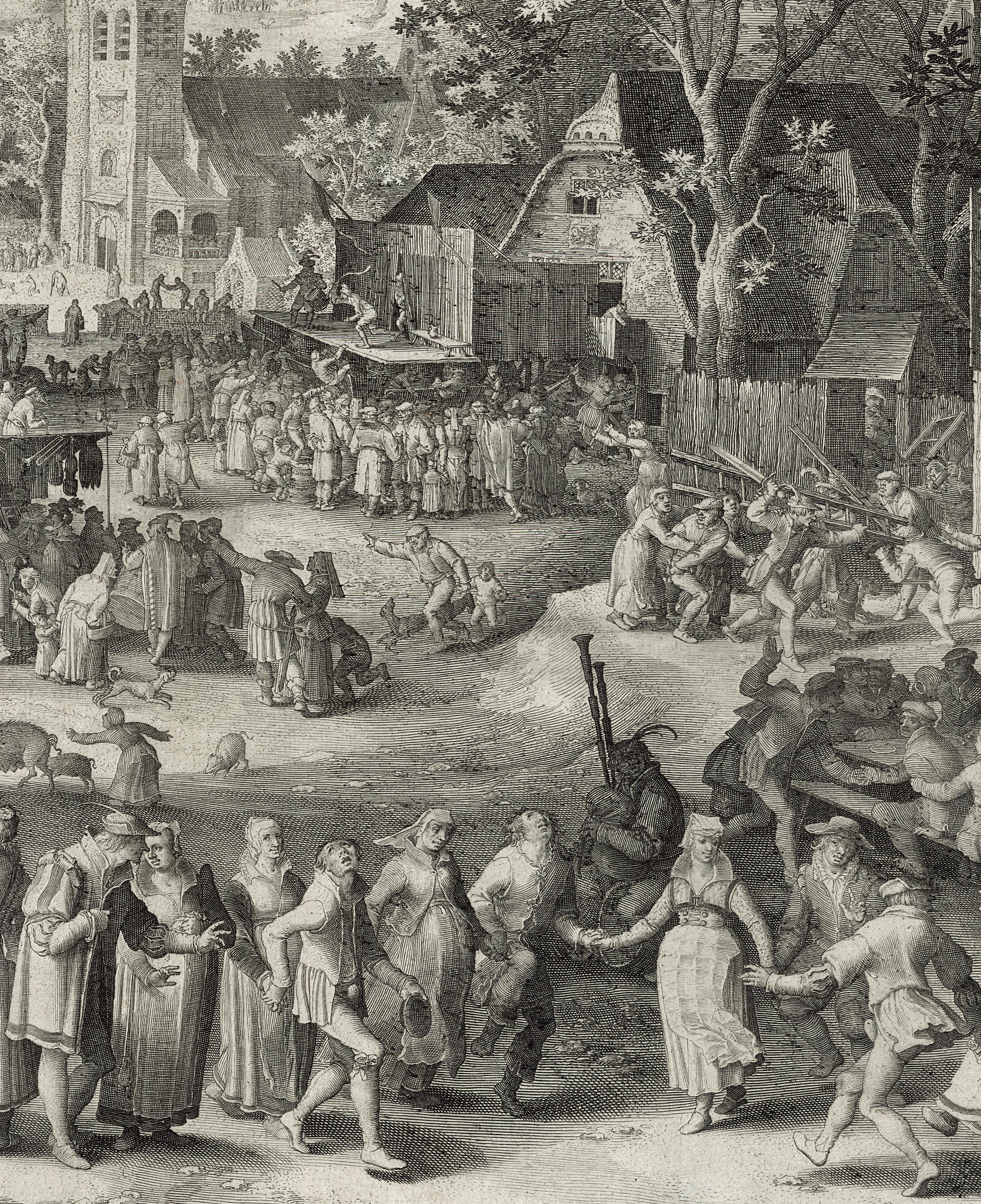
1 Albert Dürer 1471 – Nuremberg – 1528 Nemesis
Engraving on laid paper, ca. 1501–1502
Plate 333 x 229 mm
Watermark High Crown (Meder 20)
Reference Bartsch 77; Hollstein 72; Meder 72 IIa of f; Schoch, Mende, and Scherbaum 33
Provenance Private collection, Sweden
Condition In very fine condition, trimmed
This is an exceptional impression of the second state of the Nemesis, with the accidental scratch that appears beneath the bridge, which must have occurred shortly after the plate was engraved because of the high quality of some impressions bearing it. The present impression is even superior in quality to some other well-known Meder Ia-b impressions. The fine details of the landscape have a crystalline quality, and the burr remaining on the goddess’s wings enhances their texture. It is a true masterpiece.
Dürer titled this print Nemesis in his Netherlands diary. Panofsky identified the literary source for the imagery as “a Latin poem of Politician, Manto (ca. 1485), which synthesises the classical goddess of retribution with fickle Fortune: clad in a white mantle, she hovers in the void, tearing the air with strident wings, driving hither and thither by the gales, and always wielding the goblet and the bridle – symbols of favour and castigation –with contemptuous smile.” Panofsky proposed a second source for the print, which would explain the goddess’s sullen, haughty expression. Pomponius Laetus, a Latin-speaking humanist who founded an academy in Rome around 1460, wrote a Manuel d’histoire romaine, published around 1500, which had previously circulated in manuscript form among the humanists of Nuremberg. One passage refers to Nemesis, Virgo
et Victrix, the victorious virgin who disdainfully turns away from evil and corrupt human affairs to take refuge in the heights of heaven, where she awaits the regeneration of the world in the company of her mother, Night. The term “Victrix” prompted Dürer to depict the goddess as a naked, winged Roman “Victory,” standing in profile on a sphere that symbolises the universality of her dominion.
The plump body of the goddess itself is a far cry from the classical ideal of perfect beauty. Panofsky has established that the figure was constructed according to the only canon of proportion bequeathed to us by Antiquity, that of Vitruvius, of which Dürer was aware in 1500, since the main measurements of the figure correspond exactly to those of the Latin theorist. Some of the curves of the goddess appear to have been drawn with compasses. Yet in some ways, here Dürer is closer to naturalism than to the idealism of Antiquity. The solidity of her body makes one sceptical of her ability to fly.
Dürer was greatly influenced by these Alpine panoramas, and the present landscape, naturalistically treated, can be identified as a view of a Tyrolese town of either Isarco or Chiuso.
6
to or just outside the platemark, but the image is complete.
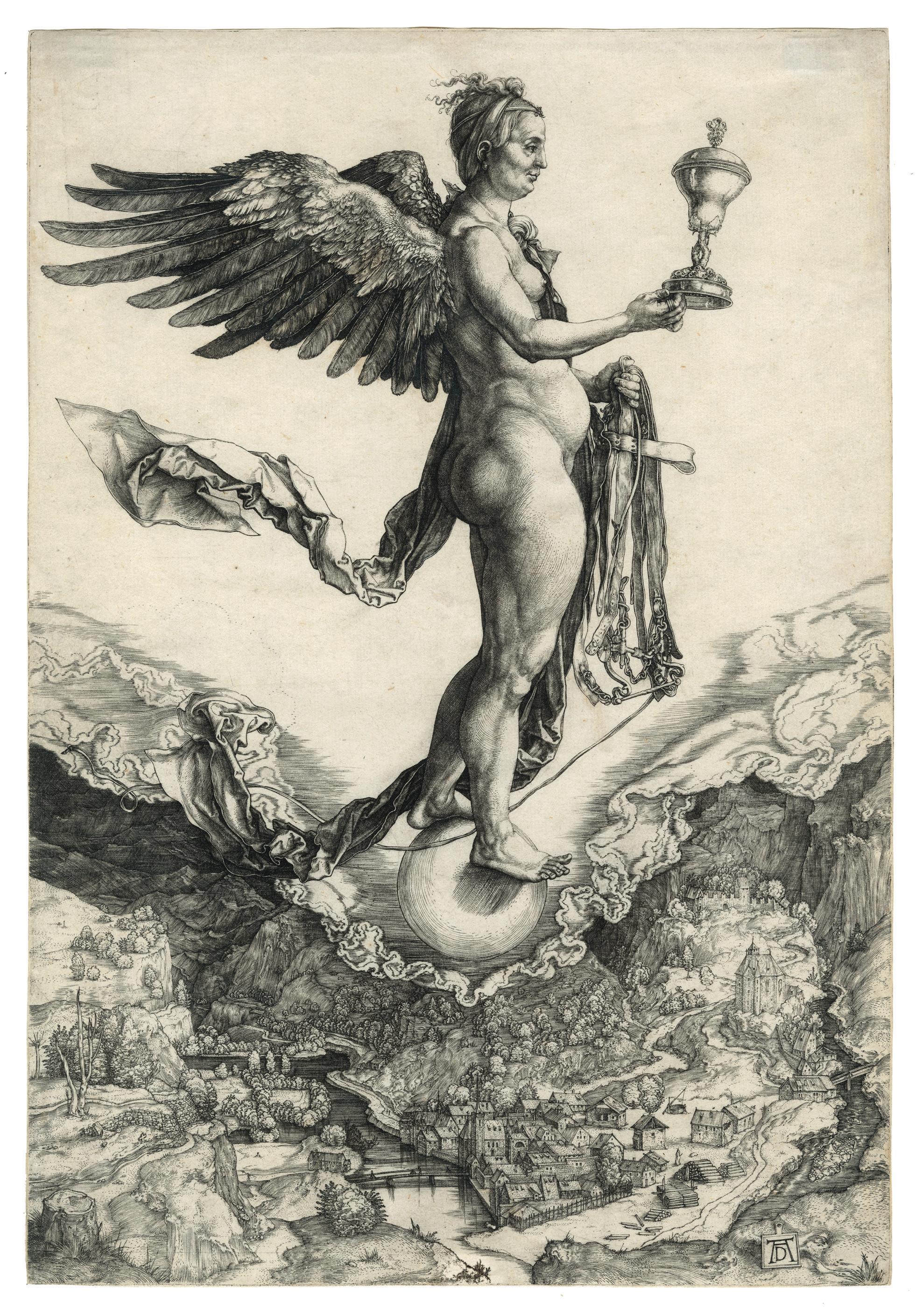
7
2 Lucas van Leyden ca. 1494 – Leiden – 1533
Susanna and the Two Elders
Engraving on laid paper, ca. 1508
Plate 198 x 147 mm
Watermark Gothic P (see New Hollstein p. 286)
Reference Bartsch 33; New Hollstein 33a
Literature Ellen S. Jacobowitz and Stephanie Loeb Stepanek, The Prints of Lucas Van Leyden, & His Contemporaries, exh. cat. National Gallery of Art, Washington, 1983, p. 68, no. 15 (this impression illustrated)
Provenance Paul Prouté, Paris; Private collection, France
This is a very fine, early impression of the Leyden’s Susanna and the two Elders, which Ellen S. Jacobowitz and Stephanie Loeb Stepanek selected for their exhibition at Washington’s National Gallery of Art in 1983, noting the following: “The present engraving is one of the most refined and exquisite of Lucas’ career. In particular, decorative details are carefully observed: the foliage, the collars and cuffs of the drapery, the arch of the bridge, and the city skyline. This extremely fine and precise line-work must have been difficult to ink and wipe. Most impressions have a muddy or heavy appearance in the shadows, caused by ink remaining between the lines. Areas especially susceptible to this problem are the right edge of the hill, the two tree trunks and extended branches, and the dense shadows on the elders’ clothing. The relative absence of these problems here makes this one of the best extant impressions.”
“One of the most striking aspects of this work is the reversal of the subjects’ traditional pictorial format. Generally, Susanna at her bath is the central focus. Here, the scheming elders are the centre of
attention. By placing them on an extremely narrow foreground stage, Lucas emphasized the psychological interchange, drawing the viewer into the composition and practically into their conspiracy. This emphasis on the intense but interactive conversational attitude stresses the conspiratorial rather than erotic aspects of the story; the lascivious glance of the standing elder and the pointed gesture of his seated companion become the only indications of their true intentions. Characteristically, it is not the climax of the narrative that Lucas depicted but a contemplative moment prior to action.
Susanna and the two Elders marks a new direction in Lucas’ development of landscape, whereby his earlier preoccupation with a gradual and continuous recession into depth comes to an end for the moment. Here the three-dimensional space is divided into two distinct stages, neatly separated by the outline of the hill and tree, and further isolated by contrasting lighting effects. This compositional formula will prevail in the engravings without exception until 1517.” (Jacobowitz and Loeb Stepanek, p. 68)
8
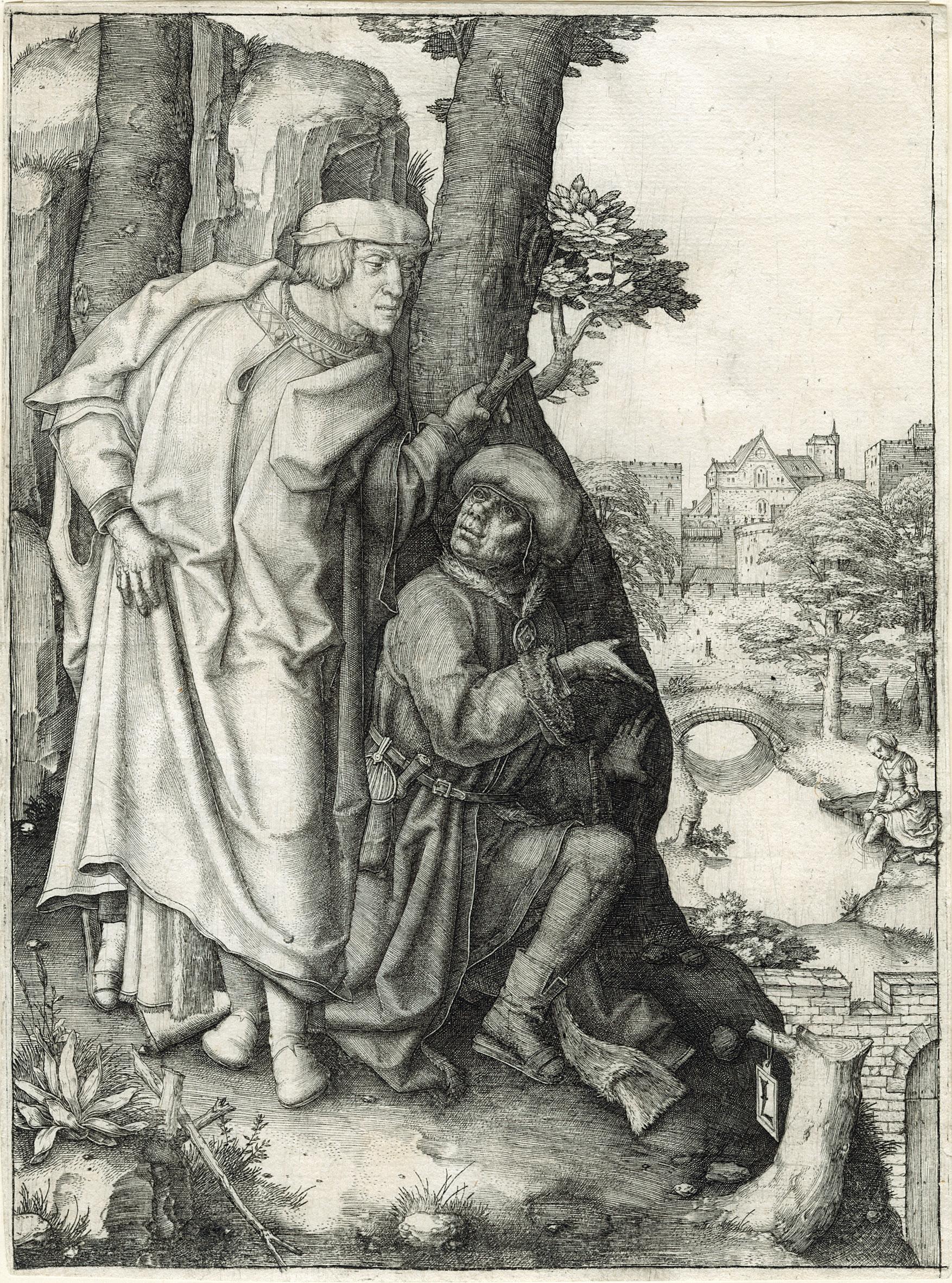
9
3 Albert Dürer 1471 – Nuremberg – 1528
St. Jerome in His Study
Engraving on laid paper, 1514
Plate 249 x 191 mm
Reference Bartsch 60; Hollstein 59; Meder 59a-b of f; Schoch, Mende, and Scherbaum 70
Provenance Private collection, Sweden
Condition In very fine condition, the sheet is very well preserved, with the relief on the back, slightly trimmed on the platemark, but the image is complete.
St. Jerome in His Study is truly an “engraver’s engraving,” a work of unprecedented subtlety. Dürer’s expressive use of linear perspective, already evident by 1511 in the woodcuts, is nowhere used more sensitively than in this engraving of an interior room. Unlike the Knight in the Knight, Death and the Devil, who asserts himself at the frontal plane of the picture, Jerome retreats from the viewer, sitting in the back of the space, as if hoping not to be interrupted in his writing. A human skull, a memento mori, lies on the sunny windowsill, and an hourglass hang next to the cardinal’s hat on the wall behind. The viewer’s entrance via a staircase is hinted at in the foreground, yet access to the study is blocked by the majestic lion from whose wounded foot, according to legend, Jerome had removed a thorn. The lion and a small dog, symbolising fidelity, doze together in the warm sunshine. The three bound volumes shelved on the ample window seat nearby seem to suggest that Jerome’s work as translator has been completed. The enormous gourd hanging from the ceiling further suggests that his Commentaries on the Book of Jonah are also finished, and that he may now be engaged in lengthy debate with St. Augustine. He is indeed writing what appears to be a letter.
In this room, despite the multitude of meticulously described objects, a sense of order and tranquillity prevails. Herbert Friedman has suggested that the peaceable kingdom motif, unique in the iconography of Jerome, may express Dürer’s deep-seated desire for a reconciliation between modern humanistic scholarship and the papacy.
As usual with this plate, it is difficult to judge if we are looking at a Meder a or b. What’s undeniable is that this impression is very good, even very beautiful. There are actually quite a few impressions in public collections that are between Meder a and b. To our knowledge, the only obvious Meder a impressions are held in the collections of the: Albertina (DG1930/151), Boston MFA (M29037), British Museum (1868,0822.185), Cleveland Museum (1972.29), and Art Institute of Chicago (1938.1458). If we compare the present sheet to other Meder a-b impressions, ours is similar in quality with those at the: British Museum (E,4.109), Harvard Museum (G1092), LACMA (M.0212.31), MET (19.73.68), and Rijksmuseum (P-OB-1224). Ours is even (much) better in quality than those at the: Baltimore Museum (1943.32.189), Bibliothèque national de France (RESERVE CA-4 (+,4)), Boston MFA (M37353), Met (33.79.8), and NGA Washington (1949.1.11).
The present sheet is thus a very good impression. The most delicate lines have printed as intended, and each tonal value is well preserved and balanced, from gray to black. The reflection of the light through the mullioned window on the first wall on the left is perfectly rendered; here Meder b prints typically lose definition and clarity. The edges of architectural elements and furniture are neat and well rendered, and the sunlight is well reflected onto the ceiling beams.
10
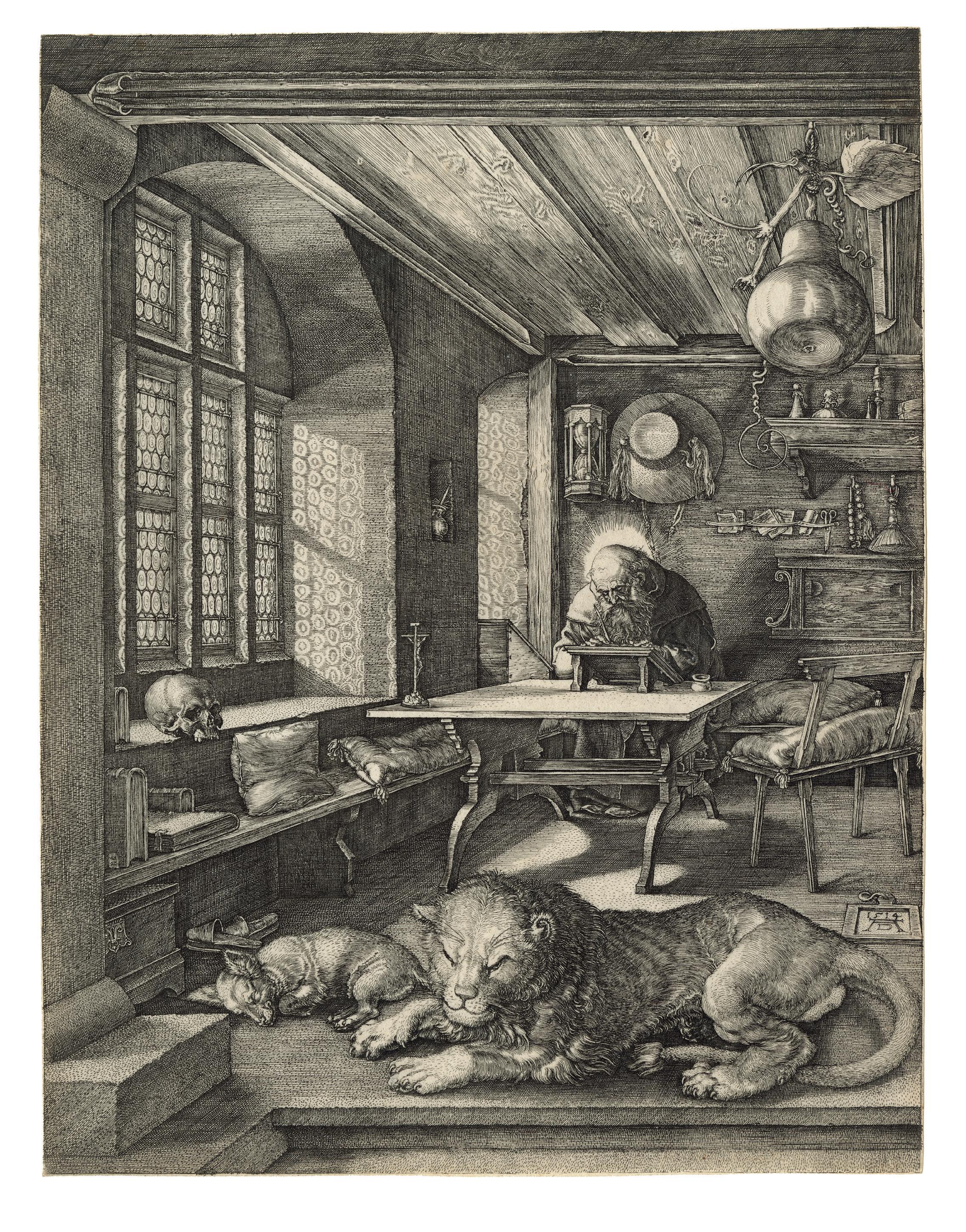
11
Raptus Sabinaro
Engraving on laid paper, 1527
Plate 362 x 502 mm
Watermark Single-circle scale topped by a six-pointed star (Woodward 239)
Reference Bartsch 63, 2nd (final) state
Literature Eugène Carroll, Rosso Fiorentino, National Gallery of Art, Washington DC, 1987, no. 47
Provenance Private collection, Italy
Condition In fine condition
Thought to be Caraglio’s last work, completed after his depiction of the Sack of Rome, this is a very good impression in its final state. The plate is the result of a collaboration between Rosso Fiorentino and Caraglio. Bartsch reported that the composition was to be attributed to Baccio Bandinelli, but Vasari correctly attributed it instead to Rosso. The work’s subject is not the actual rape of the Sabine women, but a later episode recounted by Titus Livius and Plutarch. Here, the Sabines, hoping to redeem themselves, reached Rome and fought in the Forum, while the Sabine women intervened to demand peace. The female figure who sits on a donkey at the centre of the picture would be the goddess Vesta, at whose temple the fight took place.
Caraglio’s career comprises two distinct parts. First, beginning in 1526 or possibly earlier, he served as an engraver in Rome, collaborating with renowned artists. Subsequently, he relocated to Venice before ultimately settling in Poland, where he spent the remainder of his life as a court goldsmith. In Italy, he stood among the pioneers of reproductive printmakers, rendering
engraved versions of specially made drawings (mostly) or paintings, rather than generating entirely new works. During his time in Rome, he witnessed a brief period when the thriving printmaking industry, established by Raphael in collaboration with engravers to disseminate his art, was interrupted by Raphael’s untimely death in 1520. This event abruptly halted the influx of new designs, leading to the recruitment of other artists to bridge the gap and continue the tradition.
A. Hyatt Mayor describes Caraglio as “the most individual member of the group”, who had a particular influence on French printmaking of the First School of Fontainebleau, although unlike Rosso he never went there himself.1 His masterly engravings were available to artists who were pioneering the early form of elaborate Mannerism. These contributions played a crucial role in spreading the sophisticated Mannerist style across Italy and Europe.
12
1. Hyatt A. Mayor, Prints and People, Metropolitan Museum of Art/Princeton, 1971, p. 341.
4 Giovanni Jacopo Caraglio
1505 Verona – Krakow 1565
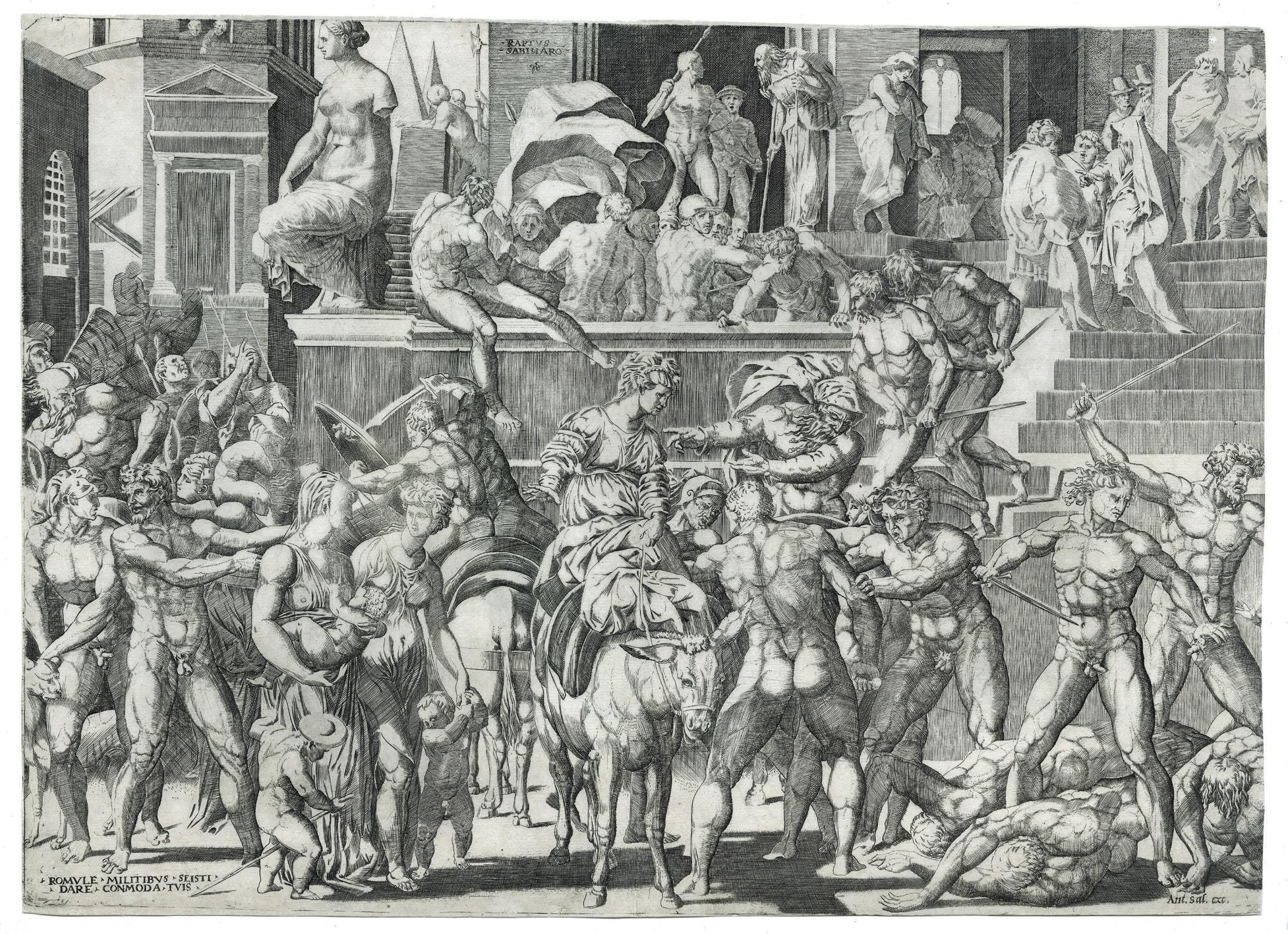
13
5 Giovanni Battista Scultori 1503 – Mantova – 1575
David Cutting Off Goliath’s Head
Engraving on laid paper, 1540
Plate 351 x 452
Watermark Paschal Lamb with a flag within a double circle surmounted by the letter A Reference Bartsch 6; Le Blanc 1; The Illustrated Bartsch 31/15, 6 (379); Albricci 6, 2nd (final) state
Literature Stefania Massari, Giulio Romano, Roma, Fratelli Polombi Editori, 1993, no. 101; Peter Raissis, Prints & drawings
Europe 1500-1900, Sydney, 2014, p. 28
Provenance Private collection, Italy
Condition In fine condition
A beautiful impression of one Giovanni Battista Scultori’s most famous prints, probably made after a drawing by the great Giulio Romano. An artist of abundant and varied talents, Giulio went to Mantua in 1524 at the invitation of Federico II Gonzaga and was named superintendent of all artistic works in the Mantuan state. His first and most important project was the design and decoration of the duke’s sumptuous new suburban villa, the Palazzo del Te. But before coming to this northern Italian court, Giulio had been Raphael’s most favoured pupil and assistant in Rome. As Raphael’s artistic inheritor, Giulio would have learnt the significant role engraving played in making the master’s designs well known across Italy and the rest of Europe, thus propagating his artistic fame.
Giulio’s workshop was set up along the lines of his master, and one of the young artists he engaged in Mantua was Giovanni Battista Scultori. Giovanni probably learnt the art of engraving from Agostino dei Musi, a follower of Raimondi, who had arrived in Mantua following the Sack of Rome in 1527. Although not a prolific printmaker – he is the author of no more than 21 plates based on Giulio’s as well as his own inventions – Scultori is nonetheless regarded as the founder of the flourishing school of reproductive engraving in Mantua in the mid-16th century.
The subject of this robust engraving, dated 1540, must derive from a drawing, now lost, by Giulio. Yet Scultori does not acknowledge the name of the inventor on the image, suggesting that the print might have been intended as a freely interpreted derivation inspired by Giulio’s design, rather than a precisely recorded reproduction of it. The composition indeed appears to
be related to the fresco depicting David and Goliath, visible in the lunette of the north wall of the Loggia in the Palazzo del Te, painted by Rinaldo Mantovano in 1532. Its depiction of David cutting off the head of Goliath derives from the first Book of Samuel in the Old Testament, in which the young shepherd David takes up his slingshot and strikes Goliath’s forehead with a stone. He then quickly seizes the Philistine warrior’s sword, beheads him, and the entire Philistine army is routed.
The print, however, shows substantial variations from the Loggia’s model. The style in which Goliath is executed seems to correspond rather with Giulio’s huge figures in the Sala dei Giganti, whose drawings date back to 1531 (see Konrad Oberhuber, in Giulio Romano, 1989, p. 367). Stefania Massari hypothesises that Giovanni Battista worked on the decoration of the Te until 1530. In fact, from this date onwards his name no longer appears in payments for the commission, and one can presume that here Scultori had the original model available, different from the final solution adopted in the fresco, destined by Giulio for engraving at a later date. The print exhibits a refined technique, especially evident in the crest on the right in the foreground worked in bas-relief, a genre in which Scultori had shown himself to be very skilled, as he had engraved “some heads with very beautiful ancient-style crests” mentioned by Vasari. The engraving has been made with a tight burin stroke and is rich in luminous contrasts.
The present entry is largely taken from the brilliant analysis made by Peter Raissis in Prints & Drawings Europe 1500-1900, Art Gallery of New South Wales, Sydney, 2014, pp. 28-29.
14
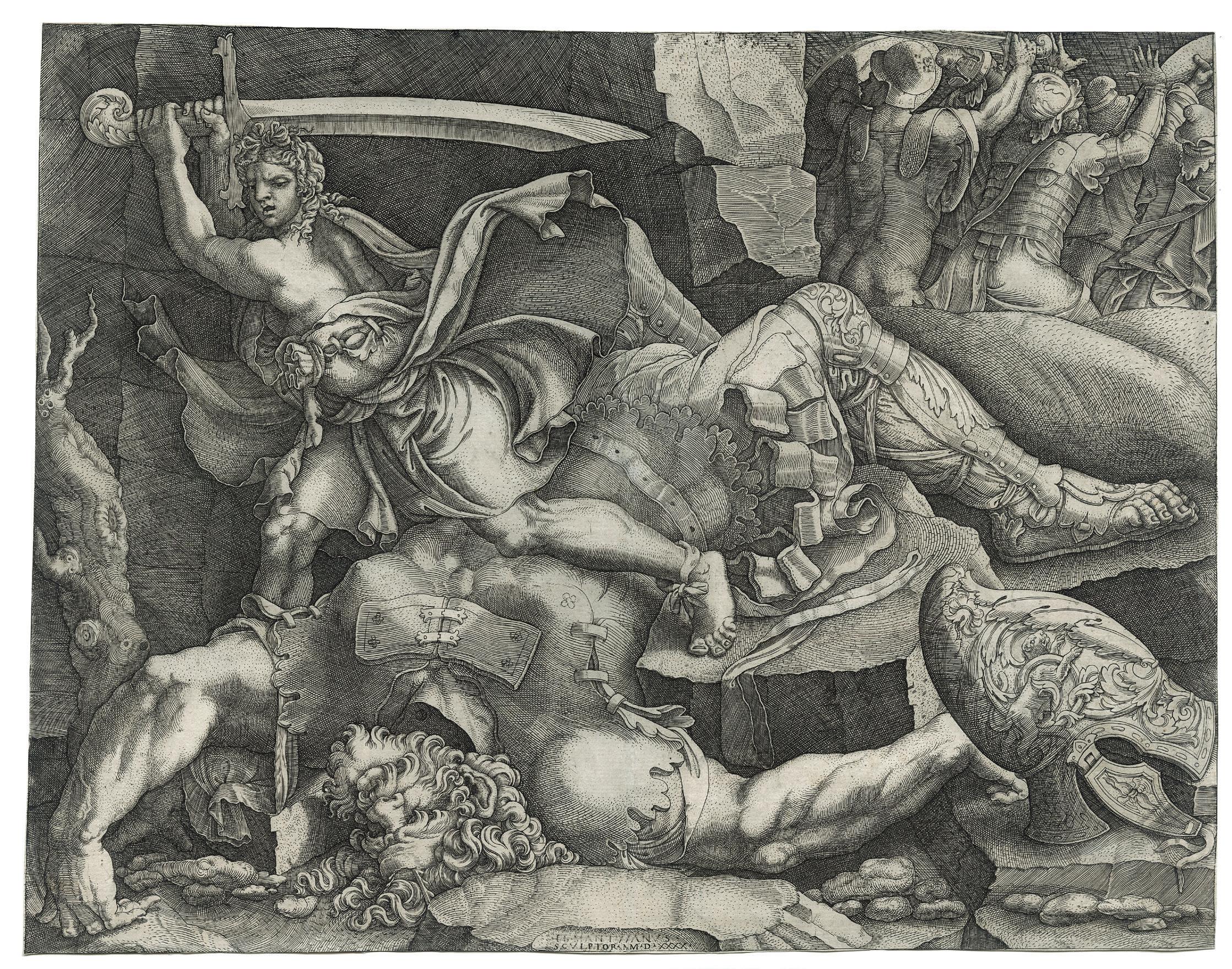
15
6 Juste de Juste ca. 1505 – Tours – 1559
Pyramid of Six Men
Etching on laid paper, ca. 1543
Plate 280 x 205 mm
Watermark Wing (fragment)
Reference Zerner 1, only state
Provenance Private collection, France
Condition
In very good condition
This work is an exceptional, very rare example of the human pyramids created by the Fontainbleau printmaker Juste de Juste. This artist was born in Tours in a family of Florentine origin, the Bettis, who settled in France in 1504 and became naturalized in 1513 under the name Juste. His father and uncles were royal sculptors who specialized in tombs. In the 1530s, Juste de Juste, so named by Henri Zerner, was a participant in the first Fontainebleau school (which also included the teams of Rosso Fiorentino and then Primaticcio), working as a sculptor in the François I gallery and in other parts of the castle around 1537-40. François I commissioned him to create marble sculptures of Hercules and Leda, and he appointed him Sculpteur du Roi in 1553.
According to Zerner, his work as an engraver consists of seventeen prints, including a suite of pyramids with five or six flayed men (écorchés) and another of twelve isolated anatomical figures, dating from around 1543. The five multifigured compositions are signed, but the series of twelve isolated figures are not. Jean Adhémar had attributed those prints to the printmaker Jean Viset, but Zerner, after Jules Renouvier (who was the first to interpret the signature as Juste’s) and Felix Herbet, convincingly argues that the highly personal and eccentric imagery of these etchings suggest the hand of a sculptor experimenting with the medium of etching.
Athletes, jugglers, gymnasts, flayers, acrobats, anatomical models, balladeers, wrestlers—whatever we call these naked men of incredible vibrant energy, we cannot help but be struck by the freedom of the subject. This gigantic presentation is never lacking in lightness. It stages, with a sense of contrapposto pushed to the limit, the rise and fall of figures as well as the construction of passages and footbridges, thanks to an art that seems to have more to do with dance than with violent combat. This composition indeed argues that the Pyramids are the work of a sculptor. Their rarity suggests that they were intended as private studio exercises of the artist’s skill in rendering the human figure in action. Juste’s extraordinarily free and casual manner of etching is remarkable even for the school of Fontainebleau, with its exponents of an open style of modelling such as Antonio Fantuzzi and Jean Mignon. But this theatre of fulllength figures is unique for its time. It could certainly be seen as a forerunner of the wooden mannequins that Luca Cambiaso used some twenty years later to study the lighting and perspectives of interweaving geometrical bodies. As for its draughtsmanship, Bruce Davis convincingly demonstrated an affinity with Baccio Bandinelli in the work’s approach to anatomy and the graphic treatment1
16
1. Bruce Davis, Mannerist Prints – International Style in the Sixteenth Century, Los Angeles, Los Angeles County Museum of Art, 1988, p. 195.
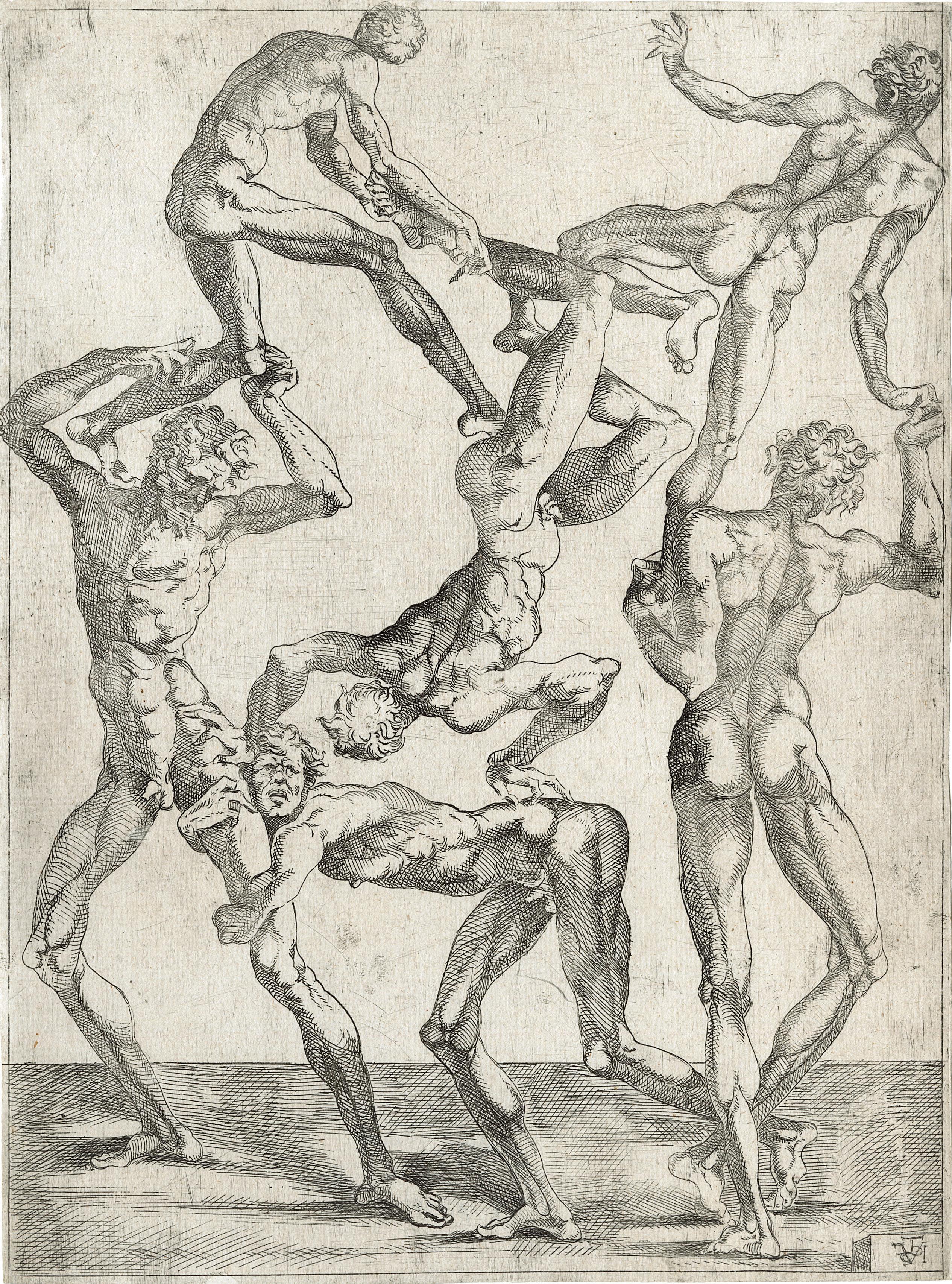
17
7 René Boyvin ca. 1530 Angers – Rome 1598
Carita Romana
Engraving on laid paper, ca. 1570
Plate 146 x 94 mm
Reference Robert-Dumesnil 11; Felix Herbet, Inventaire du Fonds Français, p. 168;
Literature Felix Herbet, Les graveurs de l’école de Fontainebleau. Les eaux-fortes nommées ou marquées, Fontainbleau, 1896-1902, t. III, p. 35
Provenance Private collection, France
Condition In very good condition
This superb impression comes from a rare plate by the French printmaker René Boyvin. As far as we can assert, there are only two other known surviving impressions of this work, at the Bibliothèque nationale de France and the Albertina Museum in Vienna.
The plate depicts the elderly Cimon as he feeds on the milk of his daughter, Pero, through the bars of his prison. Pero’s exemplary act of “Roman Charity” is a frequent subject of sixteenth – and seventeenthcentury art, one that allegorizes the importance of filial piety. The story goes that Pero obtained permission to visit her jailed father, but the guards prevented her from bringing him food, as he had been sentenced to death by starvation. When Cimon didn’t die as expected, one of the guards kept watch and noticed that Pero was breastfeeding her father. The praetor and the judges were informed and, moved by Pero’s devotion, decided to release the prisoner.
The present composition was probably inspired by the bas-relief below the painting of Cleobis and Biton in the gallery of François I, executed by Rosso Fiorentino, but the details of the compositions are quite different.
Most illustrations of the Carita Romana, such as those by Rubens, Carravaggio, and J.B.Greuze, omit the prison-bars and instead present a view of unobstructed breast-feeding. In choosing to show Pero from behind, sitting on a stone and feeding Cimon through the bars of the cell, Boyvin only suggests the suckling itself, instead focusing all his attention on the complex anatomical position of Pero’s half-twisted trunk, the subtle equilibrium of which he masterly rendered.
Boyvin was one the leading figures of the school of Fontainebleau, and he was instrumental in disseminating the work of the Fontainebleau artists. Born in about 1530 in Angers, active as an engraver and goldsmith, Boyvin was last recorded in 1580 in Paris but might have died as late as 1620 in Rome. In about 1545 in Paris, he was evidently a pupil of Pierre Milan, but Boyvin is more closely identified with the work of Rosso Fiorentino – much of his œuvre is based on Rosso’s ornamental designs for masks, costumes, and decorative objects, mostly engraved by his workshop. Yet Boyvin’s best works, such as the present engraving, are not ornamentals, but rather independent, narrative creations.
18
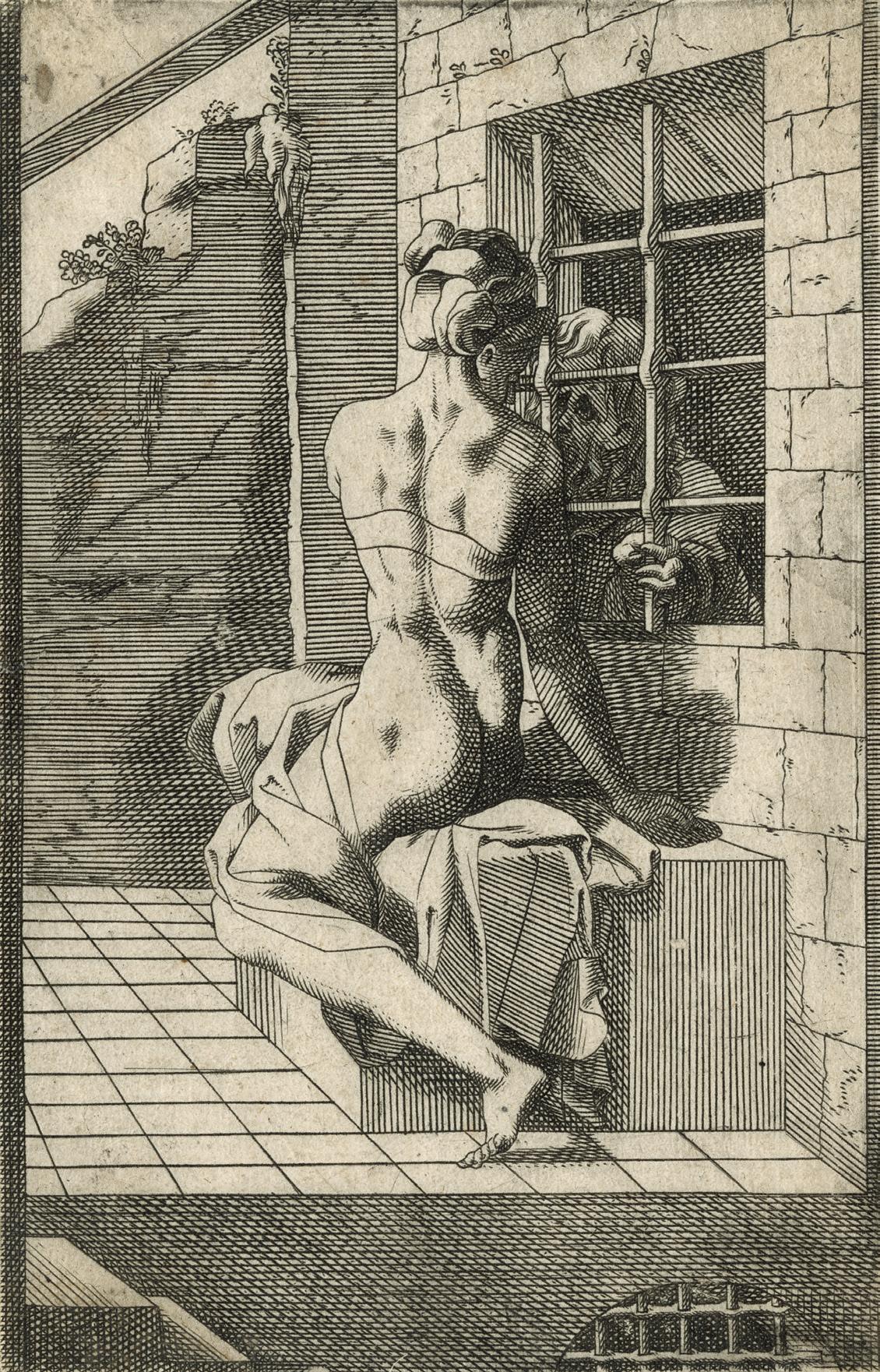
19
8 Mario Cartaro ca. 1540 – Napoli – 1620
Theatrum Apollinis
Engraving on laid paper, 1583
Plate 405 x 538 mm
Watermark Fleur de Lys in a single circle (close to Woodward 98)
Reference Not in Bartsch, 2nd state of two
Provenance Private collection, Italy
Condition In fine condition
The present object is a very rare and fine impression of the second and final state of the Theatrum Apollinis by Mario Cartaro. In the plate’s second state, the signature at lower left has been removed, the authorship ex penu of Giovanni Battista Rinaldi has been added just below the imprimatur, and the plate has been reduced by a few millimeters on each side. According to Woodward, the watermark dates from the late 1500s.
In the composition’s upper left corner is a rectangular cartouche bearing an imprimatur from the Cardinal Antonio Carafa (1538-1591) to Giovanni Battista Rinaldi, a sacra theologia doctoris from Caserta, in the North of Naples. Following the pontifical bull Inter sollicitudines of 1515, it was customary (though not systematic) for pagan writings or artworks to be submitted for an imprimatur that would validate their adherence to Church faith and doctrine. Strictly speaking, this was not a canonical imprimatur, but rather a blessing, a protection of the author by Cardinal Carafa, in this case given two years before its publication (as discussed below). Understandably, everything to do with Apollo at the end of the 16th century had to do with the sun and its place in the universe, a subject that was to become increasingly sensitive in the early 17th century as a result of Galileo’s research and writings.
The composition and its identifying numbers refer to Giovanni Battista Rinaldi’s work Compendium of the Poetic Forest, a corpus published in Naples in 1583 from the presses of Horatio Salviani and Cesare Cesari.
It is divided into theatres, which contain the philosophy of poets and Platonists, and the peripatetic and principles of the fictions of Homer and Virgil. The volume is presented as a small treatise on mythology and allegory, in which the author addresses the different philosophical interpretations underlying the myths, divided into four sections: the Theatro d’Appollo, the Theatro di Minerva, the Theatro di Nettuno, and the Theatro di Plutone. Each part investigates places, monuments, mythological characters, animals, and symbols connected with the respective deity. The composition, executed by Cartaro at a time close to his move to Naples, represents the Theatro d’Appollo He also engraved the Theatro Plutonis, but not the remaining two, and there is no other representation known after the Rinaldi treatise. It is thus very rare. We have been able to record examples at only the British Museum (which holds both Cartaro Theatro impressions) and the Israel Museum, Jerusalem (which holds the Theatro Plutonis).
The idea requires further research, but we believe that this composition should also be placed in the philosophical and artistic context of Naples at the end of the 16th century, although Cartaro was first and foremost an engraver from Rome and was famous there for his maps. The fact that his name disappears in the 2nd state seems to us to have been the result of a commercial dispute between Rinaldi and the artist.
20
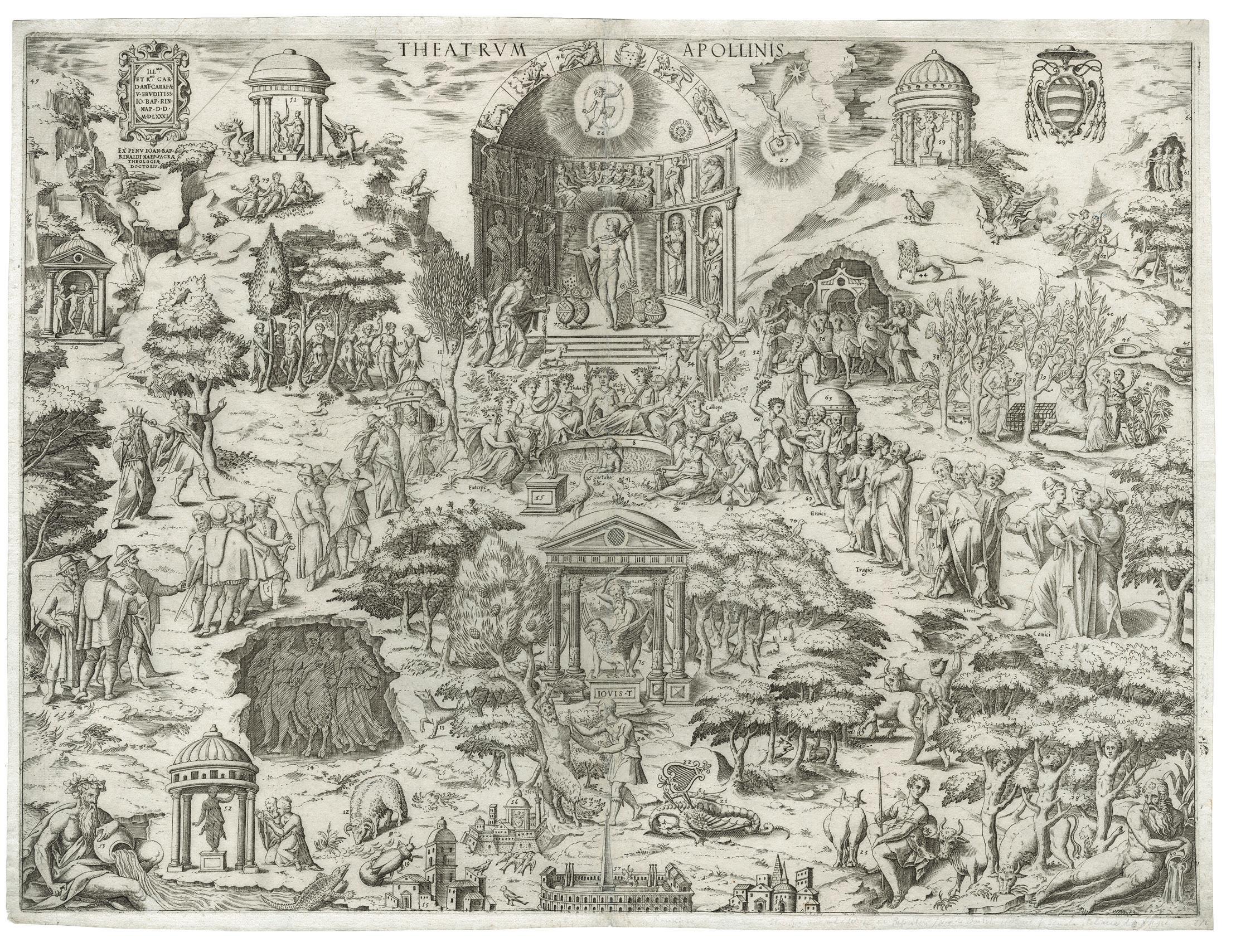
21
9 Hendrick Goltzius 1558 Mülbracht – Haarlem 1617 Pietà
Engraving printed on laid paper, ca. 1596
Plate 188 x 127 mm
Watermark Indistinct to read, probably a shield or an animal (cockatrice/crest?) on three balls
Reference Hollstein 50, second (final) state
Provenance John Evelyn (1620-1706), Wotton, Surrey; by descent to Cecil John Alvin Evelyn (1904-1976), Stonor Park; his sale, Christie’s London, 29 June 1977 (sold for £950); bought by the father of the last owner (probably through Colnaghi or Agnew’s), Private collection, England
Condition In fine condition
I have desired this print for a very long time. Although it is not especially difficult to find examples of Hendrick Goltzius’s Pietà, I had never encountered an impression that is absolutely perfect. When I was shown the present impression, it turned out to be the best copy I had ever seen in a private collection, with a provenance dating back to the 17th century. It was a dream. The original owner, John Evelyn, gathered a small but exceptional collection of prints, including a large ensemble by della Bella. Evelyn’s collection was later cared for by the Honorable Sherman Stonor (1913-76), at Stonor Park, Henley-on-Thames, Oxfordshire. C.J.A. Evelyn, the author of a number of mathematical papers and books, was a Tenant for Life to the Family Estates and Heirlooms from 1925-1965. The collection was finally sold in 1977 at Christie’s London in several sales. These of course fetched high prices.
Ever since its creation, the Pietà of Goltzius has been renowned as one of the most remarkable tributes to the famous artist Albrecht Dürer by another great master of Western art. By 1590, when Goltzius interrupted his production of engravings to embark on a year’s trip to Italy, he was already moving away from the extreme mannerist style. Among his late engravings, there are several that pay a clear but subtle homage to the whole engraving tradition, particularly to two masters of Germany and the Netherlands: Dürer and Lucas van Leyden. Already in a series of prints of 159394, Goltzius issued engravings clearly designed in the styles of different artists, and he imitated not only those artists’ composition and figural poses but also their distinctive engraving techniques. The Goltzius
Pietà depends on two late engravings by Dürer of the Madonna and child: The Virgin Nursing the Infant of 1519 (Bartsch 36) for Mary’s tilted, veiled head and for the general configuration of the upper part of her body; and The Virgin with the Swaddled Infant of 1520 (B. 35) for the setting, the nocturnal lighting, and the geometric simplicity of Mary’s skirt. The configuration of the entire group is based, of course, on the famous sculpture by Michelangelo in Saint Peter’s, which Goltzius must have seen on his trip to Rome in 1590-91. Yet Goltzius has blended the elements from these three sources into a seamless and orginal whole, having scrupulously avoided copying any detail exactly.
To prevent any suggestion of deceitfulness, Goltzius’s monogram and the date ’96 are clearly visible in the foreground. Yet it is almost as if Goltzius were saying “If I had not signed this so plainly, would you have realized that it was not by Dürer?” In short, here we see Goltzius engraving in honor of Dürer, sixty-seven years after the latter’s death, a subject that the German artist could have engraved (but never did), using as a model an Italian work of art that would have influenced Dürer, if he ever saw it. Goltzius himself may not have been aware of all these connections, but one surmises that he would have relished them.
This entry is largely taken from the description that Timothy Riggs brilliantly made of the print in the equally excellent reference Six Centuries of Master Prints, Treasures from the Herbert Greer French Collection, Kristin L. Spangenberg (Ed.), Cincinnati Art Museum, 1993, Cincinnati, p. 107-08.
22
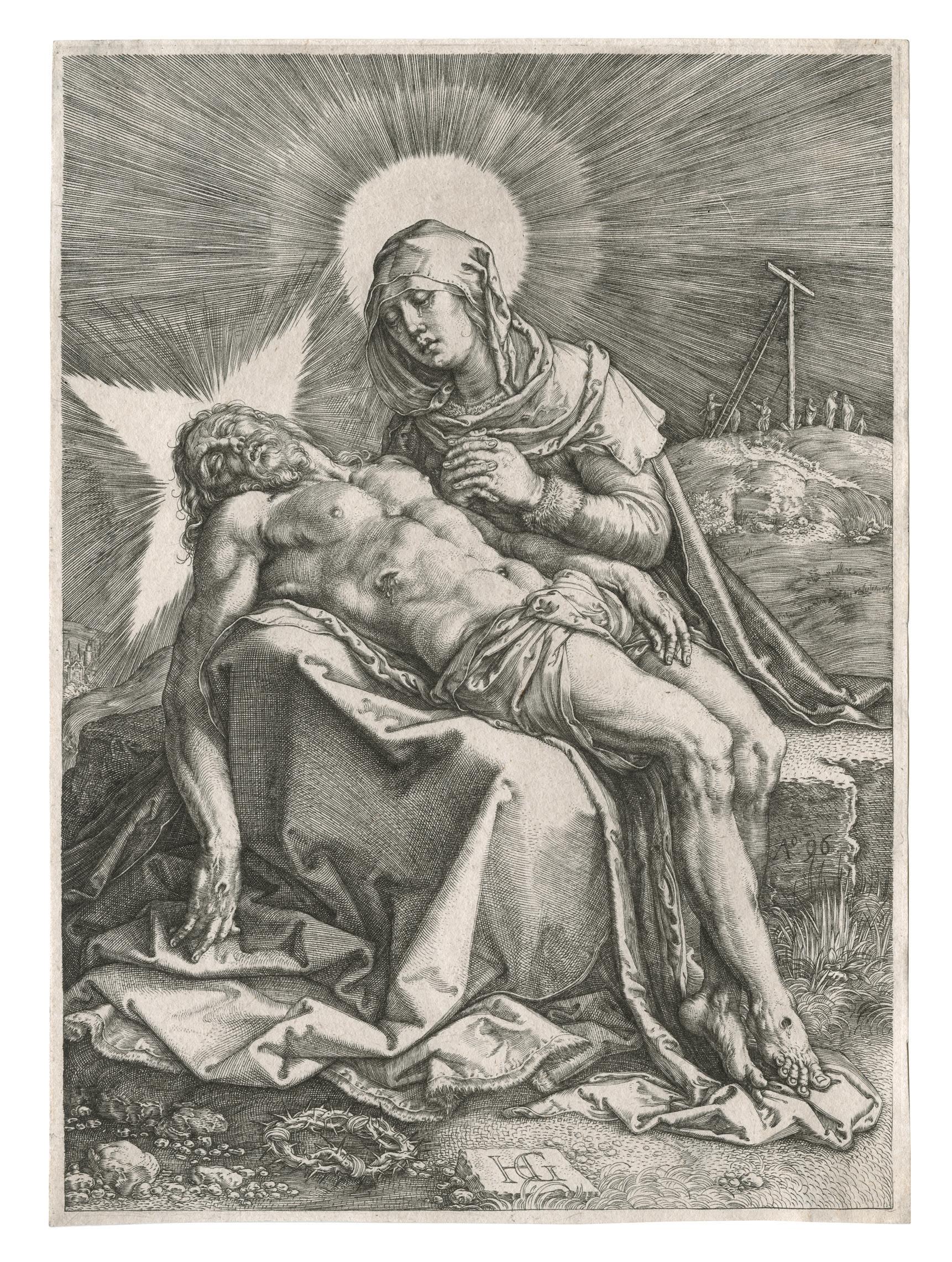
23
10 Nicolaes de Bruyn 1571 Antwerp – Rotterdam 1656 The Kermess
Engraving on laid paper, ca. 1602
Plate 443 x 708 mm
Watermark Letters IG
Reference Hollstein 117; New Hollstein 213, second sate of four Provenance Grand-Dukes of Baden (Lugt 1603); Private collection, Italy
Condition In very good condition, a trace of a vertical fold in the centre
This is a superb impression of de Bruyn’s renowned The Kermess, the second state of four, printed in his lifetime with the excudit of Francoijs van Beusecom, and so before the posthumous publisher’s address of Gerard Valk. It is the largest and most spectacular print after a design by David Vinckboons ever made. A bird’s eye view with scores of little figures, the image affords a sampling of everything that happens at such a fair. Members of the crowd dance merrily, gorge themselves, fight one another, and gape at the market stands, all coming together to create a farcical play. On the flag at the inn one finds the title Die Boire Cermis. Elegantly clad urbanites observe the eating, drinking, walking and dancing crowd with an air of slight disdain. The building beyond is the city hall of Oudenaarde.
The present impression is exceedingly rare, as most impressions of the composition are posthumous and published by Gerard Valk. As far as we can ascertain, there is not a single impression like it in major US collections – not even at the Metropolitan Museum of Art (New York) and the Boston Museum of Fine Art, which both have extended collections of Dutch prints. The British Museum does not have any impression. The impression kept at the Rijksmuseum is a second state, like the present one. The Vinckboons drawing that served as the model is kept at the Statens Museum for Kunst, in Copenhagen (inv. no. SK 18.7) and is dated 1602.
As engraving became more international in its scope and technique, engravers began to pick and choose styles that met the demands of their own market. The Antwerp artist Nicolaes de Bruyn made the conscious decision to engrave in the style of the earlier engraver Lucas van Leyden. This delicate, atmospheric approach made up of mostly straight lines was appropriate for de Bruyn’s large-scale landscape scenes, and it helped him tap into a specialized market of Lucas’s admirers. The scale of de Bruyn’s engravings was something new, however. Such large formats may have been intended to be painted and hung on walls as substitutes for paintings.
It is worth mentioning the distinguished provenance of this print: the collection formed by the GrandDukes of Baden from the 17th century. The stamp “Gr. Bad. Kupferstich Cabinet” was applied on a large section of the collection, probably during the 19th century. A part of the collection, the one formed in the 18th century by the Grand-Duchess Karoline Luise von Baden (1723-1783), was given by the von Baden family to the state of Baden in 1930, and it now is held at the Staatliche Kunsthalle Karlsruhe. About the history of the collection, see Gerda Kircher, Karoline Luise von Baden als Kunstsammlerin: Schilderungen und Dokumente zur Geschichte der Badischen Kunsthalle in Karlsruhe, Karlsruhe, Müller, 1933; and Anna Maria Renner, Die Kunst-Inventare der Markgrafen von Baden-Baden, Bühl-Baden, 1941.
24
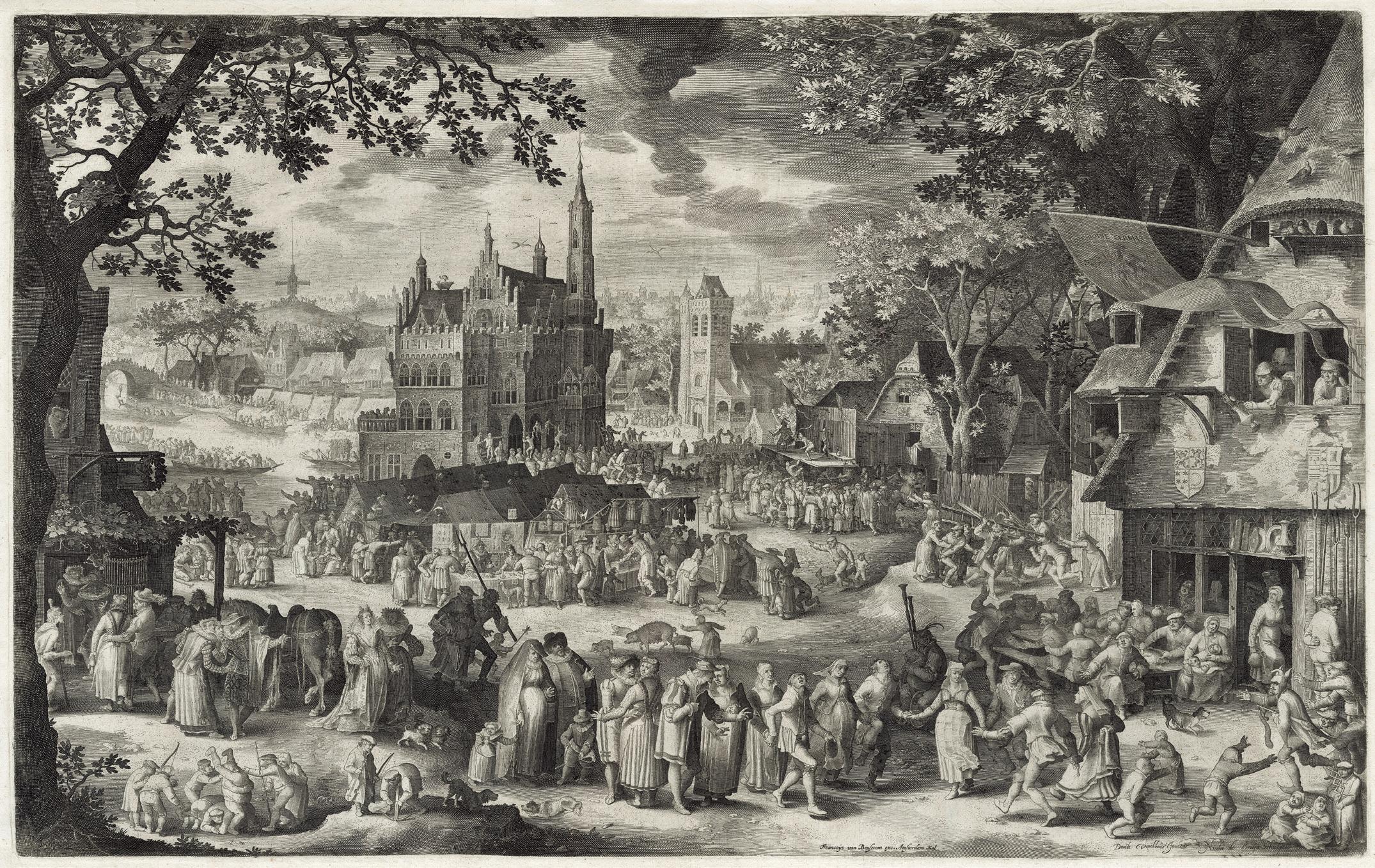
25
11 Jacques de Gheyn III
Sleeping Mars
Etching on laid paper, ca. 1618
Plate 202 x 18O mm
Watermark Strasbourg coat of arms
1596 Leyde – Utrecht 1641
Reference New Hollstein 18, 3rd (final) state
Provenance Private collection, Netherlands
Condition In very good condition
This is a stunning impression of the Sleeping Mars, regarded as one of Jacques de Gheyn III‘s finest prints, showcasing his mastery of detail and composition. The work reflects the influence of Italian Renaissance art and demonstrates de Gheyn‘s skill in conveying both physical and emotional ideas in his prints. The print depicts the Roman god of war, Mars, in a state of slumber. Mars is shown asleep with his helmet and armour beside him. This portrayal presents a contrast between the belligerence of Mars and the peacefulness of sleep.
This plate, made around 1618, refers directly to the political situation in the Netherlands at the beginning
of the 17th century. In 1609 a truce had been negotiated in Antwerp between Spain and the Northern Netherlands, which was to last twelve years from that date. It turned out to be the only interruption in the Eighty Years‘ War (1568-1648) from which Holland finally emerged as an independent republic. The sleeping Mars, highlighted by de Gheyn, has become an artistic allegory for this truce: the God of War has laid down his armour and weapons and falls asleep on a great cannonball in the face of the diminishing threat.
26
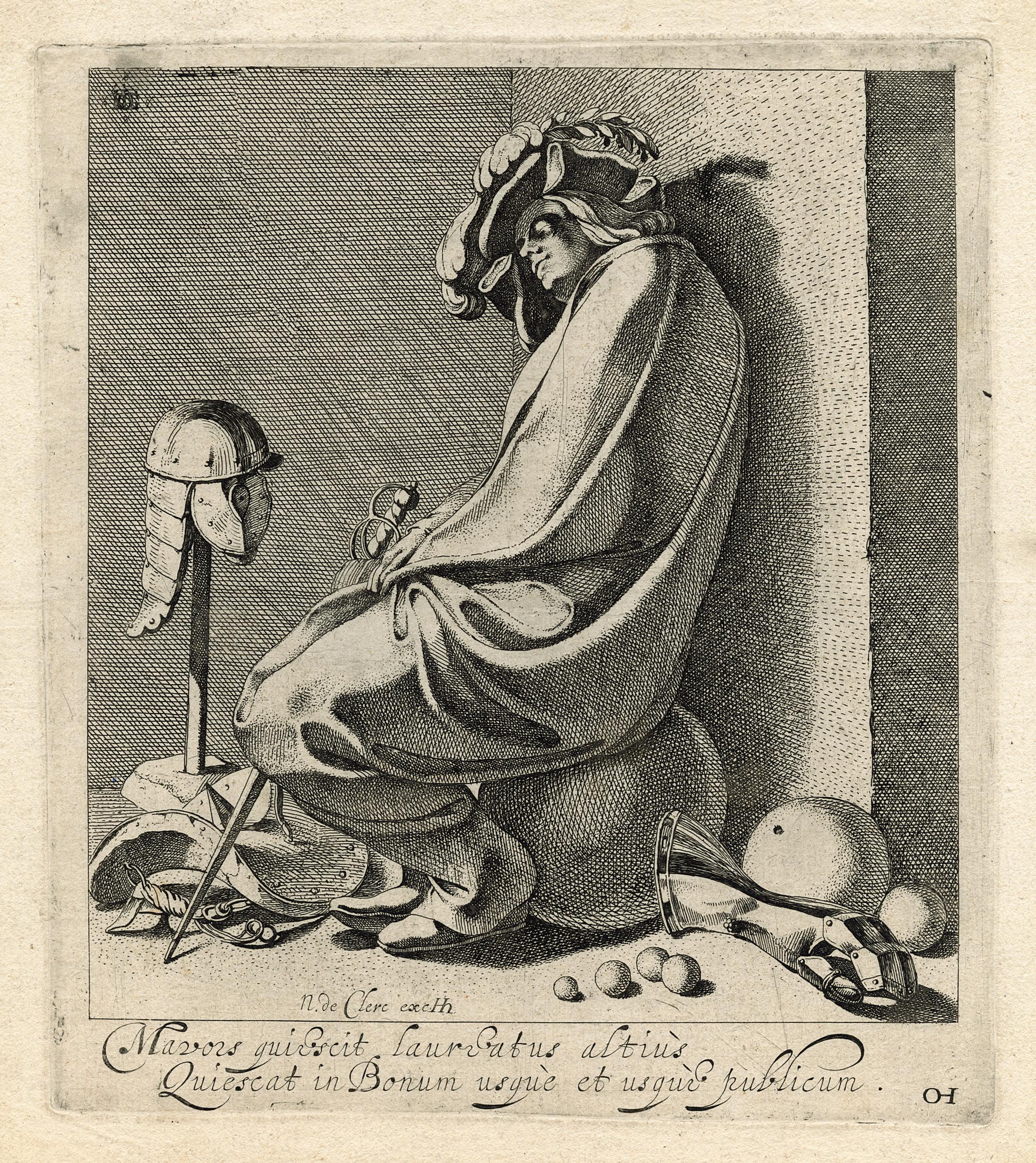
27
12 Jusepe de Ribera 1591 Játiva – Naples 1652
The Poet
Etching on laid paper, ca. 1620 -21
Plate 161 x 124 mm
Watermark Tower
Reference Bartsch XX, 83, no. 10; Brown 3, only state
Provenance Charles Rogers, London (note on the reverse Rogers’s Sale 1799, original ); William Cotton, London; Hamburger Kunsthalle, Kabinett der Graphischen Sammlung, with the stamp of the sale, dated 1958 (Lugt 1328 and 1235a)
Condition In very good condition
This is a beautiful impression of a rare print, with deep black shadows on the poet’s face.
Completed after his Saint Sebastian and Saint Bernardino of Siena in ca. 1620, The Poet, one of Ribera’s greatest and best-known prints, represents the artist’s shift towards a more ambitious approach to etching. According to Wolfang Stechow’s excellent analysis, The Poet was the first work of art to establish the connection between Poetry and Melancholy: the poet, with his crown of laurels, expresses melancholy with head resting on hand and eyes downcast. Ribera’s conception of the subject emphasizes the poet’s dark, sunken mood through thick, deeply bitten lines. In the shadow enveloping the poet’s face, these lines form a rich, almost impenetrable darkness that is repeated in the folds of his clothing’s drapery.
The sharp contrast between areas of light and dark is exceptionally pronounced. Stechow’s suggestion that the poet may be Petrarch is plausible. Selma Holo has noted that his pose is likely derived from the figure “Heraclitus” in Raphael’s School of Athens.
Although Jusepe de Ribera was not a prolific printmaker – only sixteen prints are attributed to him – his etchings are among the most vigorous and monumental contributions to Italian baroque printmaking in the first half of the seventeenth century. The small size of his œuvre belied its quality and importance. The role of prints was paramount, allowing Ribera to establish an artistic sphere of influence in Italy and Spain that was larger than what he could have achieved through painting alone.
28
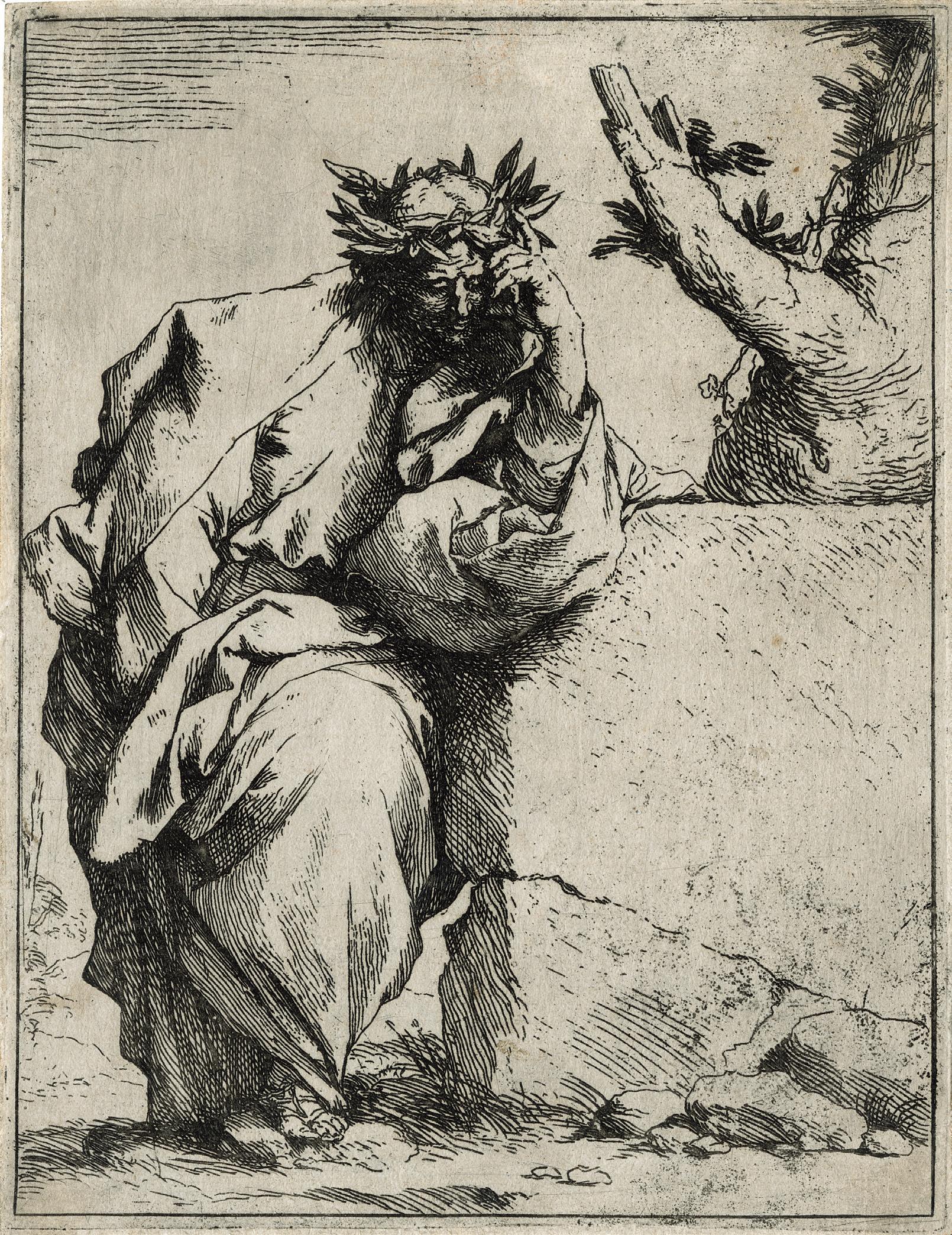
29
Crucifixtion
Etching on laid paper, ca. 1645
Plate 159 x 122 mm
Reference Bartsch, XIX, 1; Le Blanc, p. 239; Hollstein (Georg Pecham/Possenti) 2, only state
Literature Nadine M. Orenstein, “Possenti and Hercules”, in Print Quarterly, XI, March 1994, pp. 20-25
Provenance Private collection, Germany
Condition In fine condition
The identity of the monogrammist GP has long been a source of confusion, leading past scholars to various attributions. Bartsch knew of a total of seven etchings, which he attributed to an anonymous pupil of Guido Reni. In later years, Nagler associated the work with the Augsburg engraver Georg Pecham.
Since Le Blanc there has been some support in attributing these works to the painter and engraver Giovanni Pietro Possenti. Robert Zijlma in the Hollstein volume hypothesized two groups, one to Georg Pecham and one to Possenti, but in 1994
Nadine M. Orenstein proved conclusively that the ten etchings known to date were indeed by Possenti, who worked in Bologna, Padua and Venice. All the prints share an extraordinarily evocative engraving style, one
that incorporates wild and messy etching. Bartsch described its hatching as “faites ďune manière confuse et tournées en différents sens”, and Cohn described the manner as incorporating a “great freedom of touch, utterly oblivious to the convention of engraving or the niceties of etching technique.”
As Orenstein states: “Possenti may not have been one of the most proficient of seventeenth-century Italian etchers, but his work has individuality and monumentality, and deserves further attention.”
The present print is extremely rare. Robert Zijlma knew only two other impressions, in Hambourg and Princeton.
30
13 Giovanni Pietro Possenti 1618 – Bologna – 1659
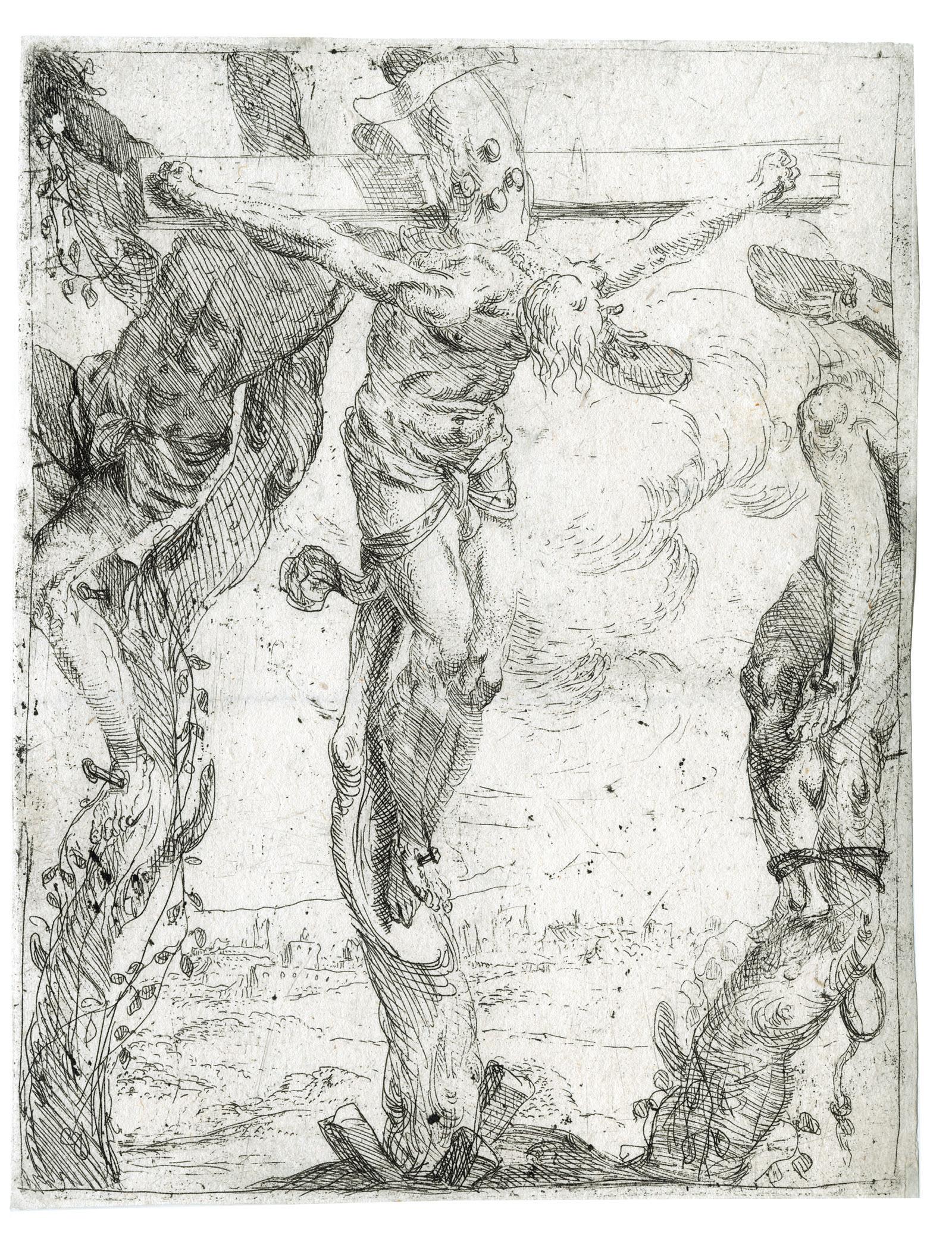
31
14 Wenzel Hollar 1607 Prague – London 1677
The Muff
Etching on laid paper, 1647
Plate 84 x 112 mm
Reference Pennington 1946, only state Provenance Private collection, Germany Condition In fine condition
The present print is a beautiful impression of one of Wenzel Hollar’s most celebrated etchings. This representation of muffs is extraordinary for the almost fetishist pleasure with which he seems to have made them. Here the dark fur muff is embellished with an embroidered band round the centre, and it seems to lay on a table.
The muffs by Hollar are “… justly the best loved and admired of all Hollar’s prints, and they constitute his most original contribution to the history of printmaking. The closely laid and expertly bitten lines perfectly suggest the softness and warmth of fur, in which Hollar delighted. The delicacy and closeness of the lines is such that they wore quickly and could scarcely be retouched; consequently, fine impressions of them are rare” (see Richard Godfrey, Wenceslaus
Hollar, A Bohemian Artist in England, Yale Center for British Art, New Haven, 1995, no. 92b, pp. 126-7). But Hollar’s Muff also suggests the life of its absent owner and her social milieu; in the absence of any given context, we are invited to attach our own stories to the landscape-like arrangement.
Two centuries after Hollar’s death the etcher Seymour Haden paid tribute to his unassuming technical proficiency: “If anyone wants truth without pretension let him go to Hollar. If he wants perfection of ‘biting’ and the precise degree of graduation required, let him also go to Hollar. If he wants to live in the time illustrated, let him again go to Hollar… People sometimes say to me: ‘What is it you see in Hollar?’ and I always answer: ‘Not quite but nearly everything’.”
32
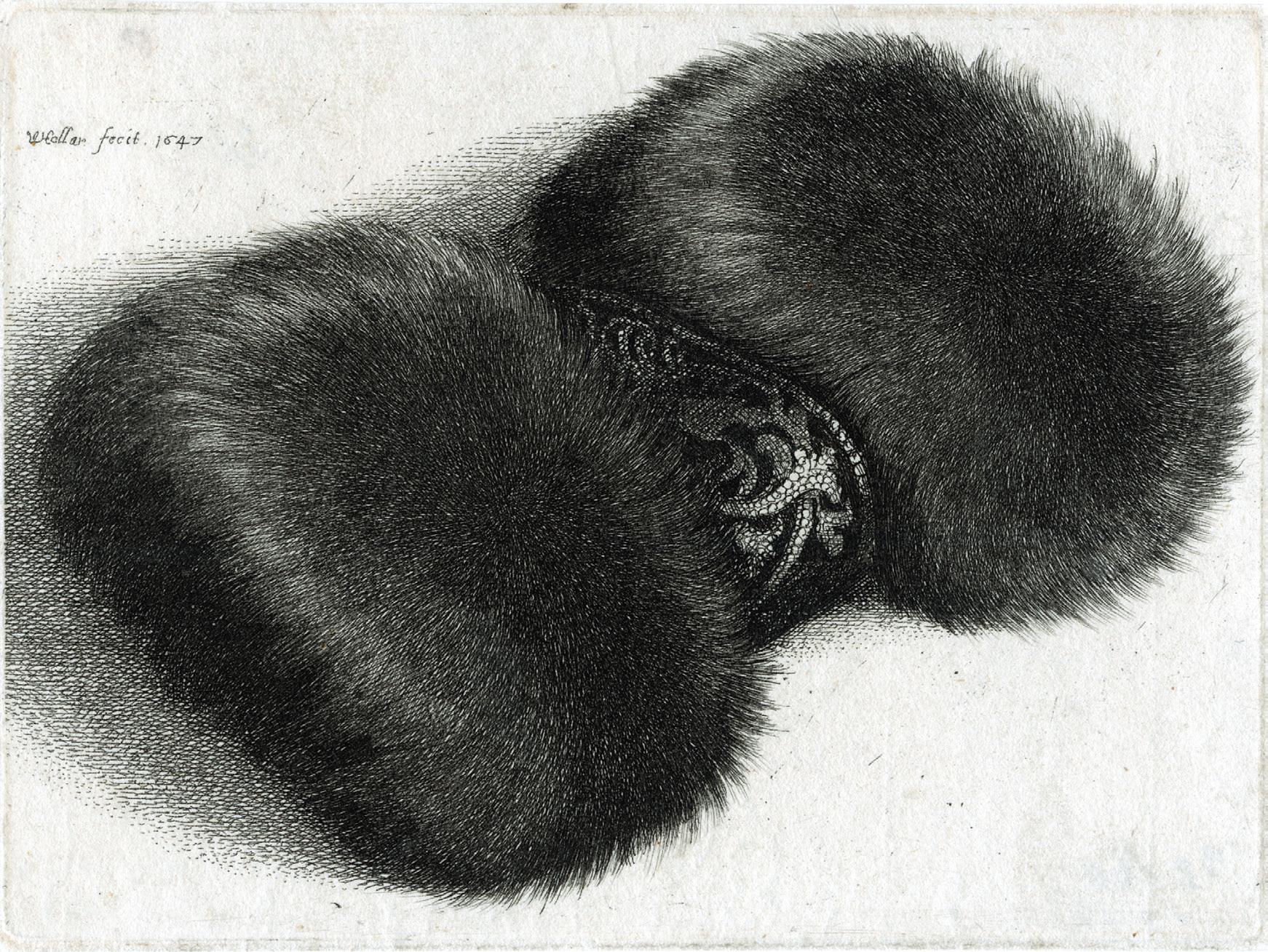
33
15 Rembrandt Harmensz. Van Rijn 1606 Leiden – Amsterdam 1669
The Circumcision in the Stable
Etching on laid paper, 1654
Plate 94 x 145 mm
Watermark Foolscap with seven points (fragment)
Reference Bartsch 47; Hind 274; White & Boon 47, 1st state of two; Nowell-Usticke 47, 1st state of three; New Hollstein 280, 2nd state of three
Provenance Joseph Ritman, Amsterdam; Private collection, France
Condition
In very good condition
The present work is a very fine, early lifetime impression printing with subtle plate tone, a rarity for this plate. White and Boon listed only four examples of The Circumcision printed with tone like this. This print tends to come rather dryly printed, but here the veil of surface tone hides the stable in darkness, except for the pivotal area round the infant Christ. This intensifies the bright light illuminating the central group, resulting in a more beautiful and dramatic print. The artist had used a similar effect in the fourth state of The Three Crosses.
“The Bible is not very forthcoming about the subject pictured here. All it says is that Christ was circumcised eight days after his birth. We know, however, that according to the Jewish law woman may not enter
the temple for the first forty days after the birth of their child, and this why in the Apocrypha the event is usually situated in the stable where Christ was born. In spite of this the western pictorial tradition for the most part places the event in a temple, with a high priest who holds the child. Rembrandt’s earlier interpretations of the subject followed the tradition, but the present composition is in accordance with the literary sources.” (Eric Hinterding, Rembrandt Etchings from the Frits Lugt Collection, Paris, Fondation Custodia, 2008, p. 107).
The present entry borrows some parts from both the excellent references: Christopher White, Rembrandt as an Etcher, Yale University Press, New Haven, 1999; and Erik Hinterding, Rembrandt Etching from the Frits Lugt Collection, Fondation Custodia, Paris, 2008.
34
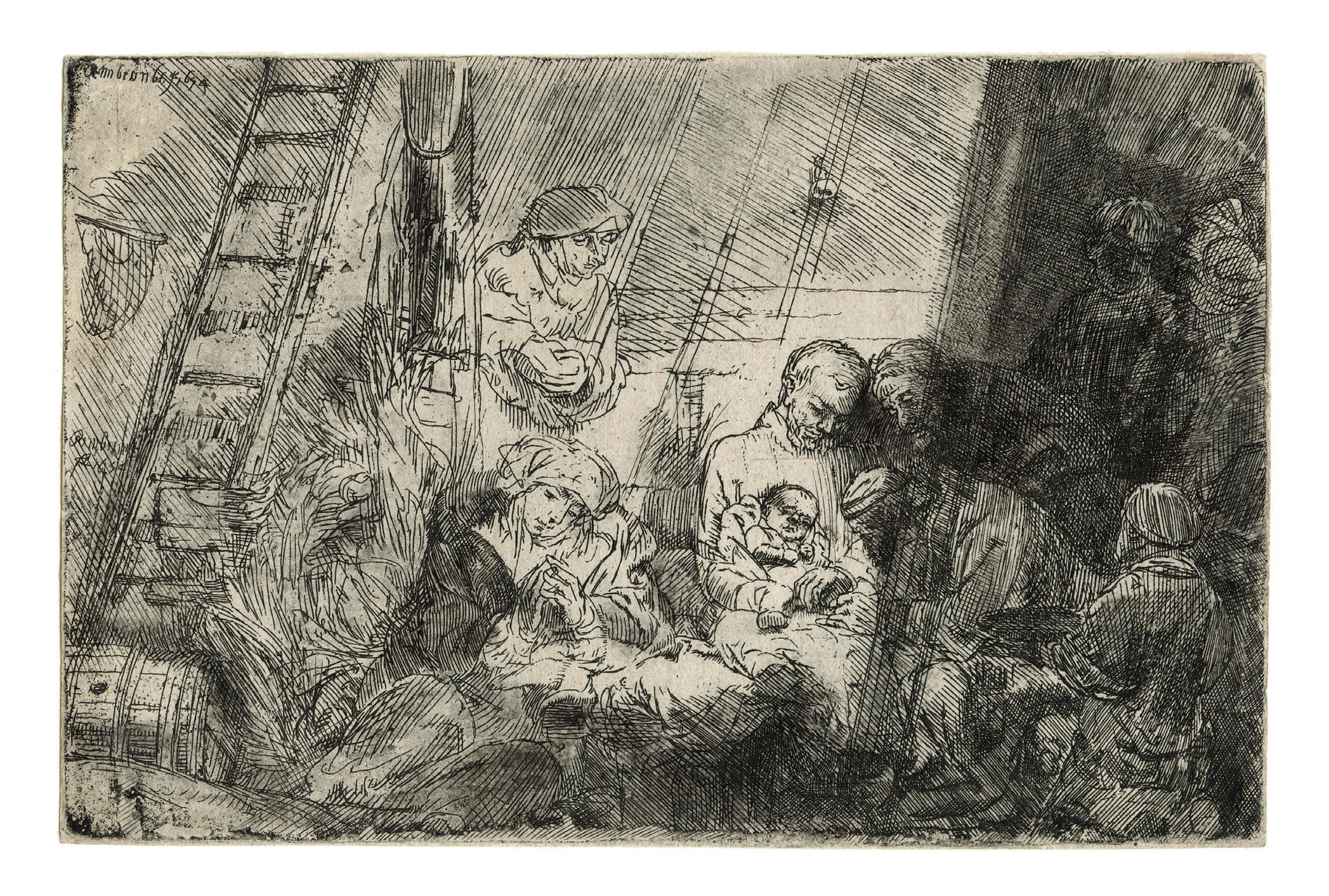
35
16 Rembrandt Harmensz. Van Rijn 1606 Leiden – Amsterdam 1669
Christ Seated, Disputing with the Doctors
Etching on laid paper, 1654
Plate 95 x 144 mm
Watermark Arms of Bristol (Hinterding p. 41 A / a.b.)
Reference Bartsch 64; Hind 277; White & Boon 64, only state; Nowell-Usticke 64, 1st state of two; New Hollstein 281, only state
Provenance Ludwig Maximilian Freiherr von Biegeleben (Lugt 385); Dr. F.A. Lieberg (Lugt 1681); his sale, Galerie Kornfeld, Berne, June 21, 1979, lot 31; Private collection, France
Condition
In very good condition
This is a very fine, early lifetime impression, still showing fresh drypoint and vertical polishing scratches in the foreground, and printing with subtle plate tone.
The etching is an entry in a series on the youth of Christ dating from 1654. The twelve-year-old Jesus sits amidst a group of scribes in a lively discussion; they listen to him with attention and amazement. An old man with a book under his left arm approaches on the right.
In 1905 Valentiner suggested that Titus van Rijn had modelled for the image of Jesus. Later Münz took the view that Jesus’s features were too Jewish to be identified as Rembrandt’s son, but he did think that
the subject could have been inspired by the boy, who was twelve years old in 1654. Seidlitz identified the old Oriental on the extreme left as Joseph. Shelley Perlove observed that Rembrandt has portrayed Ashkenazi Jews, pointing particularly to the standing Polish Jew with his long boots, who wears a tallith, a Jewish prayer shawl. Perlove also suggested that millenarian concerns might have been a factor in the choice of this subject.
The present entry borrows some parts from both these excellent references: Christopher White, Rembrandt as an Etcher, Yale University Press, New Haven, 1999; and Erik Hinterding, Rembrandt Etching from the Frits Lugt Collection, Fondation Custodia, Paris, 2008.
36
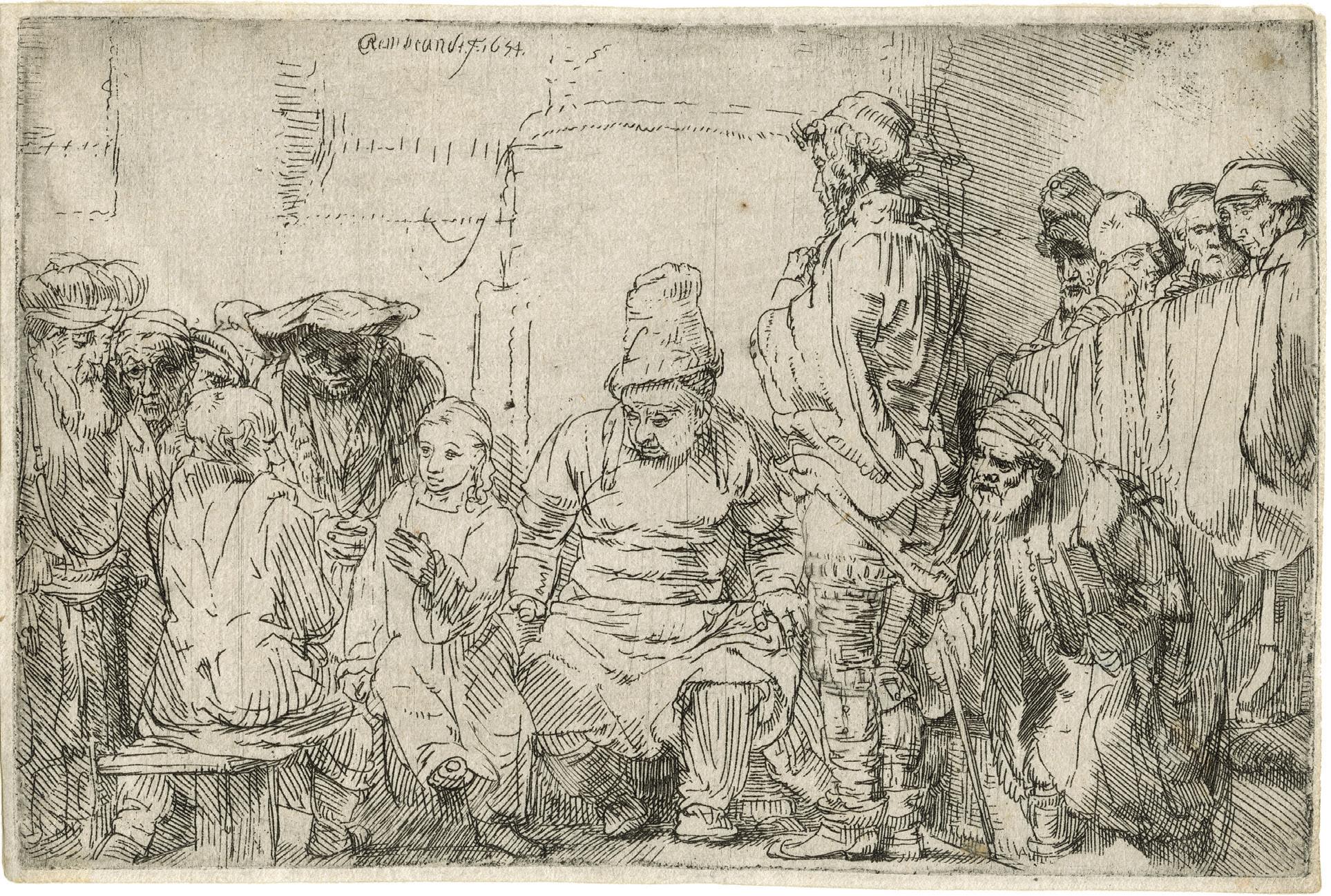
37
17 Rembrandt Harmensz. Van Rijn 1606 Leiden – Amsterdam 1669
The Virgin and Child With the Cat and Snake
Etching on laid paper, 1654
Plate 95 x 145 mm
Reference Bartsch 63; Hind 275; White & Boon 63, first state of two; Nowell-Usticke 63, first state of two; New Hollstein 278, first state of two
Provenance Dr. F. A. Lieberg (Lugt 1681); his sale, Galerie Kornfeld, Bern, June 21, 1979, lot 31; Private collection, Europe
Condition In very good condition
This is a very fine early impression, still showing the vertical polishing scratches in the foreground and printing with subtle plate tone. It is in very good condition with exceptional wide margins all around, about three centimetres in width.
The image of Mary with the snake is an allusion to Genesis 3, 15: “And I will put enmity between thee and the woman, and between thy seed and her seed; it shall bruise thy head, and thou shalt bruise his heel.” In the Middle Ages this passage was associated with Mary as the new Eve, and in Rembrandt’s time the text was understood in the Protestant Church as a promise of Christ’s victory over Satan. The group of the Virgin with the child is partially borrowed from Mantegna’s engraving of the Madonna. Rembrandt has not only appropriated the poses of the figures, he has also studied and adapted the technique of
Mantegna’s print; one sees this in Rembrandt’s strict and simple hatching in describing form. At the same time, Rembrandt softens the severe and sculptural character of Mantegna’s figurative style. This and his addition of casual, everyday elements help to give the etching its powerful expression of intimacy.
In addition to its religious message and its biblical allusions, this print carries a touching expression of maternal love and protection, contemplated through the window by Joseph. The year of its creation, 1654, is also the year that Cornelia, daughter of Rembrandt and his beloved partner Hendrickje Stoffels, was born. Cornelia would be Rembrandt’s only child to survive him.
The present entry is inspired by Jan Piet Filedt Kok, Rembrandt etchings and drawings in the Rembrandt House, Amsterdam, 1972; and Erik Hinterding, Rembrandt Etching from the Frits Lugt Collection, Fondation Custodia, Paris, 2008.
38

39
18 Rembrandt Harmensz. Van Rijn 1606 Leiden – Amsterdam 1669 Reclining Female Nude
Etching, engraving and drypoint on laid paper, 1658
Plate 81 x 159 mm
Reference Bartsch 205; Hind 299; White & Boon 205, 2nd state of three; Nowell-Usticke 205, 1st state of fifth; New Hollstein 308, 2nd state of three
Provenance Nikolaus Esterhazy (Lugt 1966); Budapest Museum of fine Art (Lugt 2000); Private collection, France
This is a beautiful impression of the second state of three. There is only one impression of the first state, at the Bibliothèque nationale de France, Paris; the third state’s reworkings are considered posthumous.
The woman appears stretched out on the street, between the curtains of a box bed, wearing only a cap on her head. She lies with her back to the viewer, her right leg raised over her left. The composition resembles Rembrandt’s other studies of the female nude of 1658. Münz detected the influence of Giulio Campagnola’s Venus Reclining in a Landscape; Christopher White found the nude in the engraving Saint John Chrysotom by Sebald Beham (Bartsch 215) more relevant; Tom Rassieur saw a connection with Jacob Matham’s Nox after Karel van Mander, both in the woman’s pose and perhaps as the subject of Rembrandt’s etching.
This picture’s execution is entirely consistent with Rembrandt’s late career. He set down the composition in etched lines, then completed it with drypoint and engraving, devoting particular care to the woman’s modelling and distinguishing her from the dark background. In the first state, the whole image was on the plates, but the copper plate didn’t yet hold the ink well. In particular, the model’s back in first state impressions looks speckled, dry and dull. In the second state, Rembrandt darkened the pillow on the right with supplementary lines to even out the picture’s tonal structure, but he didn’t change anything on her back. When the cover plate has been well inked for impressions of the second state, as is the case in the present example, the back area looks splendid, with a subtle highlight on the woman’s hips.
40

41
19 Jan Lutma the Younger
Self-Portrait, Drawing
Etching on laid paper, ca. 1650
1624 – Amsterdam – 1689
Annotated by an anonymous hand Joanne Lutma Iunior Efigges et fecit, with on the back an inscription and the date 1816
Plate 158 x 133 mm
Reference Bartsch 76; Rovinski 76; Hollstein 3
Provenance André-Jean Hachette (Lugt 132); Paul Prouté (Lugt 2103c); Private collection, France
Condition In very good condition, with a very small tear in the margin upper right
This is a magnificent impression of a famous selfportrait, but one that is nevertheless extremely rare. Hollstein lists three impressions, but only the one from the Kupferstichkabinett of the Princes of WaldburgWolfegg (Lugt 2542) is now located, in the collection of the Fondation Custodia.
Jan Lutma completed this half-length self-portrait when he was about twenty-five. It is possible that the print was done in the early 1650s, shortly after Rembrandt’s Self-Portrait Drawing at a Window of 1648, which was surely a source of inspiration. As Nicolaas Teeuwisse, looking at the impression from the Princes of WaldburgWolfegg collection, pointed out: “like Rembrandt, the young artist is looking up from his work; in front of him, on a sketchily indicated table, lies a white sheet of paper […] The intensity of Lutma’s gaze suggests
that he is looking at his reflection in a mirror […] The etching is executed in a technique that is astonishingly professional and differentiated for a beginner, showing how much Lutma owed to Rembrandt’s example.”
The artist was the son of the famous silversmith Jan Lutma the Elder (1584-1669), who had himself been immortalized by Rembrandt in a stunning 1656 print. Lutma the Younger worked as an engraver and silversmith; although no confirmed examples of his silversmithing are recorded, he did produce a printed œuvre consisting of portraits and ornamental prints. He is often considered to be the inventor of a tonal printing method known as opus mallei, a stippling technique derived from goldsmiths’ workshops, in which a burin and hammer (malleus in Latin) are used to achieve fine tonal transitions on the copperplate.
42
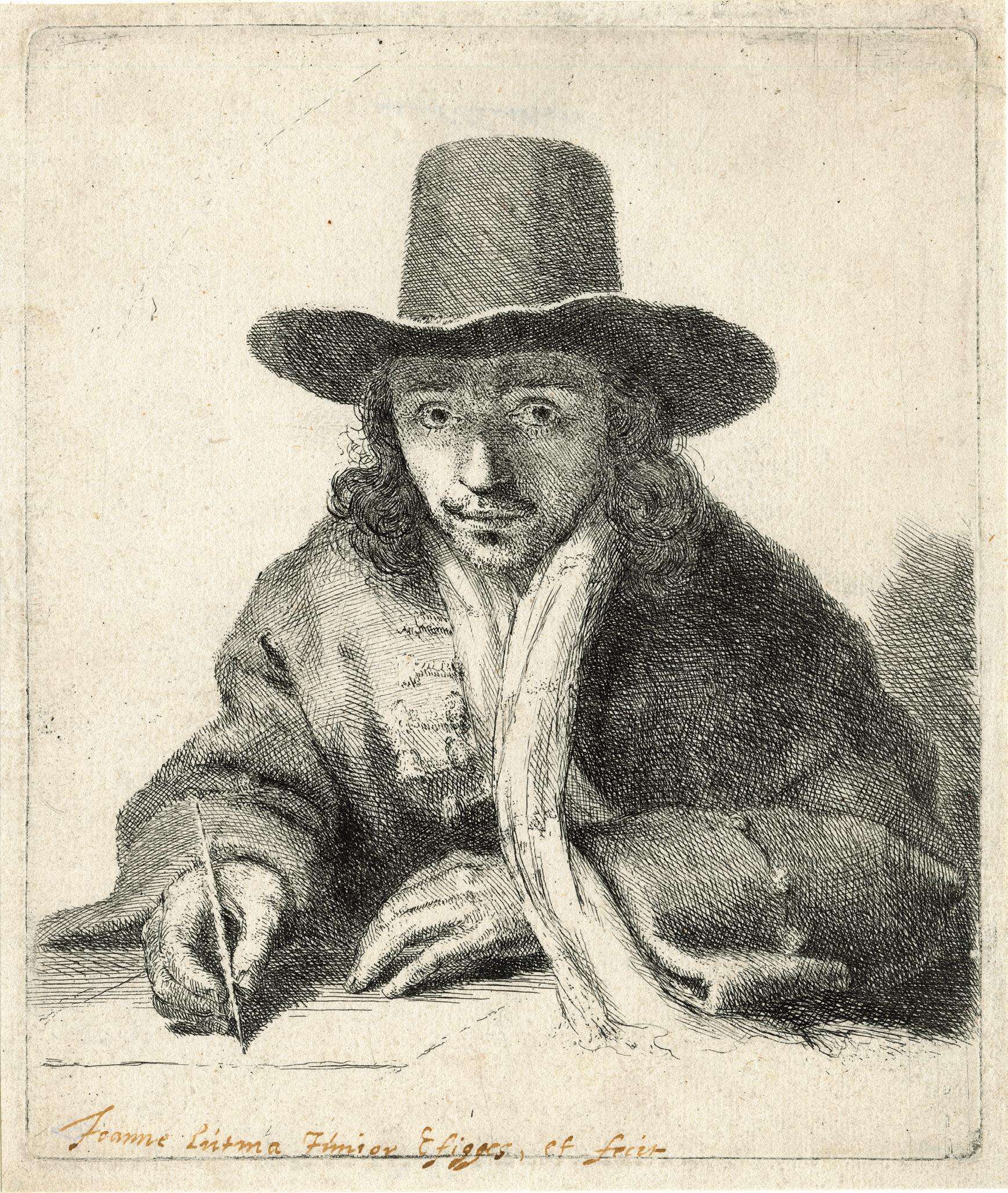
43
20 Gabriel Perelle 1604 Vernon – Paris 1677
The Pont Royal of Tuileries, Seen from the Pont Neuf
Etching on laid paper, ca. 1660
Inscribed (by Nicolas Langlois’ hand?) in the center Le Pont Roial des Thuileries veu du Pont neuf
Plate 223 x 320 mm
Provenance Bibliothèque nationale de France, exchanged in 1976; Galerie Paul Prouté; Private collection, France
This work is a superb impression, before all letters, with a handwritten title and privileges. It comes from a composite album of doubles kept at the Bibliothèque nationale de France that was transfered to the Galerie Paul Prouté in a 1976 exchange. The album preserved mainly prints by the Perelle family printmakers, i.e. Gabriel, Nicolas, and Adam Perell; and prints by Israël Silvestre, Louis Meunier, Michel Le Bouteux, and Franz (François) Erlinger, the closest associates to the Perelle family. Most of those prints were published in the Perelle albums, such as the Veües des Belles Maisons de France, Les Places, Portes, Fontaines, Eglises, et Maisons de Paris, published in the 1680s–90s by Nicolas Langlois, Rue St. Jacques.
Several of the impressions in the album, like the present object, were printed before letters, with the same handwriting for titles and privileges. Le Pont Roial des
Thuileries veu du Pont neuf was later published in ca. 1660-70 with letters in the Veües des Belles Maisons de France (actually only views of Paris), with some variants in color (See Brunet IV, p. 494 and Fowler, no. 245).
In France under Louis XIV, Gabriel Perelle was the quintessential printmaker of landscapes and outdoor views, of which we have a prodigious number. These works demonstrate the fertility of his invention and an extraordinary facility of execution, rather than a merely observant study of nature. Heir to Callot and at the crossroads of Flemish and Italian traditions, Perelle is often considered the Hollar of France, both in his manner of engraving and the esteem in which his works are held. About the Perelle family, see Marianne Grivel, Le Commerce de l’estampe à Paris au XVIIe siecle, Genève, Droz, 1986, pp. 147-150.
44
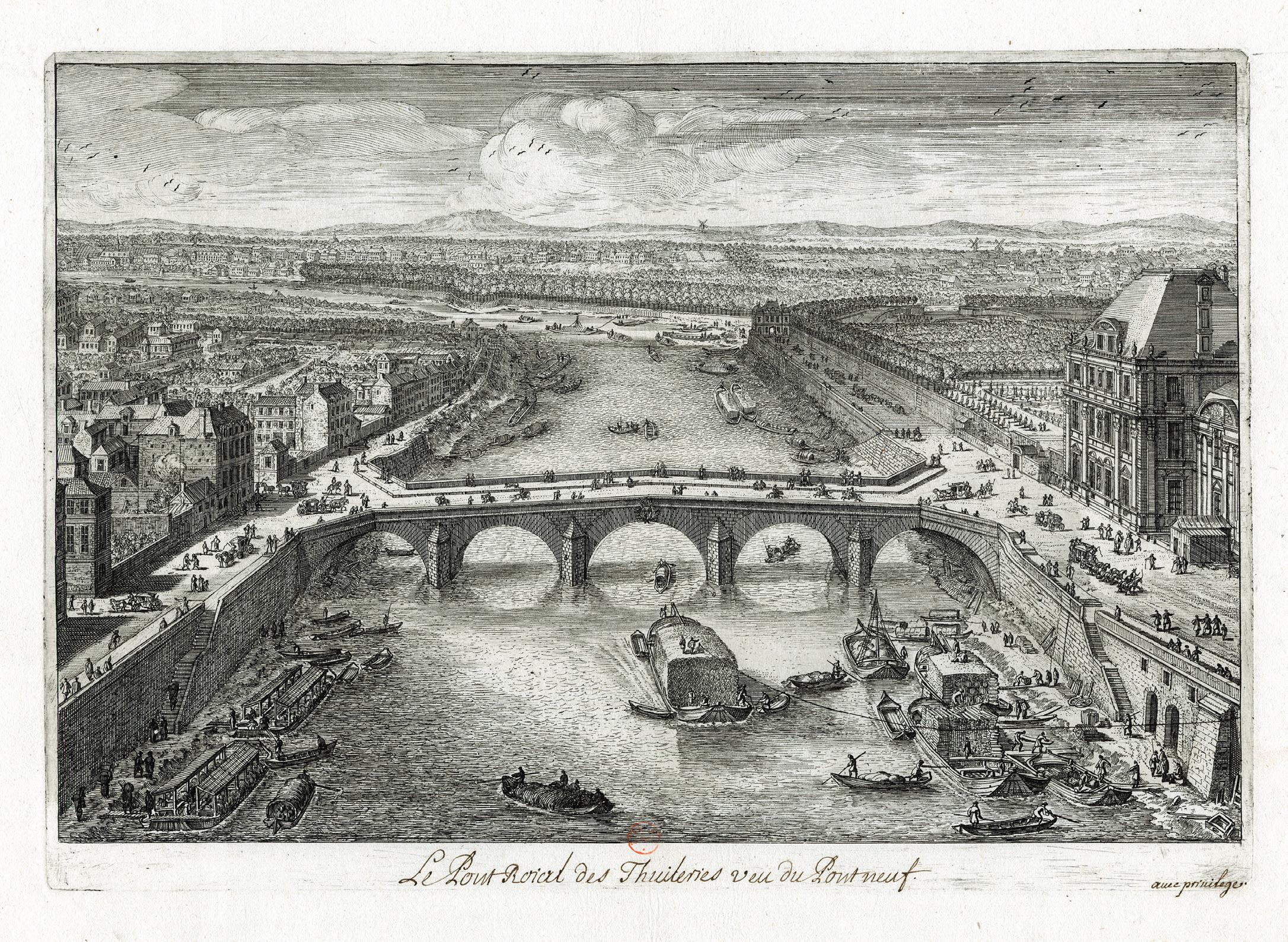
45
21 Francisco Jose de Goya y Lucientes 1746 Fuendetodas (Aragonia) – Bordeaux 1828 The Garroted Man
Etching and engraving on wove paper, ca. 1778-80
Plate 330 x 210 mm
Reference Harris 21 III, 2nd edition of four Provenance Private collection, France
Condition In fine condition
“This appears to be Goya’s first distinctive composition in etching and is the earliest plate which really records his genius. It is executed by the same technique as his Copies after Velázquez and is therefore probable that they were made and published about the same time” (Harris, p. 41).
Juliet Wilson Bareau calls this work “a print of extraordinary originality” and great intensity. She notes that it succeeds “in conveying an overwhelming impression of suffering and death. The face, originally etched in the delicate manner of the (now faded) drawing [in the British Museum – the drawing was incised for transfer], was later ‘battered’ with an engraving tool to blunt the precision of the fine lines ad increase the tragic sense of destruction in the sagging features” (J.W.B., Goya’s Prints. The Thomás Harris Collection in the British Museum, London 1981, p. 15).
Although the subject has sometimes been described as a prisoner of the Inquisition, this is most likely not the case. The prisoner is not dressed as the Inquisition garbed its prisoners; instead, he wears a Carmelite scapulary such as were given by religious orders to lay devotees. Garrotting was rare in Spain at the time of Charles III’s reign. Of the wretches whose crimes demanded capital punishment, the number of those garrotted was smaller still, for this particular means of execution was actually considered a privilege. More gentlemanly than hanging, it could be claimed by Hidalgos, people entitled to the rights of nobility.
Contemporary travellers and clergymen wrote descriptions of the process. Relations of the Hidalgo
who viewed the trial could present a petition to the judges, engaging to pay the expenses attending the execution of a nobleman. Alongside the scaffold, the garrotte, and the cortège of priest, notary, and soldiers, the convict is dressed in a loose gown of baize. The sentence being executed, four silver candlesticks, with burning wax-candles of proportionate length and thickness, were placed at the corner of the scaffold; in about three hours, a suitable funeral was conducted by the friends of the noble convict. A due certificate was given to the surviving parties to be recorded among the legal proofs of their rank. In this print, Goya describes a situation that has somehow impressed him, whether by the slowness of the execution, by the privilege that is granted to a certain caste, or by a practice that seems more acceptable than hanging.
The present work is a fine impression from Harris’s so-called second edition, before bevel and printed on a smooth, absorbent, wove paper, characteristic of this printing. The present impression is, for instance, better than the Boston second-edition impression. The hairs are still good, and the definition is fine. As Harris noted, the print-run of this plate appears to have been small, and it is indeed very rare on the market and in private collections. Harris was unaware of the unique proof in the Metropolitan Museum of Art, before the addition of engraving to strengthen the hair of the garrotted man. Thus, our impression and indeed all impressions other than the Met’s should be described as the second of two states.
46
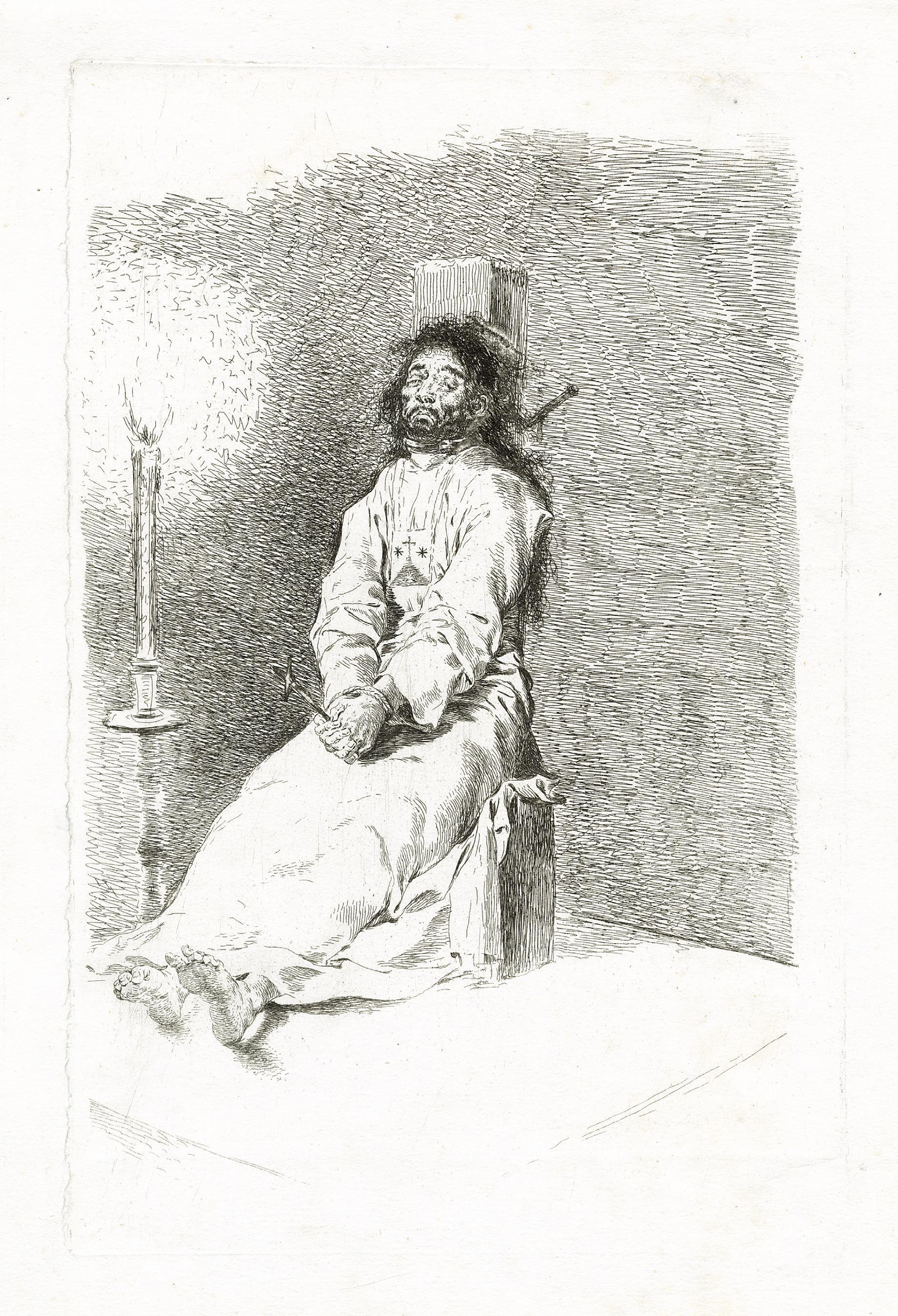
47
22 Adam von Bartsch 1758 – Vienna – 1821 Self-Portrait
Etching on laid paper, 1785
Plate 168 x 127 mm
Reference Le Blanc 375 5th (final) state; Rieger 14, 6th (final) state
Provenance Private collection, Germany Condition In very good condition
This is a very fine impression of Adam von Bartsch’s 1785 Self-portrait, in the sixth and final state, with the background etched. Bartsch had joined the staff of the Royal Court Library in Vienna in 1777, after studying engraving at the Kupferstecheracademie in Vienna. Later, in 1791, he would become the chief-curator of the Royal Printing House, and then the advisor to Duke Albert of Saxe-Teschen, who founded the Albertina collection in Vienna. In 1803, he began publishing his renowned catalogue of old master prints, Le PeintreGraveur, which continued until 1821. Through all these activities (one can imagine that writing the PeintreGraveur took up a considerable amount of his time), he never stopped producing more than 600 plates of his own design or after other masters.
Bartsch now is regarded as the forefather of modern graphic research, for he not only formulated fundamental ideas on the systematization of prints, but also created a fundamental corpus work with his Peintre-Graveur, which still represents the starting point for the study of graphic art from its beginnings to the eighteenth century. Bartsch was surely an outstanding representative of a new type of scientist and artist influenced by the Enlightenment.
48
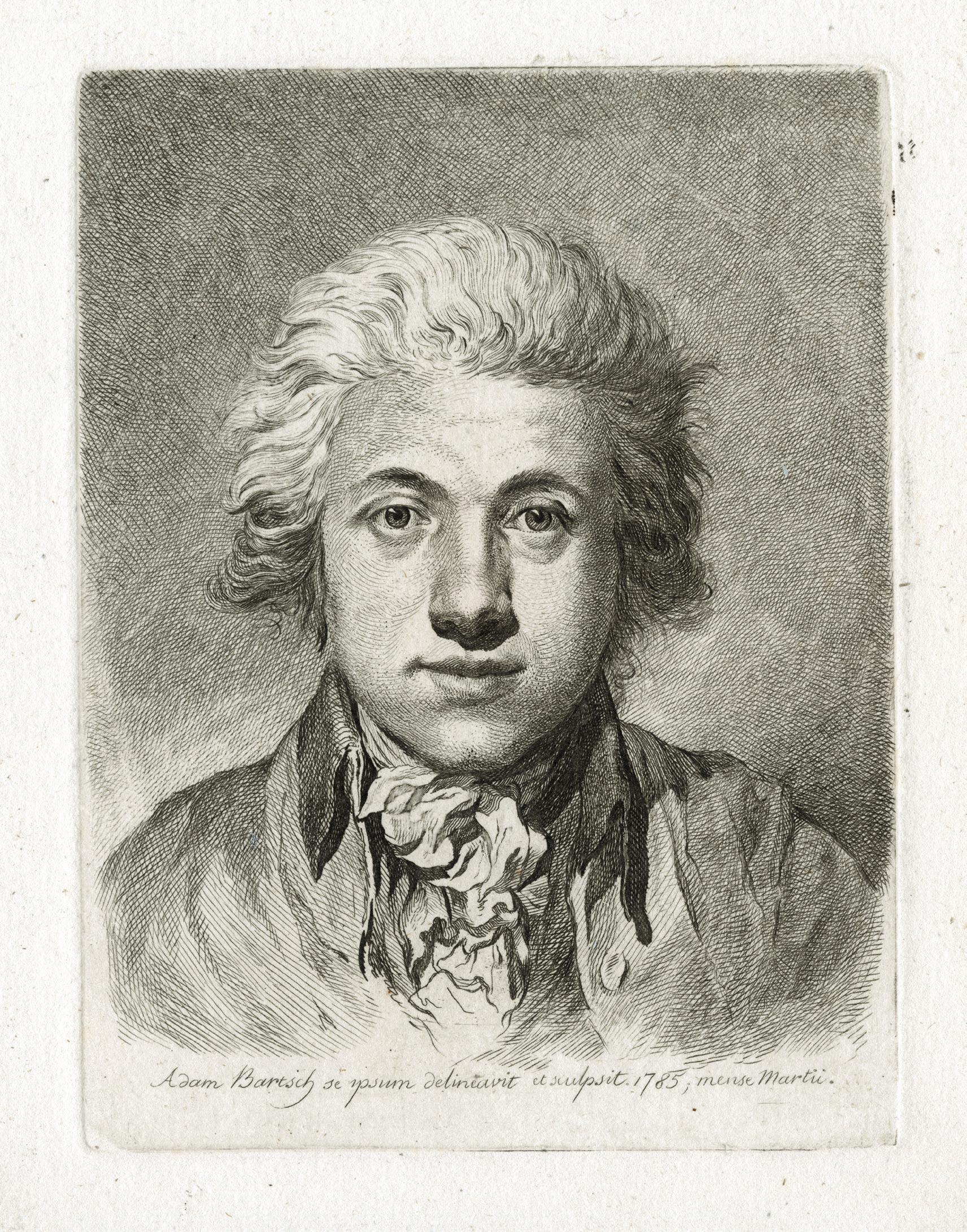
49
23 Villeneuve Late 18th c. French printmaker
Louis le Ttraitre lis ta sentence
Etching and aquatint on laid paper, ca. 1793
Plate 270 x 190 mm
Reference Hennin, 11427; De Vinck, 5209
Literature Annie Duprat, “Autour de Villeneuve, le mystérieux auteur de la gravure La Contre-Révolution”, in Annales historiques de la Révolution française, no. 309, 1997, pp. 423-439 (mentioned on p. 430)
Provenance Private collection, France Condition In very fine condition
Louis le Traitre lis ta sentence. Dieu a calculé ton reigne et la mis afin. tu as-été mis dans la Balance et tu as-été trouvé trop léger…
This is a fascinating image, an example of the vigorous production of insurgent imagery in France during the Revolution. At first sight, it seems that only the publisher is mentioned at bottom: A Paris, chez Villeneuve Graveur, Rue Zacharie St Severin Maison du Passage N°72 (in the rue Saint-Jacques district, which since the 17th century was a meeting place for the papermakers, printers and printmakers of Paris). Yet the present plate belongs to a group of prints signed as Villeneuve Graveur, who was among the most blood-thirsty printmakers of the Revolution at the onset of the Reign of Terror. The consistency of style among his prints suggests that he was their designer and printmaker as well as their publisher. Like most of his revolutionary prints, this plate also seems to be exceedingly rare. We have been able to record only other two impressions: one at the Musée Carnavalet and the other at the Bibliothèque nationale de France.
The letter quoted in this work was taken from a brochure entitled Réponse d’un sans-culotte aux réflexions de Necker sur le procès de Louis Capet, signed by one “L. Durocher,” with no date. This was intended as a response to the Réflexions présentées à la nation française sur le procès intenté à Louis XVI, published in 1792 by Jacques Necker, Louis XVI’s former finance minister, who was a royalist but still had some sympathy among the revolutionaries. In this
print, in all its aesthetic classicism, we cannot help but see the strong arm and the quill in hand of David’s Marat.
It’s worth noting the guillotine in the centre of the letter, with the words “Elle attend le Coupable…,” as if the execution had not yet taken place at the time of publication. These kinds of images, intended as caricatures or illustrations for the press, were sometimes produced on the day of the event itself or in the days immediately following. We know that when the sentence was read out, Louis XVI immediately asked for a three-day reprieve, which was not granted. Once the result of the judgement was known to the public, popular passions flared against or for the condemned Capet. Following this hypothesis, the print could be dated to the first few weeks of January, as the King was executed on Monday, January 21, 1793.
Annie Duprat has ably described the mystery surrounding the work of the printmaker and dealer Villeneuve, who was already a powerful publisher by 1791. Yet two centuries later, we still do not know his first name, his date of birth and death. It has been assumed that he arrived in Paris from Bordeaux in 1789, but there is no definite proof. Duprat found convincing evidence of Villeneuve’s political activity as a revolutionary citoyen within the Thermes-de-Julien section, which was responsible for supervising the printers and printmakers in the SaintJacques district. The artist regularly took part in the deliberations of his section and seemed to have had the “ear” of the section’s leaders.
50
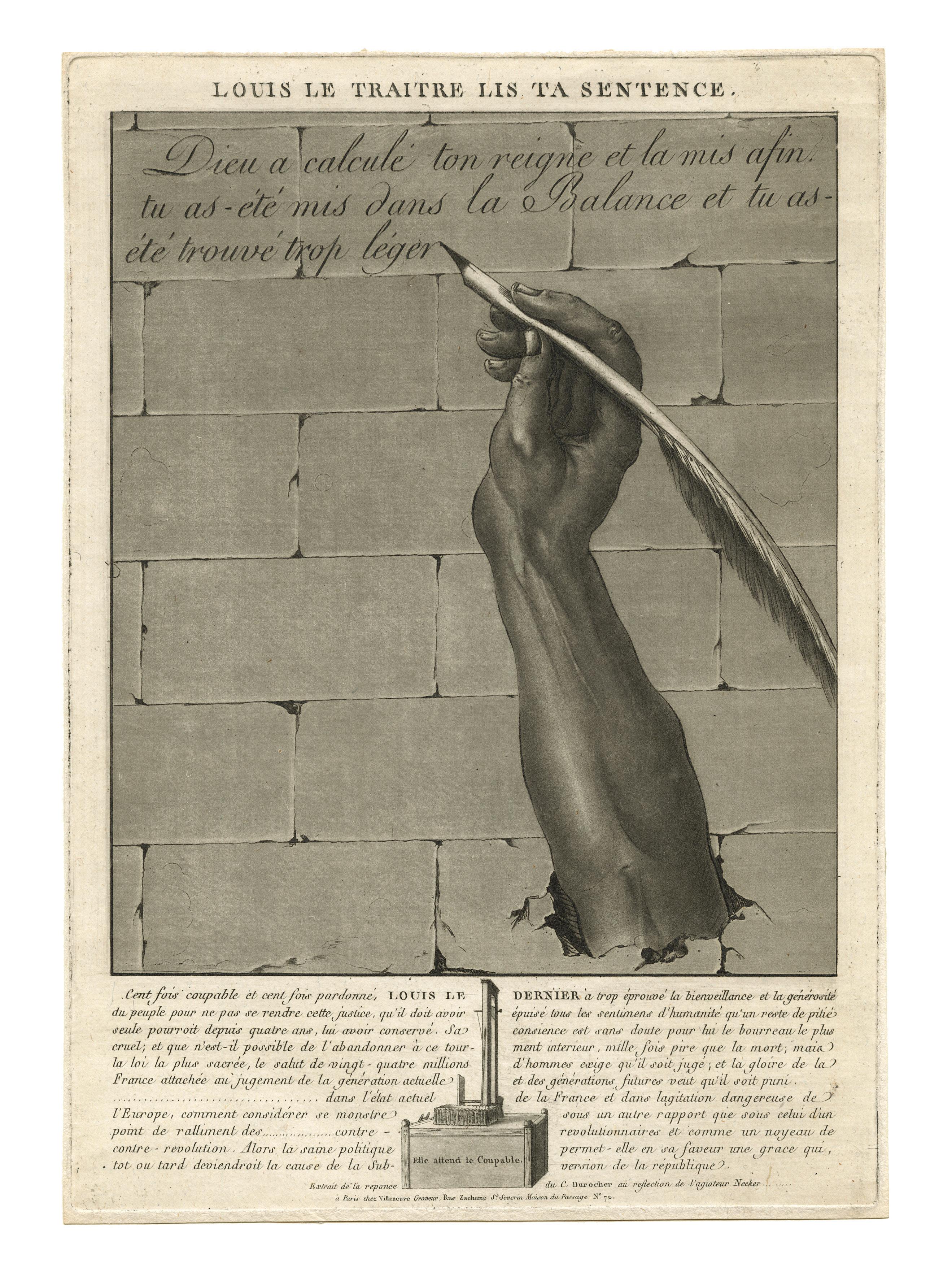
51
24 Edme Quénedey 1756 Riceys-le-Haut – Paris 1830
Portrait of Wolfgang Amadeus Mozart
Etching and aquatint on wove paper, ca. 1808-1813
Plate 240 x 175 mm
Reference Portalis & Beraldi, vol. 3, p. 365
Literature René Hennequin, Edme Quenedey: Portraitiste au physionotrace. Seconde partie: son œuvre (1788-1829), Troyes, 1927, pp. 125-126
Provenance Private collection, Germany
Condition Trimmed into the platemark, but otherwise in fine condition
The portrait painter and etcher Edme Quénedey first worked in Paris as a portrait miniaturist and joined the workshop of Gilles-Louis Chrétien in April 1788. Chrétien had developed the process of the physionotrace in Versailles since 1786, which used an apparatus similar to a silhouetting chair for the rationalised production of profile portraits. The idea was to hew as close to reality as possible in an efficient and productive manner. Quénedey was initially responsible in the studio for making the portrait drawings, which were later etched by Chrétien. The studio produced an astonishing number of more than 1,800 portraits.
After disagreements between the two artists, however, Quénedey set up his own workshop as a physionotracist in Paris at the end of 1789. In 1796 he settled in Hamburg for five years and then came back to Paris, continuing the production of such portraits. Considering the huge number of plates, we could have expected to see a lot of those portraits by Chretien and/or Quénedey in public collections or coming up for sale, but amazingly, this has not been the case. One reason for this is that this particular kind of portrait was usually produced in only one or very few copies for an exclusively private purpose – for the pleasure of the person depicted, or for the discreet use of someone within his or her close circle. These miniatures were quite small, around 6-7 centimeters of circumference, and we can assume that most of them were thrown away after the death of the sitter. Today they are mostly found in the collections of
the Bibliothéque nationale de France and of the Musée Carnavalet.
Alongside this almost unique output, Quénedey produced a small series of images of varying size, intended to be published and sold as such, usually portraits of artists or of famous people in France. Among those, between 1808 and 1813, there is a series of portraits of important composers, to which the present portrait of Mozart belongs. At first glance, the picture fits in seamlessly with the other physionotrace etching portraits of Bach, Kreutzer, Spontini and others. Yet the Mozart actually seems to hold a distinct position, for the present sheet probably did not result from the physionotrace process. Rather, the caption “Dess. et gravé par Quénedey, d’après un portrait en Allemagne” indicates that a painted or drawn portrait of the great composer served as a model for Quénedey. It is possible that Mozart’s portrait laid the foundation for the later series of composer portraits that were sold in Paris in neighbouring music shops, among other places. Yet those images remain very rare; we had never seen an impression of the Quénedey’s Portrait of Mozart until now, let alone one being offered on the market.
This portrait is close to the likeness we know of the musical genius from the few extant contemporary portraits. It seems to us to show Mozart around 1780, when he returned from Paris to Salzburg and began a new life as an independent composer.
52
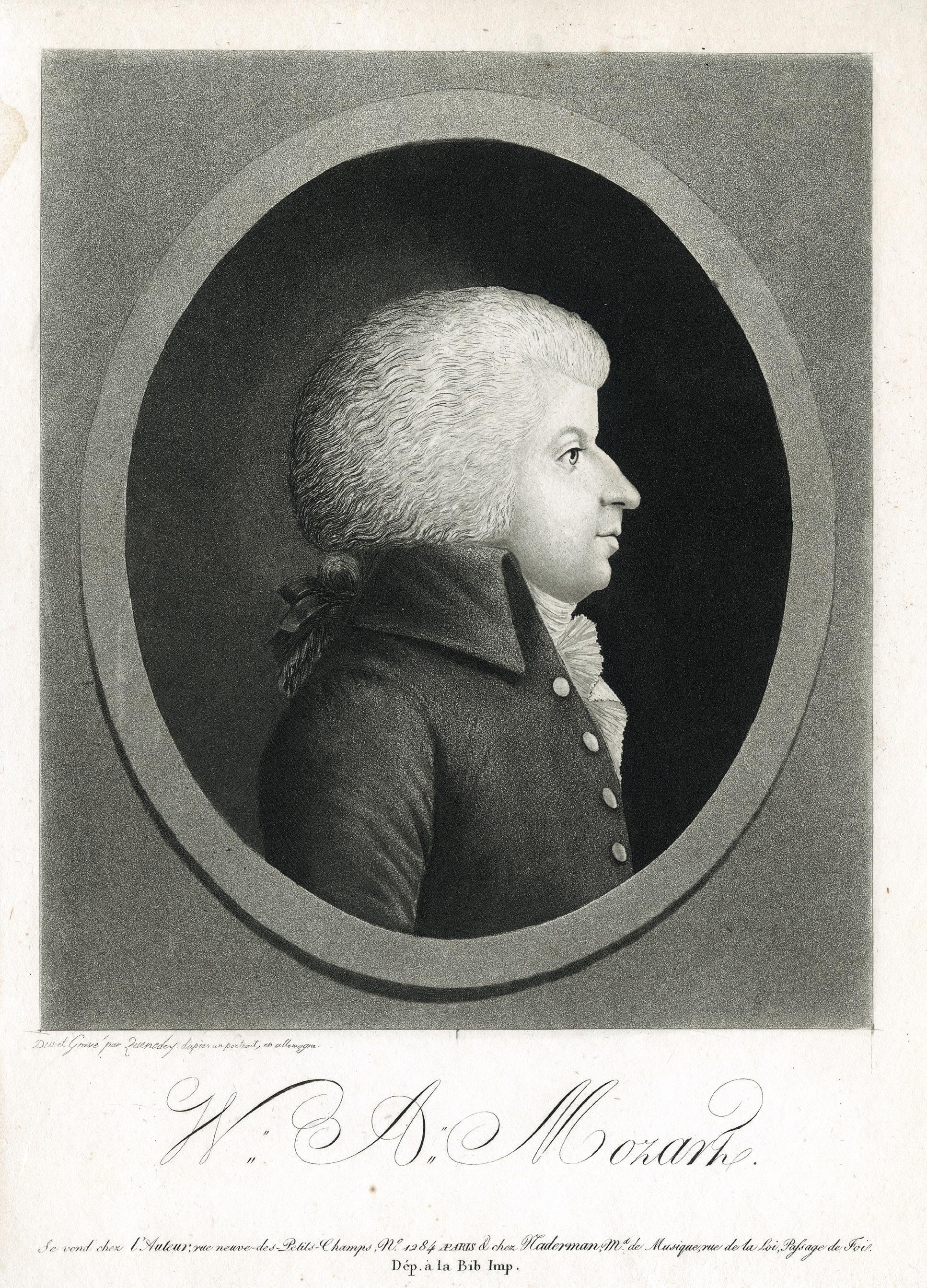
53
25 James Whistler 1834 Lowell – London 1903
La vieille aux loques
Etching and drypoint on laid paper, 1858
Plate 207 x 147 mm
Watermark foolscap
Reference Kennedy 21, 1st state of three; Glasgow 27, 2nd state of four
Provenance Jules Gerbeau (Lugt 1166); his sale, Strölin, Paris, May 25 -27, 1908; Kennedy Galleries (their stock no. in pencil on verso a45616); Howard Mansfield (Lugt 1342); Harris Whittemore (Lugt 1384a); The Fine Art Society; Private collection, France
Condition In fine condition
This is a very fine, early proof of the first state, before the addition of various shading and hatching lines, as well as the address of the printer Delâtre, which was added for its edition in 1858 of Douze eaux-fortes d’après Nature [Twelve Etchings from Nature], often called the “French Set.” In its first state, La Vieille aux Loques is exceedingly rare. The Glasgow census indicates no early proofs among major Whistler collections (such as those of Chicago, Baltimore, the British Museum, the Bibliotheque nationale de France, the Colby College Museum of Art, the Boston MFA, the Fogg, the Freer, the Hunterian, Cleveland, and the Metropolitan Museum of Art), with the exception of the Library of Congress (first state, not known to Kennedy) and the New York Public Library (second state, cited by Kennedy).
Though Whistler represents an old woman, perhaps worn out with work and age, in a poverty-stricken environment, he also shows her as a respectable worker, with well-maintained kitchen equipment stored neatly on shelves. This composition, probably etched in Paris,
is of course related to his other doorway or interior etchings such as The Rag Pickers, La Marchande de Moutarde, and The Kitchen, and, as Katharine Lochnan has pointed out, it relates to a tradition in Dutch art of compositions framed by doorways.
The provenance is quite interesting, listing Howard Mansfield as a previous owner. He was the author of the catalogue raisonné of Whistler’s etchings (1909) and had a superb collection of the master’s etchings and lithographs. This collection, one of the best in existence, passed at the beginning of 1919, through the intermediary of A. Hahlo & Cie, to the amateur Harris G. Whittemore, in Connecticut, for a price said to be between $300,000 and $350,000, a huge amount at the time. It comprised 582 sheets, including 370 etchings in 420 proofs, and 158 lithographs in 162 proofs. Mansfield had known Whistler intimately, had often accompanied him on his working excursions, and had benefited from the artist’s own advice on his choice of proofs.
54
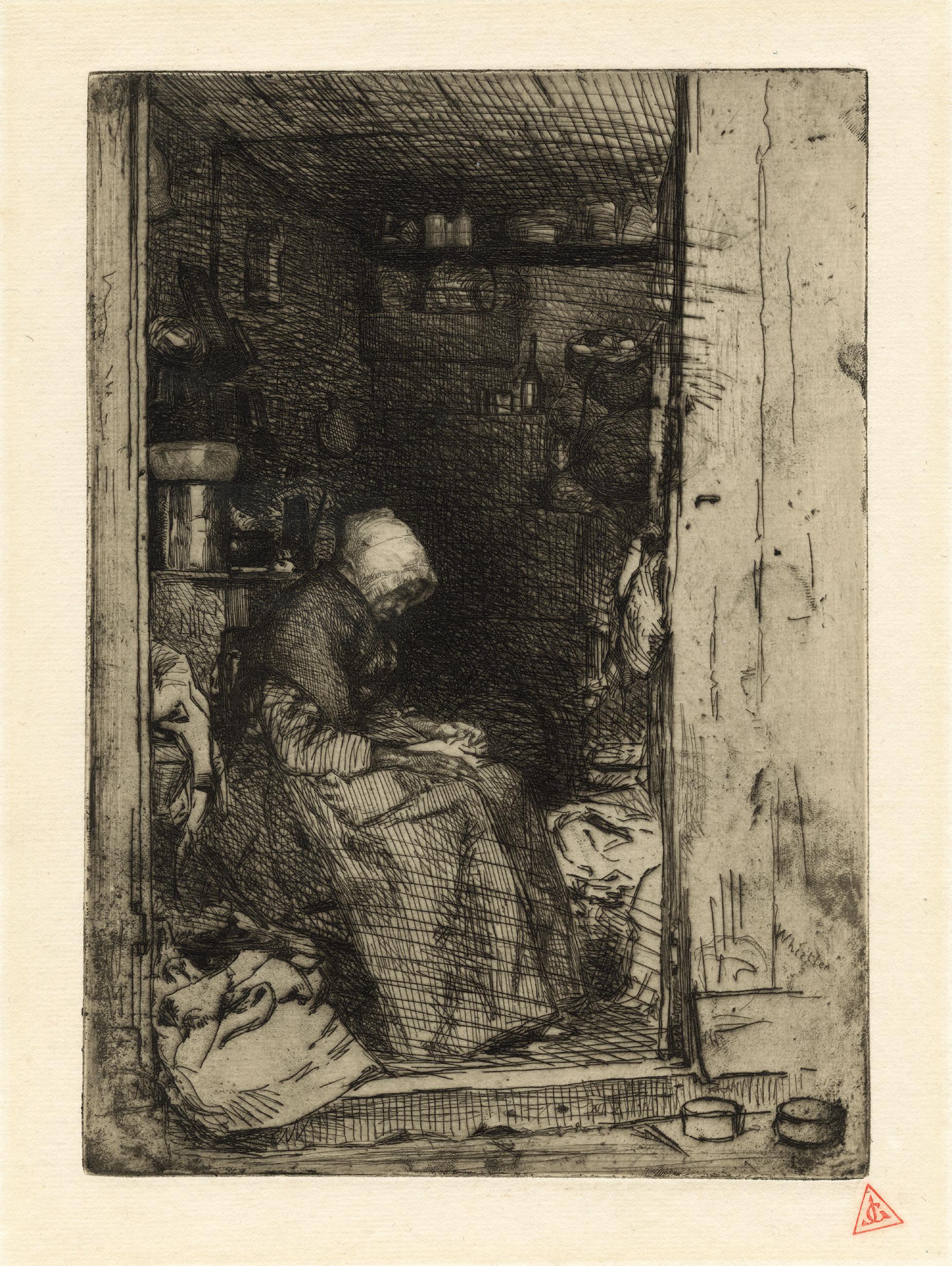
55
26 Edouard Manet 1832 – Paris – 1883
Don Mariano Camprubi
Etching on Chine paper, ca. 1862-63
Plate 297 x 190 mm
Reference Guérin 24; Harris 34; Fischer 27; Wilson-Bareau 35
Provenance H.M. Petiet (Lugt 5031); Private collection, France
Condition Pristine condition
This is an exceptional impression on Chine volant of this rare print, from the 1863 printing. The plate was included in the album Eaux-Fortes, five copies of which, according to Jean C. Harris (p. 29), was supposed to have been printed for Manet’s own use; the print was not again published in his lifetime. The present impression, one of those printed during Manet’s life, is thus very rare. The bon à tirer is kept at the Bibliothèque nationale de France.
Mariano Camprubi was the principal male dancer in the Spanish ballet, and he was older than the other dancers and the choreographer at the time of Manet’s portrait. He performed in Paris as early as 1834 and was well known to the Parisian public. He was the star of the troupe of Spanish dancers, along with Lola de Valence, who returned to Paris in August of 1862.
The present etching was made after a painting Manet executed around the same time as the portrait of Lola in autumn 1862. The etching differs from the painting in certain ways. Like most of Manet’s etched copies of paintings, the image is in reverse. The baïlarin here wears a hat different from that of the painting, which is broader and does not have a chin strap. The figure here also seems stockier in his proportions than in the oil. The broad, linear, and tonal style of this print is remarkably different from that of other prints by Manet of this period. In making this etching, perhaps working directly on the plate from the painted model, Manet remained captivated by the vigorous style of the original, and he drew in a manner entirely different from that of his contemporary etching of Lola de Valence.
56
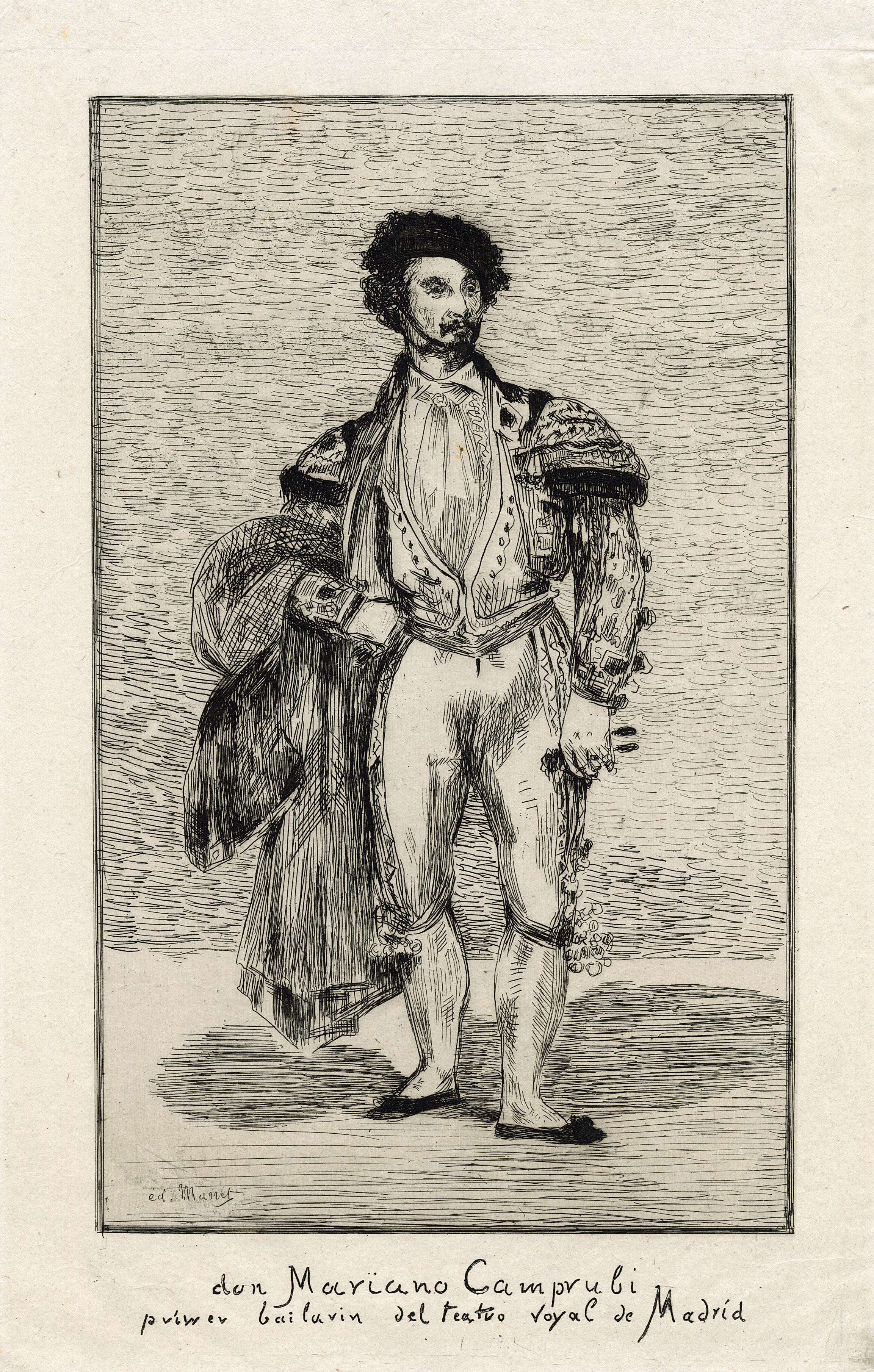
57
27 Honoré Daumier 1808 Marseille – Valmondois 1879
Nadar Elevating Photography to Art
Lithograph on magazine wove paper, 1862
Image 273 x 222 mm
Reference Delteil 3248, 1st state of two Provenance Private collection, France Condition In perfect condition
Published in its original version in the Boulevard on May 25, 1862, this is a fine first state impression of one of the most iconic lithographs by Daumier, showing Nadar “elevating” photography to the level of fine art. Delteil described it as “rare.” The only difference between the two states is the addition of the letters Souvenirs d’artistes on the upper left, and the number 367 on the upper right.
The image could be seen as a promotion of the photography of Félix Tournachon, called Nadar, who took the first photograph from the air in 1858. Indeed, later on, this composition became the most representative image of Nadar and his adventurous
projects. In fact, this image was completed by Daumier following a court decision in 1862 that permitted photographs to be considered works of art. Daumier depicts Nadar as a bizarre, ambitious, risk-taking photographer. His hat is flying off, and in his own excitement to capture the perfect shot he almost falls out of his balloon. Using the metaphor of the balloon in the air, Daumier laughs at Nadar, and he mocks the voguish idea that photography could be equal to “high art.”
In a way, the image also foreshadows modern aerialsurveillance photography, as Nadar’s balloon was used in the 1870 Siege of Paris for intrusive photography.
58
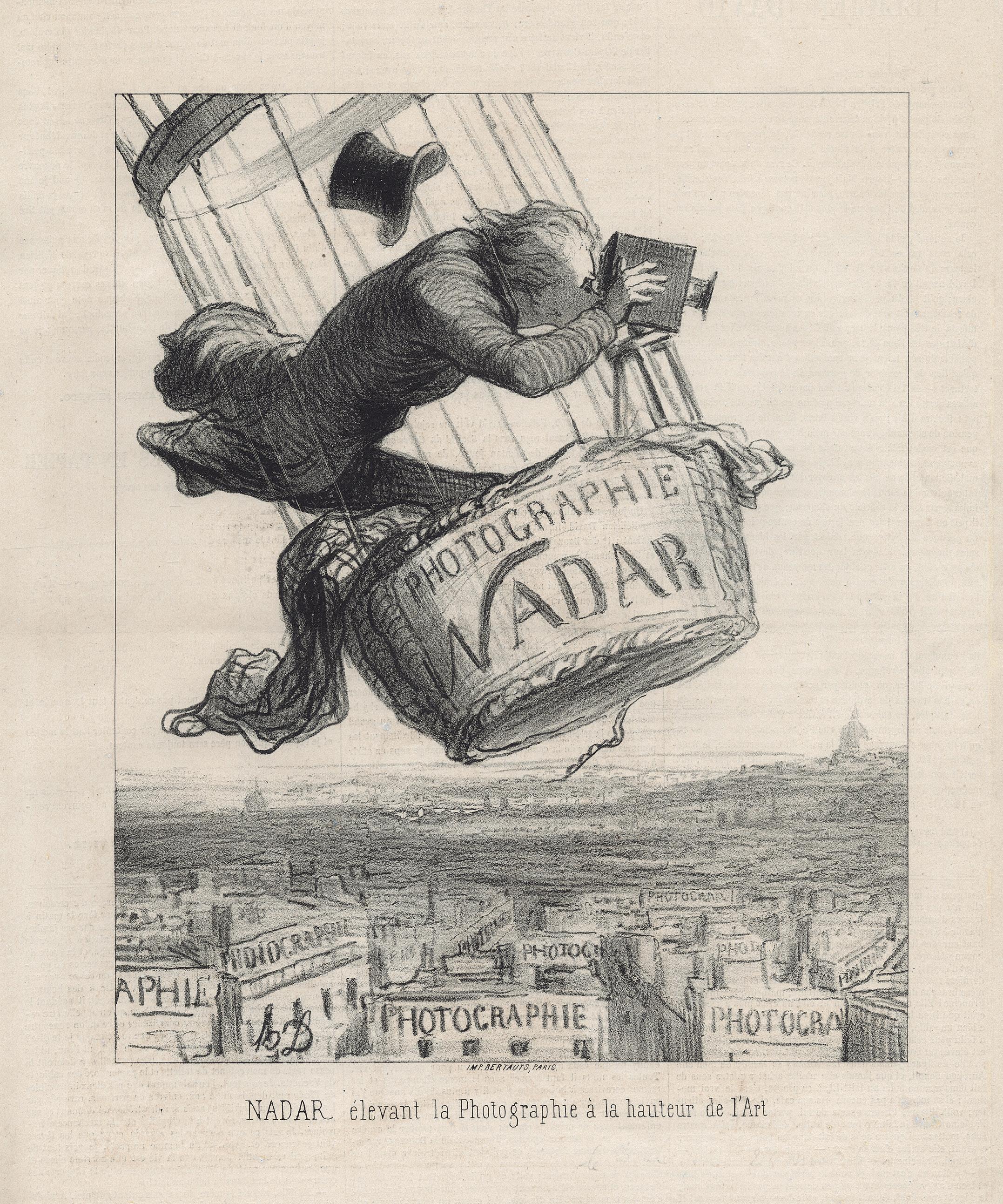
59
28 Edgar Degas 1834 – Paris – 1917
Edouard Manet, Bust-length Portrait
Etching, drypoint and aquatint on laid paper, ca.1864-68
Plate 129 x 105 mm
Watermark H b (fragment)
References Delteil 14; Reed – Shapiro 19, 3rd state of four Provenances Atelier Sale, Paris, 22-23 November 1918, no. 10 (Lugt 657); Loÿs Delteil, Paris, bought at the sale for 480fr; Private collection, France
Condition In very good condition
A very fine, strong yet sensitively printed impression, this work is a trial proof of the third state before the aquatint. It is a rare print in any state (Shapiro listed four known examples of the first state, with etching only; one example of the second, with drypoint touches added; two examples of the third, with added etching on the coat and in the background; and six examples in the fourth state, with added aquatint). Of the two third state impressions listed by Shapiro, one is at the Metropolitan Museum of Art (inv. 49.127.7); the second was located in a private collection, Germany, annotated Degas 1868, but has never been seen since. To those we can add the present work described in the Atelier Sale catalogue as “Deuxième état [now the 3rd], le fond et l’habit ombré, mais avant le grain d’aquatinte. Épreuve nature.”; and another impression also at the Atelier Sale, described as “épreuve retroussée.” So, a total of four known impressions.
This work is a seminal moment in the history of printmaking. This is the most expressive and the strongest of the three portraits of Manet that Degas did at the same time. The work’s modelling is firm and direct, almost hard; the sharpness of the point, the frank reserves giving way to a broad, purposeful forehead. In an unexpected dialogue between portraitist and sitter, Degas alludes to the radical nature of Manet’s own work. Of the three portraits, this is also the one with the highest resolution, as the plate was not burnished in its later states, as was unfortunately the case for the two others. The unusual vigour of this plate is also reminiscent of the printed portraits by Alphonse Legros or James A. M. Whistler, notably that which depicts the sculptor Charles Drouet in 1859. There was no preparatory drawing for our print.
As the last of a series of ever more striking portraits, Degas’ engraving of Manet is pivotal entry in the artist’s graphic œuvre. With the exception of three early little landscapes, all of Degas’ prints prior to the Manet portraits are of family, friends or himself. In the mid1860s Manet also sat several times for Fantin-Latour and had his photograph taken by Nadar in 1865. The date proposed by Shapiro of 1864-65 for the three Manet portraits could perhaps be a year or two early; if so, the print would have coincided more with Degas’s portraits of his friends Gustave Moreau (Lemoisne 77) and James Tissot (Lemoisne 175). Henri Loyrette, in the 2016 Melbourne exhibition catalogue, Degas: A New Vision (see p. 51), and Ashley E. Dunn, in the recent Orsay exhibition catalogue, Manet / Degas, suggest the same and dated them ca. 1868 (see cat. nos. 5-8, 10-11).
Between the legends and the facts, there is so much to say about the relationship between Manet and Degas: about their mutual admiration, their rivalry, their opposing temperaments, their amicable frustrations (especially for Degas), their aesthetic ambition, and their strategic choices, which made them the key players in the pictorial revival of the 1860s-1880s. Theirs was a constant and fruitful artistic dialogue. They recognised and appreciated one another yet were suspicious of each other’s talent. The Musée d’Orsay and the Metropolitan Museum of Art have devoted in 2023 a great exhibition to this matter, Manet / Degas, with a catalogue of more than 250 pages.
60
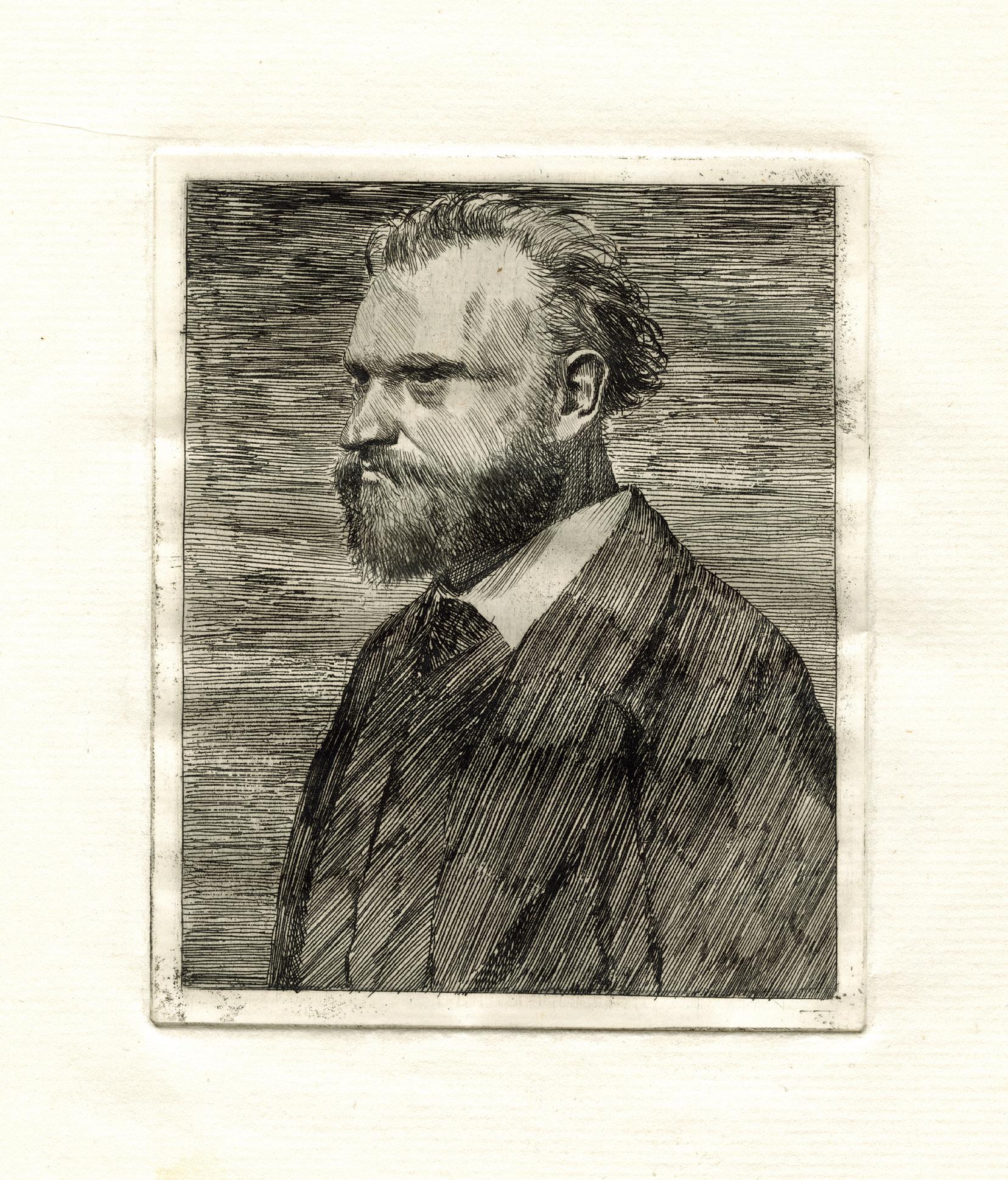
61
29 Edgar Degas 1819 Ornans – La Tour-de-Peilz 1877 The Little Dressing Room
Drypoint on wove paper, ca. 1879-80
Plate 119 x 79 mm
Reference Delteil 34; Reed & Shapiro, 41, 5th (final) state
Provenance Alexis Rouart, Paris (Lugt 2187a), Henri Rouart, Paris; Amboise Vollard, Paris; Henri M. Petiet, Paris (Lugt); Richard L. Feigen, New York; Private collection, Europe
Condition
In very good condition
This is a very beautiful impression of The little Dressing Room, which is in our opinion the best of Degas’ two etched renderings of a prostitute in a brothel, getting ready after her bath. It is a very rare plate. Reed & Shapiro knew only of four impressions of its fifth state, held in the collections of the Art Institute of Chicago; Bibliothèque d’Art et d’Archéologie Jacques Doucet (INHA), Paris; the British Museum, London; and the Kupferstichkabinett, Staatliche Muzeen, Berlin. To these four we can now add the present work. In total there are only thirteen known impressions across all the five states. The present impression is even better than the one at the INHA (Paris), and it is comparable in quality to the one at the Art Institute of Chicago.
Although it was customary for Degas to render his brothel scenes in the medium of monotype, in this rare instance he has executed a small drypoint in which
a bather is transformed through progressive states of the print into a prostitute. In the first stage, the sketch indicated a nude figure in an unspecific setting that reaches a washbasin; she could be any young woman performing her ablutions. By the fifth state; the shapely figure, ornamented with bracelet and neckband, stands by the open door of a highly decorated room. Her hand, now moved to the side of the washstand, extends as if to welcome the visit of a client. There is a decided change in presentation and content.
It is worth mentioning the work’s provenance, beginning with Alexis Rouart. Rouart and Degas were very close friends, and they spent a lot of time together discussing the art of printmaking. Rouart had many impressions of Degas’ plates, in early and later states. It is even supposed that Degas made a few drypoints at Rouart’s home.
62
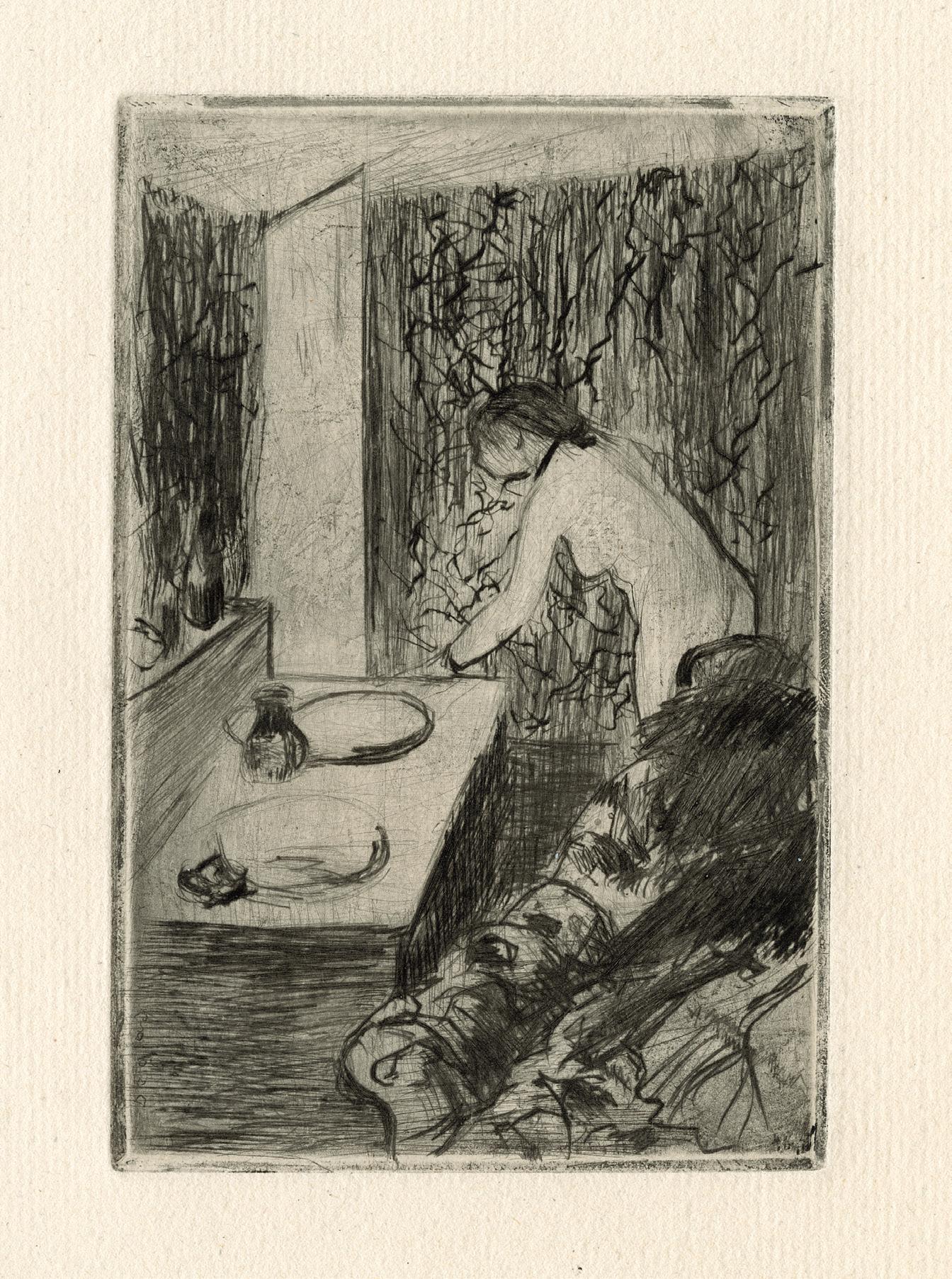
63
Death of Proudhon
Lithograph printed beige Chine collé on wove paper, 1868
Images 213 x 215 mm
Literature Frédérique Thomas-Maurin, Lonnie Baverel, Séverine Petit, Gustave Coubert. Les Dessins, Paris, Les Cahiers dessiné, 2019, pp. 294-295 (ill.)
Provenance Private collection, France Condition In fine condition
This is an extremely rare impression of the nevertheless famous Courbet lithograph and portrait of PierreJoseph Proudhon on his deathbed. It is a rare testimony to the intellectual connection between the great thinker of anarchism and libertarian socialism, and the champion of social realism in art.
We are aware of only two other impressions of this work: one is in the Bibliothèque nationale de France (De Vinck, 14469); the other is in the collection of the Musée Gustave Courbet, in Ornans. Courbet made his composition after a photograph taken by Etienne Carjat on January 19, 1865 (106 x 62 mm). It was supposed to be part of the thirty-fourth issue of the journal La Rue, edited by Jules Valles, who wanted to celebrate in January 1868 the third anniversary of Proudhon’s death. Yet as La Rue ’s teetered on the edge of bankruptcy, the printer Kugélman refused to publish the issue, precipitating the newspaper’s ultimate demise. Valles, however, had a few copies printed separately by Lemercier, in Paris.
Proudhon’s death on January 19, 1865, in his house at 12 Rue de Passy (Paris, 16th arrondissement), came as a shock to Courbet, who described himself as in a state of “mental prostration.” Courbet was not present at the philosopher’s death and felt terrible about it. A few days before his death, Gustave Courbet wrote to his friend Castagnary to confide in him his desire to paint a portrait of Proudhon at all costs: “This is extremely important. If he dies without his portrait, we will never have it, because of the indifference he has shown until now. And it is up to us to have it and to do it, as he deserves, for posterity.” The painter had always wanted to paint the philosopher, but the latter had always shied away from posing, even for L’Atelier
du Peintre. Courbet’s admiration, even fascination, for Proudhon was unparalleled in his own mind. On the day he learned of Proudhon’s death, January 24, 1865, Courbet wrote to Gustave Chauvey, a disciple and close friend of Proudhon: “The 19th century has just lost its pilot, and the man who produced him. We are left without a compass, and humanity and the revolution, adrift without authority, will once again fall into the hands of soldiers and barbarism.” Further on Courbet writes: “I don’t understand why you leave his head in the ground when I need it so badly. Have it made into a mask as soon as possible or send it to me in a tin box. Not only do I want to make his portrait, but also his sculpture.”
Later, in June 1865, the painter wrote to his parents at the time of the posthumous publication of Du principe de l’art et de sa destination sociale: “I have sent you the volume that P.-J. Proudhon has written about me. It is the most marvellous thing I have ever seen, and the greatest benefit and honour a man could wish for in his life. Nobody has ever been so lucky. A similar volume by a similar man about a similar individual? It’s staggering! All Paris is jealous and dismayed. It will increase my enemies and make me a man without equal!”
In a letter to Valles in January 1868 Courbet wrote: “You ask me if I would like to do a drawing of the dead Proudhon for the anniversary of 19 January. I accept wholeheartedly and eagerly seize this opportunity to offer a token of sympathy and admiration to the unparalleled good man who, born in the same country as me, was during his life my comrade and my friend.”
Robert Fernier assumed that there was a preparatory drawing in charcoal and white pencil, but this sheet has never been located or even confirmed to exist.
64
30
Gustave Courbet 1819 Ornans – La Tour-de-Peilz 1877
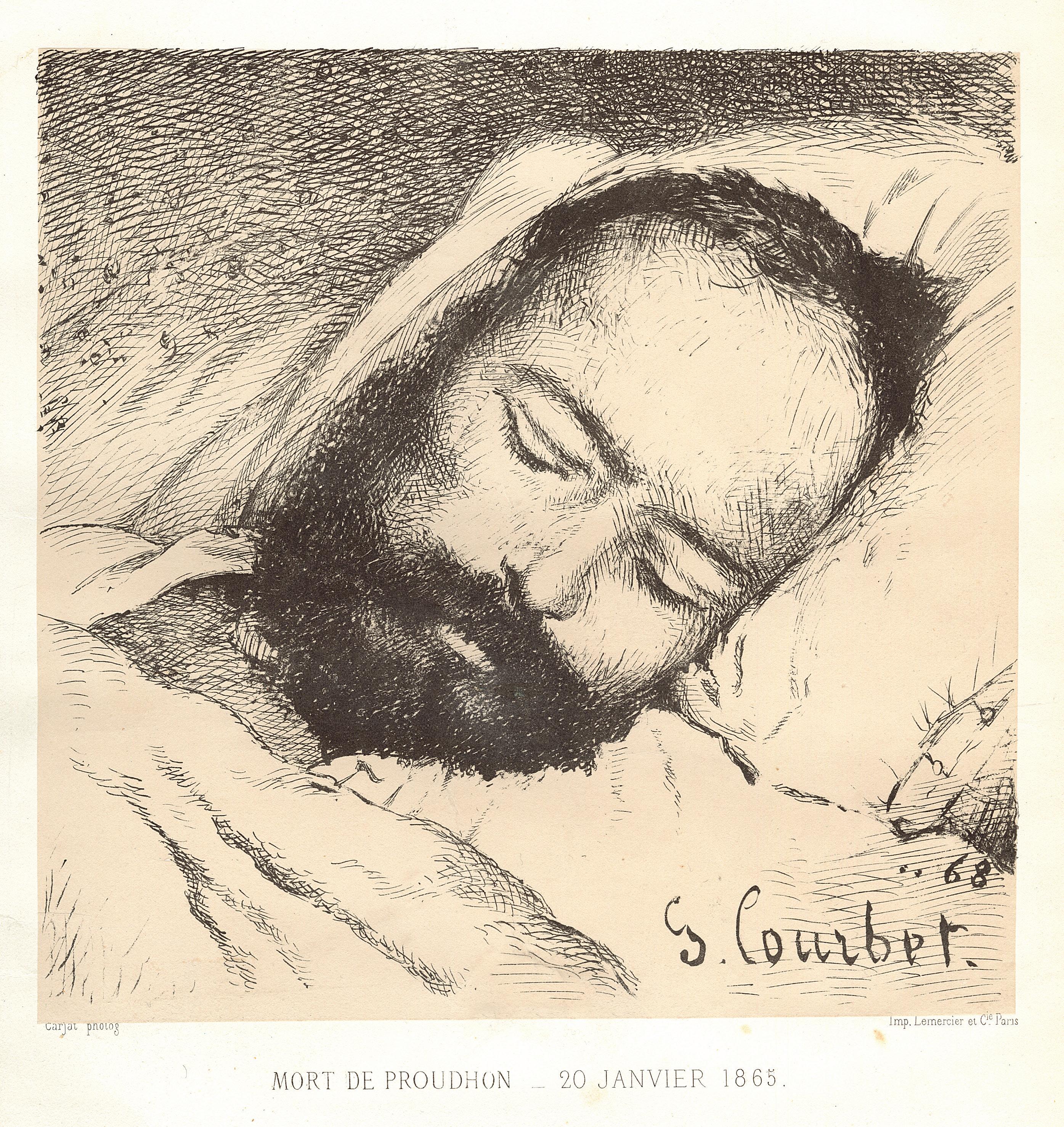
65
31 Henri Fantin-Latour 1836 Grenoble – Buré 1904
Portrait of Mr. Fantin, 17 Years Old
Lithograph on Chine volant, 1892
Signed lower left with pencil H. Fantin
Image 200 x 150 mm
Reference Hédiard-Mason 104, 1st state of four
Provenance Alfred Beurdeley (Lugt 421); Private collection, France
Condition In very good condition
This is an exceptional impression of the first state of four, with Fantin-Latour’s signature in pencil, before deletion of the inscription in the lower margin and before Lemercier‘s address. It is one of an edition of thirty-two proofs in this state.
The present lithograph is related to Fantin-Latour’s earliest self-portrait – an oil on canvas made in 1853, when the artist was 17 years old, and now kept at the Palais des Beaux-Arts in Lille. With the exception of a mid-career work painted in 1883, Fantin-Latour made most of his self-portraits during his schooling and early period. It is particularly interesting that in 1892, nearly
forty years after completing that original oil, during a time when Fantin-Latour rarely represented himself (except occasionally in larger groups and multi-figure compositions), he took the youthful portrait back and reproduced it as a lithograph. Fantin-Latour showed remarkable sensitivity in moving from one process to the other, from color to black and white. Pencil, scraper and stump were used to translate the flickering light found in the background of the painting, as well as the lights and shadows on the face, making it even more dramatic than the painting. It is Fantin-Latour’s only self-portrait in lithograph.
66
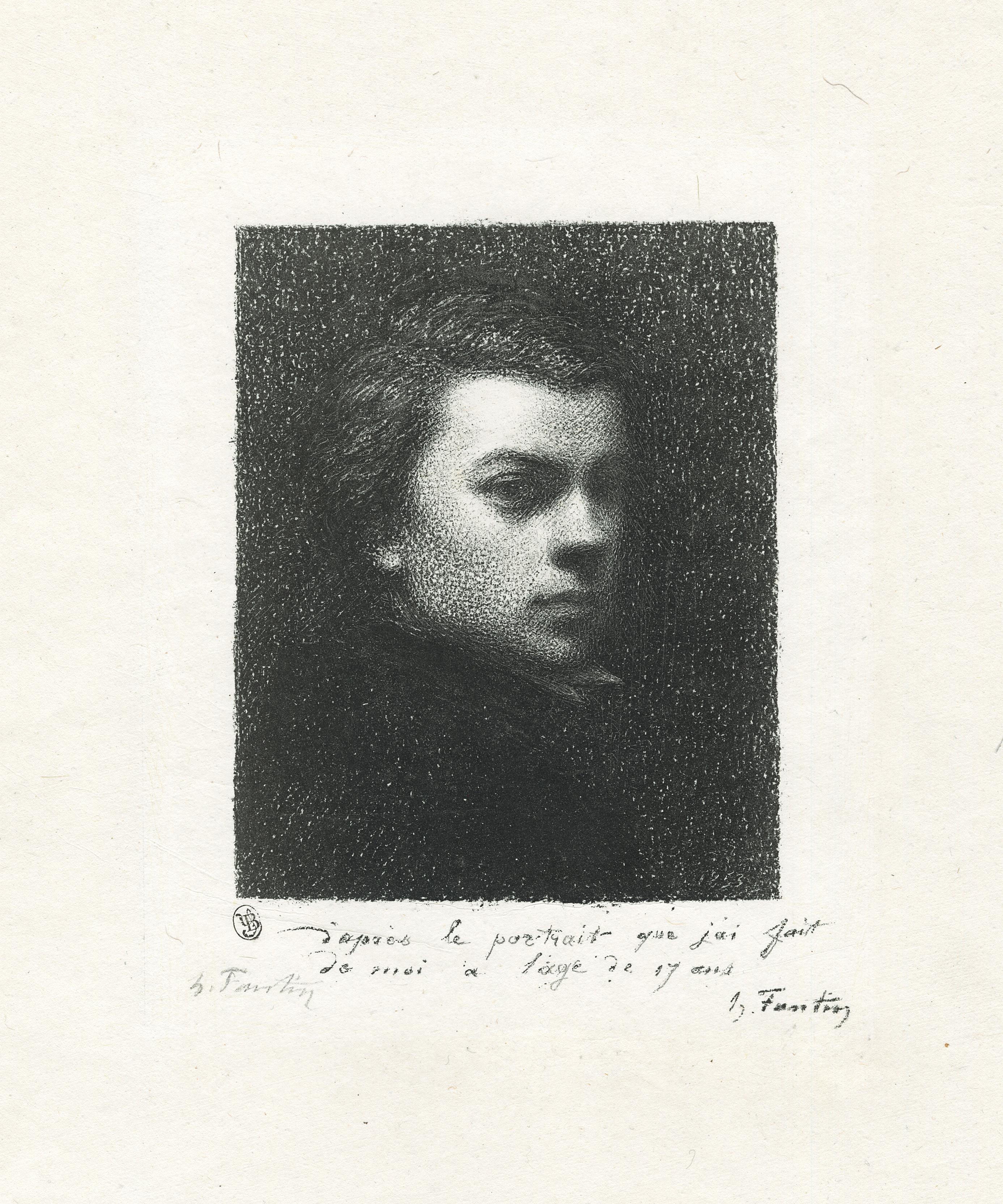
67
32 Camille Pissarro 1830 Charlotte-Amélie – Paris 1903
Rain Effect
Etching and aquatint on wove paper, 1879
Inscribed lower left Epreuve d’artiste, and signed lower right C. Pissarro
Plate 160 x 215 mm
Reference Delteil 24, 6th (final) state
Literature Barbara Shapiro, Camille Pissarro, The Impressionist Printmaker, Boston, Museum of Fine Art, 1973, nos. 15-17
Provenance Private collection, Germany
Condition In fine condition
This is a stunning impression of the Pissarro’s Rain Effect, of the sixth and final state, often referred to by specialists as the “rain state.” It is evident that Pissarro studied Japanese Ukiyo-e [“floating world”] woodcut prints and was especially aware how those works depicted rain, snow, and other kinds of weather. Inspired perhaps by Hiroshige, Pissarro embarked on Rain Effect, a remarkable adventure in the development of different printing states. The idea was not to capture landscapes in different light situations, but in different weather conditions.
In this work’s first state impression, only a few spots of aquatint emerge from an almost uniformly grey plate tone, as if from mist. In future states these spots coalesce into a row of trees on the horizon, a haystack in the middle ground, other earthen forms, and two human figures in the foreground to the left. All these details have now been rendered figuratively, with etched lines. The atmospheric mist has lifted, objects appear progressively clearer, and the composition has solidified – until the eponymous rain, previously only hinted at here and there, becomes dominant in the sixth and final state. With the addition of pronounced oblique strokes that simulate the effect of rain remarkably, Pissarro has
not only changed the scene’s weather but also altered its quality of light and intensified its expressive effect.
With great technical finesse Pissarro has implemented a special tool, one he probably adopted from Degas: the crayon electrique, or Voltaic pencil. This is a kind of metal brush used to achieve tonal effects in dense layers; Pissarro has used the tool to render the rain shower in broad parallel strokes that seem to almost tear at the paper itself. He then burnished or ‘erased’ subtle slashes into the darker areas of the figures and field, increasing the effect of driving rain. In doing so the artist disregarded the traditional canon of printmaking methods; calling upon his affection for Japanese prints and mindful of the technical innovations of Degas, Pissarro developed his own inventive manner.
This is an exceedingly rare print. The final state was printed in only about ten impressions during Pissarro’s lifetime. A posthumous edition of fourteen was printed in a brownish ink, which provides a softer effect than those printed in black ink during Pissarro’s life, such as the present object.
68
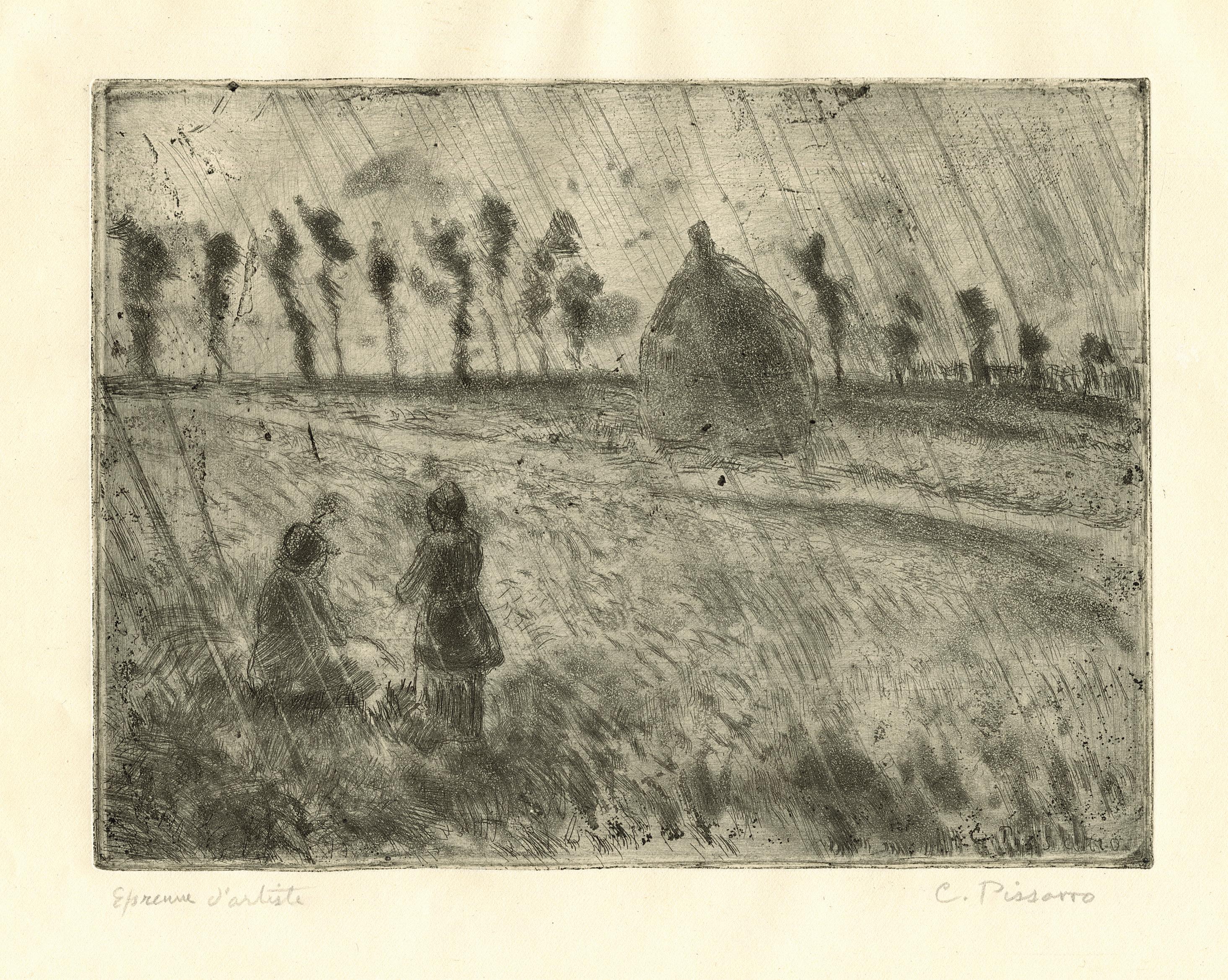
69
33 Mary Cassatt 1844 Pittsburgh
–
Mesnil-Théribus 1926
Lydia Reading, Turned Toward Right
Soft-ground etching, aquatint and drypoint on Japan paper, ca. 1880-81
Plate 179 x 112 mm
Reference Breeskin 63, first state of two
Provenance Alexis H. Rouart (Lugt 4898); Ambroise Vollard, Henri M.
Condition In very fine condition
A very fine impression of the second, final state, with highlights on the drapery. After the first state, Cassatt clearly looked to improve her picture’s sense of light. Cassatt began printmaking in 1879, and her use of aquatint was undoubtedly inspired by Degas’ and Pissarro’s own aquatints of the same period. All three artists had been making works for Le Jour et la Nuit, a proposed journal of original prints by several artists. There is a clear parallel between Cassatt’s work and Degas’ Head of a woman in profile (Reed and Shapiro 43) whose only impression Cassatt herself owned, and about which she wrote late in life: “unique impression [of an] experiment with liquid aquatint.” She also mentioned that print in a letter to Louisine Havemeyer, in March 1922: “… and among them one unique etching of Degas, un essai wet grain which Braque [Bracquemond] had got him to try.” Degas even wrote to Pissarro about the use of liquid aquatint in combination with soft-ground etching1. Cassatt evidently received the same learning and also tried to make artworks through these methods. Indeed, the present print, in which most of the forms are shaded
(Lugt
with aquatint, serves as an excellent illustration of the printmaking techniques described in Degas’ letter. The work is accented by select touches of drypoint, which mark the eyes and the eyelids, the left hand, the edges of the book and of the chair.
Henri Rouart and his son Alexis were close to Cassatt, and they collected significant holdings of her artworks. A part of their collection of prints went up to Ambroise Vollard and then to Henri Petiet, in Paris. With his voracious appetite for graphic art, and a great fan of Cassatt prints, Vollard bought a large body of work directly from the artist, and he supplemented this collection with purchases from other key contemporary collectors, including the Rouarts. Following Vollard’s untimely death in a car accident in 1939, the collection was sold by his heirs to Henri Petiet for his collection, which was subsequently kept in portfolios and rarely handled.
70
1. Lettres de Degas, Edited by Marcel Guérin, Paris, 1945, no. 25.
Petiet
5031)

71
34 Henri Guérard 1846 – Paris – 1897
Portrait of Philippe Burty
Drypoint printed with tone on wove paper, ca. 1888
Stamped with the artist’s red monogram (L. 3481)
Plate 161 x 115 mm
Reference Bertin 13 (undetermined state)
Provenance Eric Carlson, New York; Private collection, France
Condition In very good condition
A very fine trial proof, unbeveled, before any letter and before the later edition in the Gazette des Beaux-Arts in 1907.
72
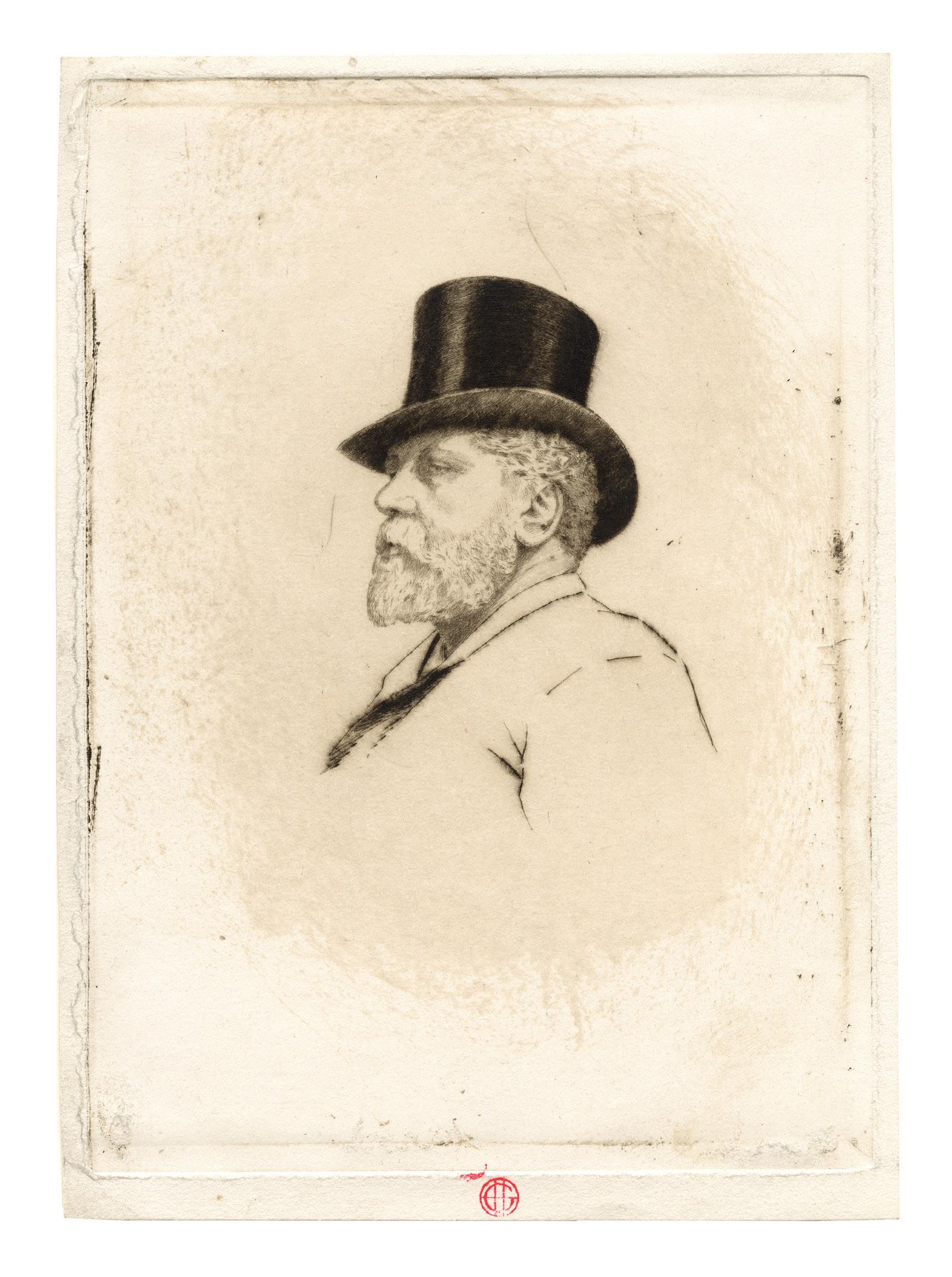
73
35 Felix Vallotton 1865 Lausanne – Paris 1925 Young Girl in Bust
Drypoint on simili-Japan paper, 1891
With the artist monogram, numbered 5/5, and with the atelier stamp, lower right Plate 216 x 135 mm
Reference Vallotton & Goerg 8d
Literature Louis Godefroy, L’œuvre gravé de Félix Vallotton, Paris-Lausanne, 1932, no. 10
Provenance Private collection, Switzerland
Condition In fine condition
The present work is a very fine impression with burrs, numbered 5/5, and with artist and atelier stamps.
Lifetime impressions by Vallotton are extremely rare;
Maxime Vallotton and Charles Goerg only knew a few. The present one was printed in Paris, in 1931, by Paul Vallotton, the artist’s brother, when he got the intaglio plates by inheritance, in an edition of around 35 copies printed on wove and simili-Japan papers. The impression held by the Bibliothèque National de France is from this edition.
There are only seven drypoints in the thirty-seven intaglio prints of Vallotton’s whole œuvre. He actually first learned and used this technique in 1887, before turning to the woodcut process in 1891. Vallotton’s first drypoints are prints after old masters such as Rembrandt, as well as more recent masters and contemporary artists like Jean-François Millet, Pascal Dagnan-Bouveret, and Jules Breton. Then came five drypoints and three etchings of his own invention. All except one are portraits.
74
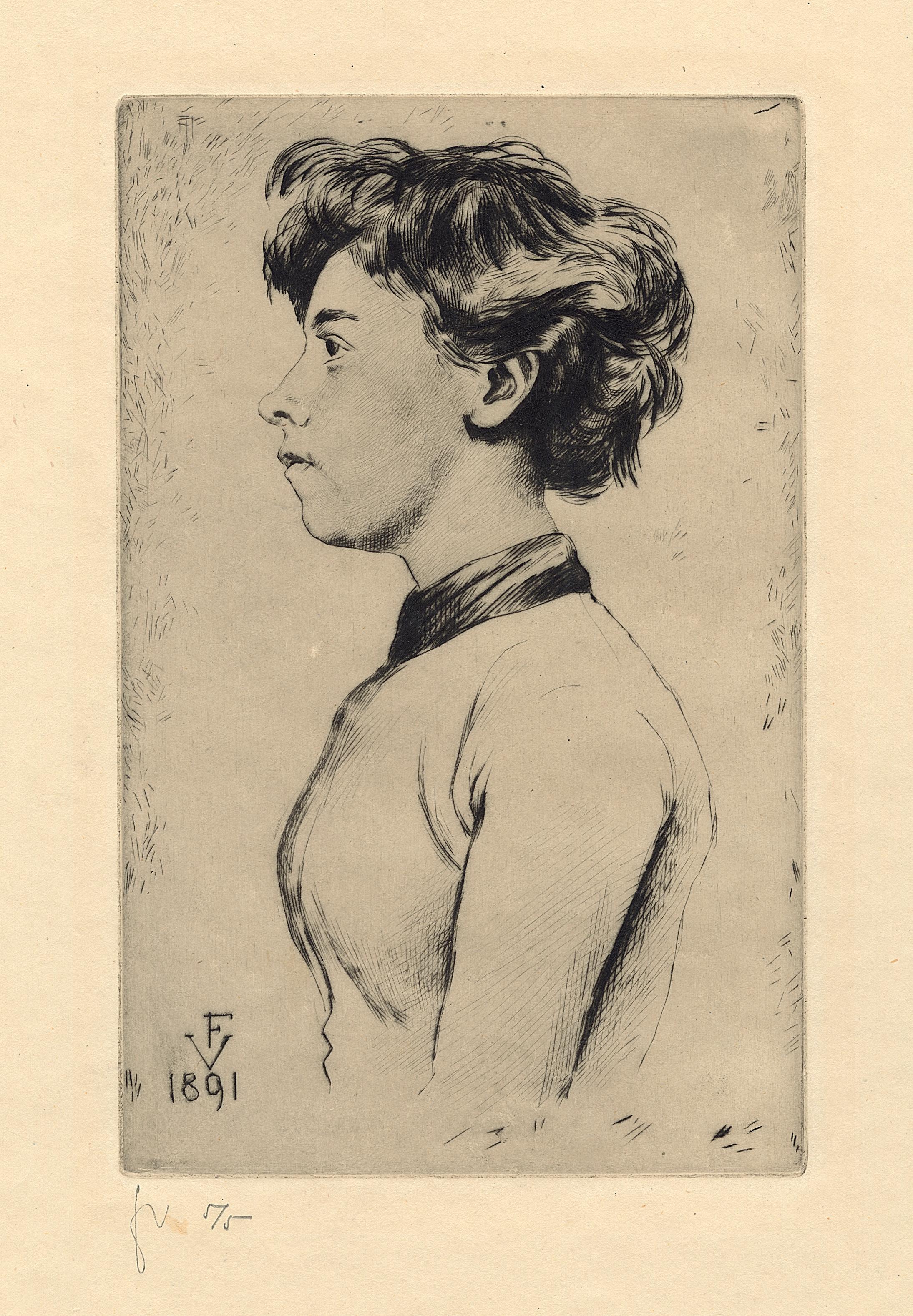
75
Gudmann Rohde
Portrait of Jan Verkade
Lithograph on Chine appliqué on wove paper, 1894
Image 237 x 176 mm
Exhibition Ostend, Kursaal and Musée des Beaux-Arts, Europe 1900, 1967 (label on the back)
Provenance Hermann Peter Rohde (the artist’s son), Copenhagen; Private collection, Denmark Condition In fine condition
Johan Gudmann Rohde was an accomplished Danish painter, lithographer, and designer who did notable work with the silversmith Georg Jensen. He is known to historians for having been the visionary behind Den Frie Udstilling, (The Free Exhibition), founded in 1891. Drawing inspiration from Paris’ Salon des refuses, this association of avant-gardists aimed to provide a platform to exhibit works that diverged from the Royal Danish Academy of Art’s established selection criteria. The collective included some of the country’s most pioneering creatives, including J.F Willumsen, Vilhelm Hammershøi, Harald and Agnes Slott-Møller, Anne Marie Carl-Nielsen, Christian Mourier-Petersen, and Malthe Engelsted, among others. Den Frie stands as arguably the world’s longest-running artists’ association, and it remains a vibrant resource for artists today.
Rohde travelled extensively across Europe, which introduced him to new ideas about artmaking that he then introduced to his native country. His role in introducing and disseminating new currents such as Symbolism and Neo-romanticism in Denmark was crucial to the development of that nation’s avantgarde. Rohde did so not only through interpersonal connections but also by penning meticulously composed articles on the latest ideas in Danish newspapers. Notably, he championed the cause of Vincent van Gogh within Denmark’s borders, buying a work from the artist in Paris in 1892 (now at the Ny Carlsberg Glyptotek). The following year, in 1893, he organized an exhibition showcasing Van Gogh’s œuvre at Den Frie. During his travels, he met Maurice Denis, Félix Vallotton and Jan Verkade, the subject of the present portrait. His travel reports were rife with artists involved in and important to the avant-garde: Fernand Khnopff, Jan Toorop, Pierre Puvis de Chavannes, Paul
Cézanne, Gustave Moreau, Auguste Rodin, Henri de Toulouse-Lautrec, and the Nabis painters. In some ways, Rohde set the stage for a whole generation of Danish artistic life. In his book Danmarks Malerkunst (1906), the art critic Emil Hannover described Rohde’s importance1: “His place in Nyhavn will go down in history, it was for a number of years the central place for the study and discussion of the most modern art [in Denmark]. Well, it was not that much that Rohde had been able to collect with his modest means: a picture of Gauguin or Denis, some etchings by Rops, a drawing of van Gogh, a suite of lithographs by Redon, a study of Verkade, a book by Rysselberghe, etc., but it was enough to form subjects for conversations with this wise and open-minded man.”
Having completed his grammar school education in 1875, Rohde initially studied medicine before embarking upon the path of art and painting. After studying under Wenzel Tornoe, he enrolled at the Academy in 1882. His dissatisfaction with the institution’s resistance to contemporary trends, however, led him to leave the school in less than a year, along with a group of fellow students. Subsequently he pursued studies from 1883 to 1886 at the new Kunstnernes Studieskole, under the guidance of Laurits Tuxen and P.S. Krøyer. His own paintings from the 1890s, especially his portraits, are influenced by Symbolism, and are in most of the Danish museums. As a printmaker, he made fortyfive lithographs, including the present print in 1894. His etched work was produced mainly late in life. Indeed, eighty-seven of his ninety-seven etchings were created from 1932-34, shortly before his death in 1935.
76
1. Quoted in Henrik Wivel, Ny dansk kunsthistorie, vol. 5 (Symbolisme og impressionisme), Kunstbogklubben, 1994, p. 211.
36 Johan
1856 Randers – Hellerup 1935
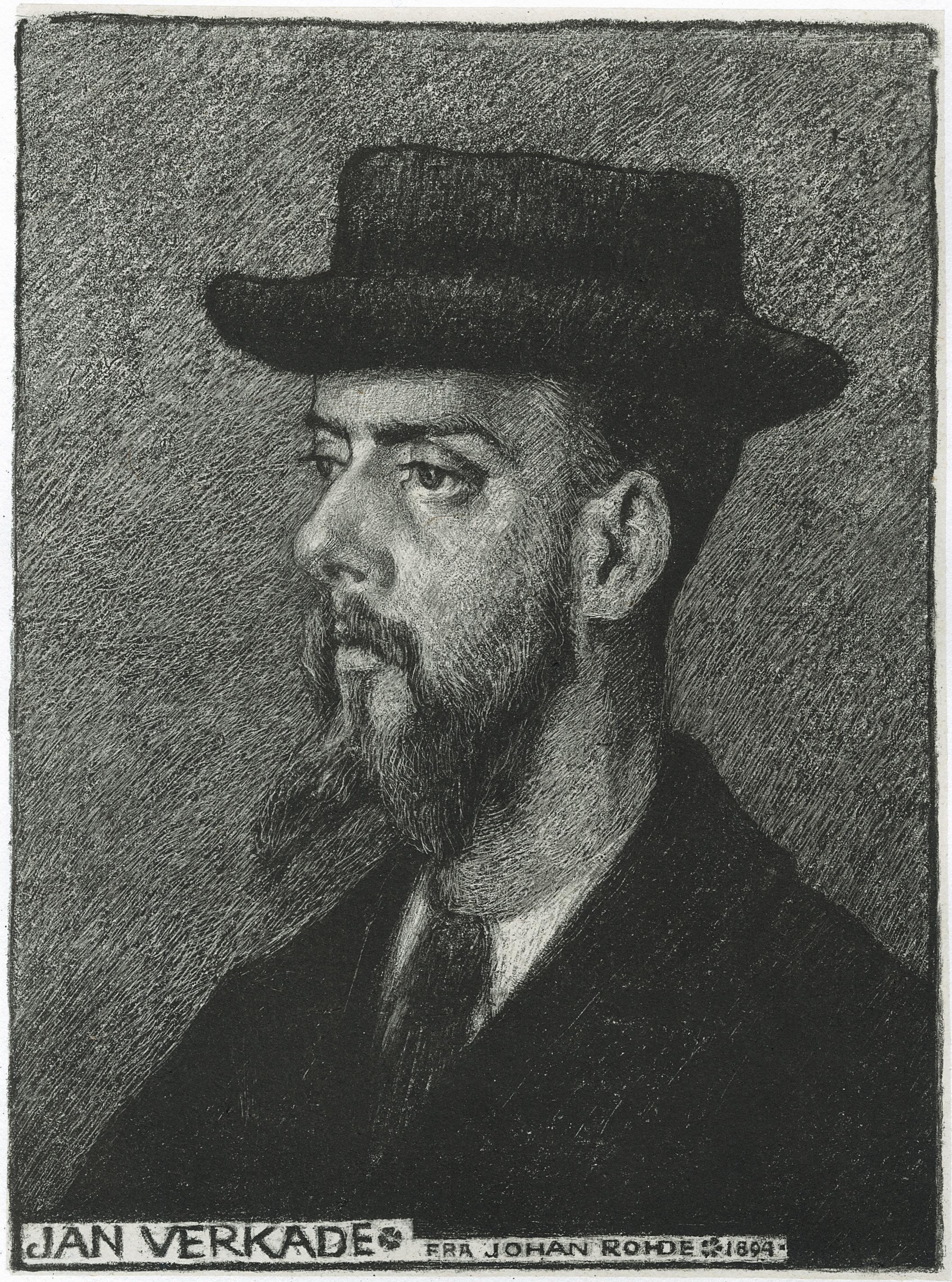
77
37 Henri Evenepoel 1872 Nice – Paris 1899 Paris The Old Madam
Lithograph on laid paper, ca. 1895
Image 475 x 327 mmm
Watermark MBM
Reference Derey-Capon 30, 2nd (final) state
Provenance Private collection, Belgium
Condition In very good condition
A very fine impression of one of Henri Evenepoel’s most striking lithographs. There are only two impressions recorded of the first state, without the bottle at left. Of the second state there were fifty impressions printed on wove paper at Lemercier, Paris, and fifteen “de luxe” impressions on laid paper, of which the present work is an example.
It seems that the success of this plate did even pay for the family tranquility for a few months (see Derey-
Capon, p. 38). And yet, the subject is more a caricature of a typical Parisian madam, evoking the brothels of the 9th arrondissement which called out to passersby willing or lost. In any event, Henri Evenepoel excels as a draftsman here, his figurative style a combination of Félicien Rops and Gustave Doré.
78
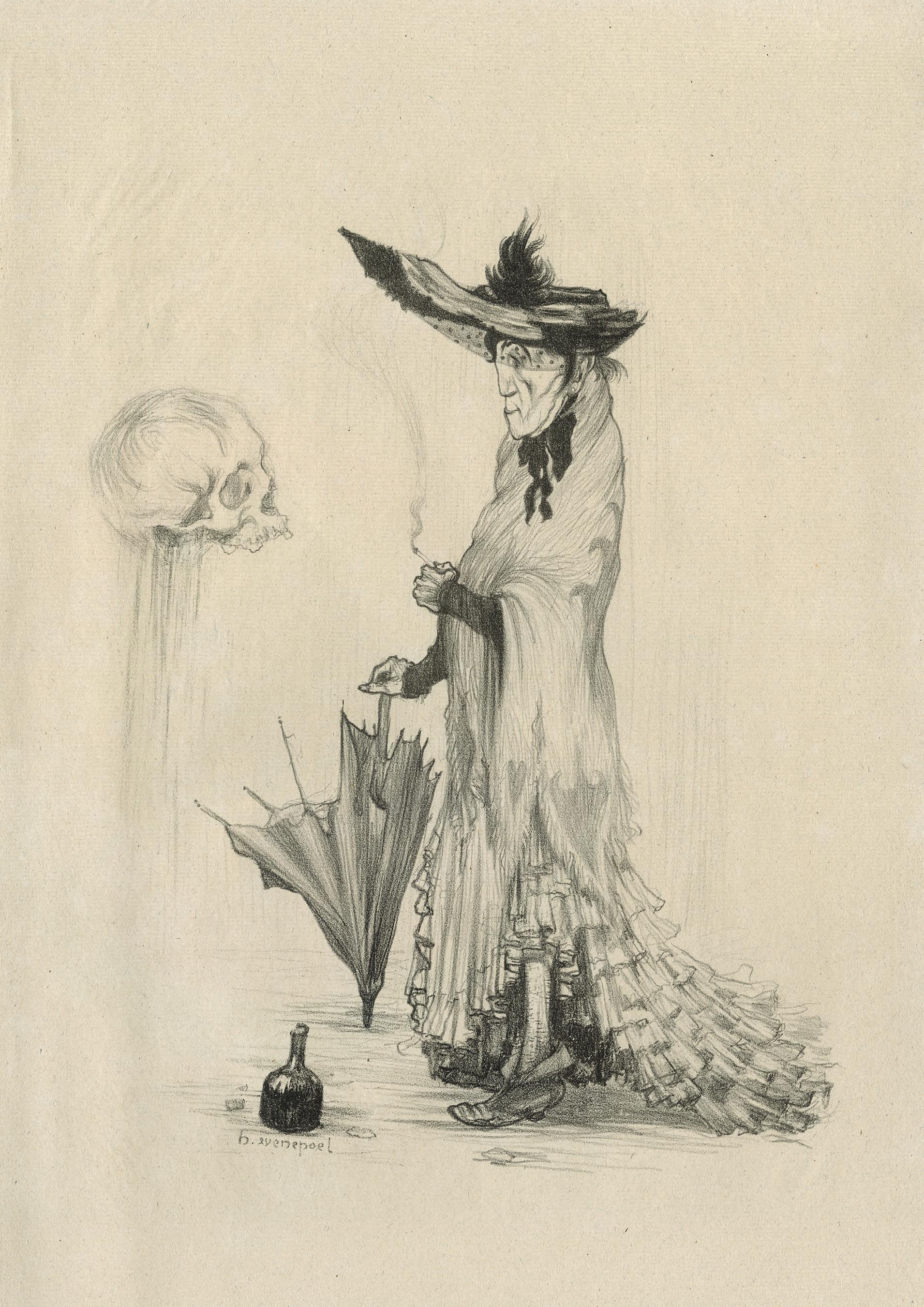
79
38 Théo van Hoytema 1863 – The Hague – 1917
Five Angora Rabbits
Lithograph with embossing printed on Chine appliqué on wove paper, 1898
Signed lower right in pencil Rn. Roland Holst, by the artist’s friend Richard Roland Holst
Plate 417 x 325 mm
Reference Rijksmuseum/de Groot 86, 2nd (final) state
Literature Marjan Boot, Theo van Hoytema 1863-1917, Waanders, The Hague, 1999, no. 37, pp. 39-40 (cover and ill.)
Provenance Private collection, The Netherlands
Condition In very good condition
This remarkable impression, with wide margins, is perhaps the most famous lithograph by the Dutch master of technique, and it is still an iconic image of nineteenth-century Dutch printmaking. The embossed surface is excellently preserved. This impression, like others, was unsigned at the death of the artist, in his studio. His friend Richard Roland Holst stamped the remaining impressions to acknowledge their authenticity and signed them in pencil. Although the edition is totally unknown, it seems that this print was part of an extremely scarce portfolio titled Dierenstudies [Animal Studies].
Fascinated by wildlife, Théo van Hoytema spent time at the Rijksmuseum van Natuurlijke Historie
in Leiden to paint taxidermized animals. In 1898, he worked on large compositions and experimented with new lithographic techniques such as Japanese blind printing. Five angora Rabbits demonstrates a beautiful, embossed surface, creating a stunning realization of the rabbits’ fur texture. The influence of Japanese wood prints on van Hoytema’s art is clear in this depiction of animals: first there is the incorporation of both closely observed naturalism and formal stylization; secondly, the intense contrast between the black of the background and the white of the compact group of rabbits.
80
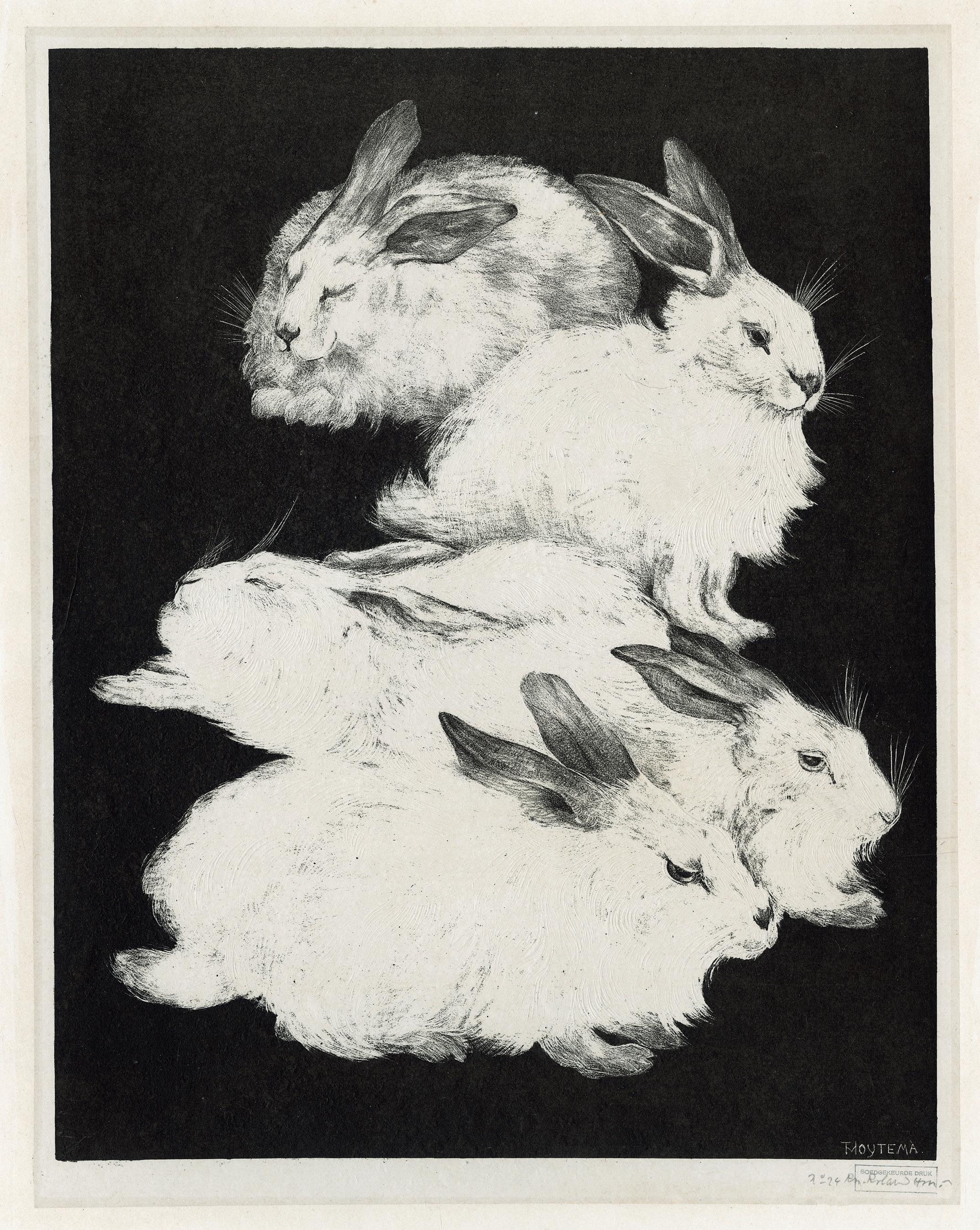
81
39 Peter Ilsted 1861 Sakskøbing – Copenhagen 1933
Portrait of Vilhelm Hammershøi
Etching on laid paper, ca. 1899-1900
Signed lower right Peter Ilsted
Plate 128 x 103 mm
Reference Fortegnelse over Peter Ilsteds grafiske Arbejder, Copenhagen, 1924, Opus 44 Provenance Private collection, Germany
Condition
In very fine condition
This is a superb, sharp impression, with plate tone, and signed, which is unusual.
This portrait follows the common Danish practice of depicting artists from the chest up against an almost blank ground. Expertly wielding the etching needle, Ilsted created a convincing portrayal of the unruly long hair, goatee, and beard that Hammershøi favored later in life. This image echoes the stiff, formal profile pose the artist assumed in a photograph from about the same time. The print, rich in chiaroscuro, shows Hammershøi looking off evasively into the distance with his eyes half-open, suggesting someone lost in his own elusive thoughts.
There is so much to say about the psychologically charged relationship between Hammershøi and Ilsted. They were alternately students in the same class, friends, competitors, and brothers-in-law (Vilhelm married Peter‘s sister in 1891); they were also destined to different fortunes. Unlike Hammershøi, Ilsted was a highly gifted engraver. More conventional in his paintings than Hammershøi, it is above all in his graphic works that Ilsted proved himself an innovator, in etching and mezzotint.
82
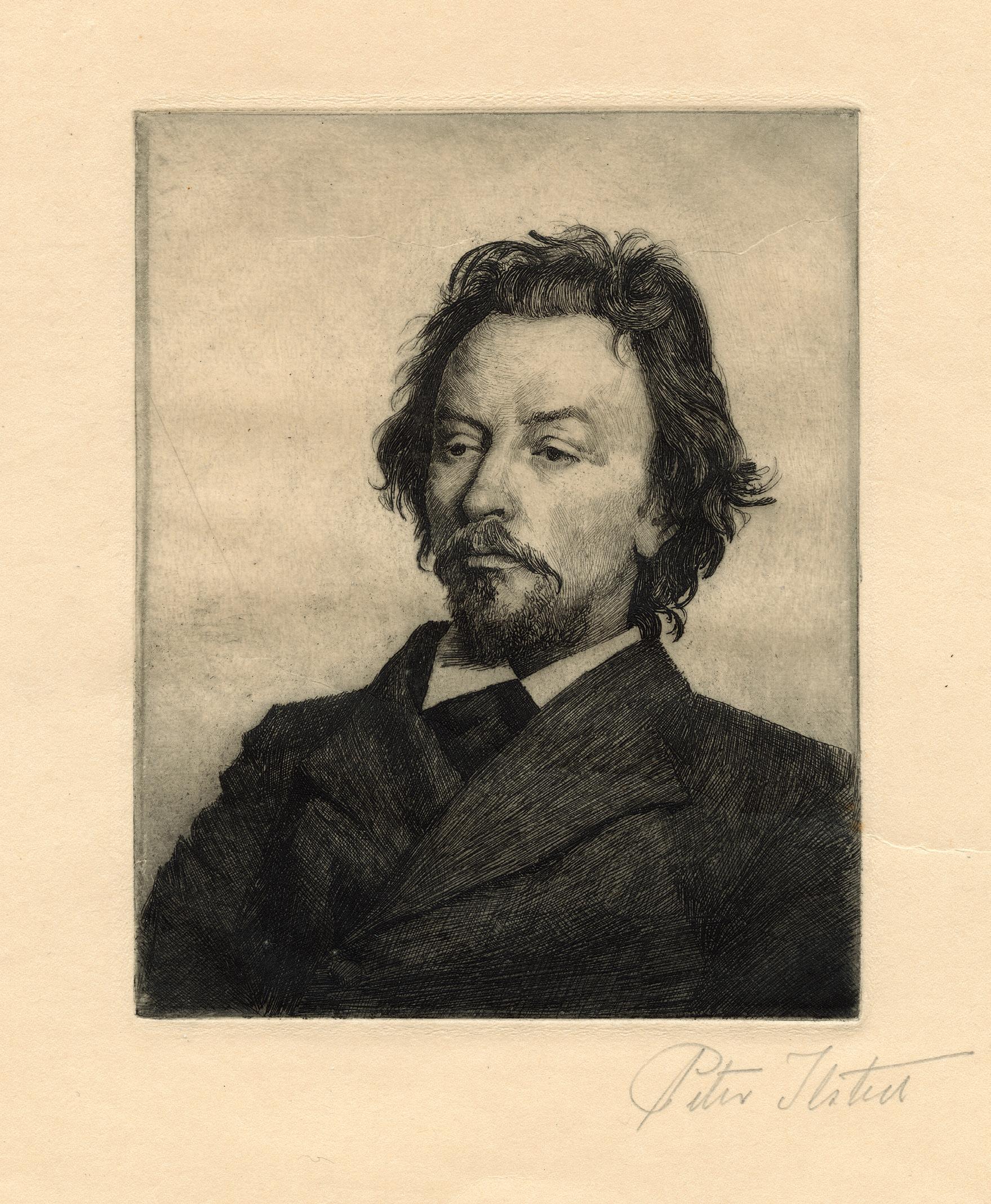
83
40 Jacques Villon 1875 Damville – Puteaux 1963 The Sulker Woman
Etching and aquatint printed in color on wove paper, 1900
Plate 175 x 282 mm
Reference Ginestet & Pouillon E37
Provenance Private collection, France
Condition
In very fine condition
The present work is a sublime impression of a famous yet exceedingly rare plate. It has been printed à la poupée with only one stay on the press, which was unusual for Jacques Villon. It is said to have been printed at thirty copies, but as far as we can ascertain there are only eleven recorded impressions in public and private collections. It was exhibited at the Salon de la Société Nationale des beaux-arts in 1901, in Paris. The model
is Bernadette, who was a favourite of Villon early in his career. The aesthetic is clearly influenced by the Nabis painters, although Villon later claimed he didn’t know that much about the Nabis at the time, and that he realized his affinity to their work only later in life. Certainly, this is one of the most beautiful plates of Villon’s early period.
84
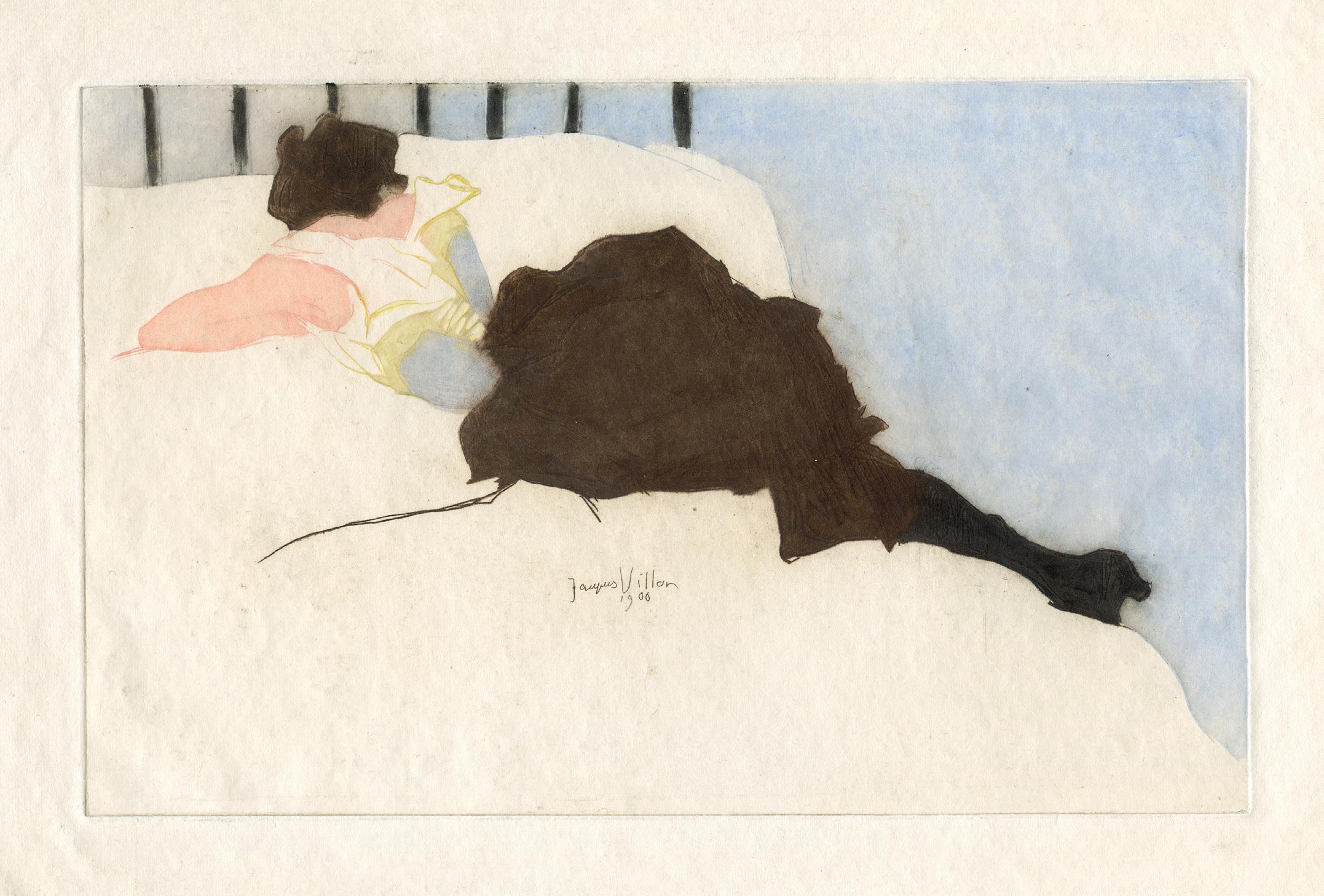
85
41 Paul Gauguin 1848 Paris – Tahiti 1903 Misères humaines
Woodcut on Japan paper, ca. 1898-99
Numbered “no. 26” in pen and ink lower left
Image 193 x 293 mm
Reference Guérin 69; Mongan & Kornfeld 49
Literature Richard Bretell, The Art of Paul Gauguin, National Gallery of Art, Washington, 1988, p. 428-436, no. 244
Provenance Stuck-Jugendstil-Verein Fondation, Munich; Private collection, France
Condition In fine condition, minor scuffing on paper edges, but due to its thinness
A stunning impression of a remarkably moving composition, this woodcut was printed by Gauguin himself in Tahiti in 1898-99. Based on the evidence of the impressions’ numbering as well as a letter to Gauguin’s friend Daniel de Monfried, the edition would have encompassed 27-30 pulls. Only 14 impressions, however, are recorded in public collections, and a further group of eight (including the present print) are in private hands.
Misères humaines is one of fourteen woodcuts made by Gauguin during his second (and last) trip to the South Seas. Representing a Polynesian woman and two Breton peasants, the subject epitomises the uneasy tension between Gauguin‘s erstwhile passions and his present reality. These impressions, hand-printed from uneven woodblocks, vary greatly in their inking and printing quality. The present print shows warm and dense blacks, which richly contrast the shimmering white of the thin oriental paper.
86
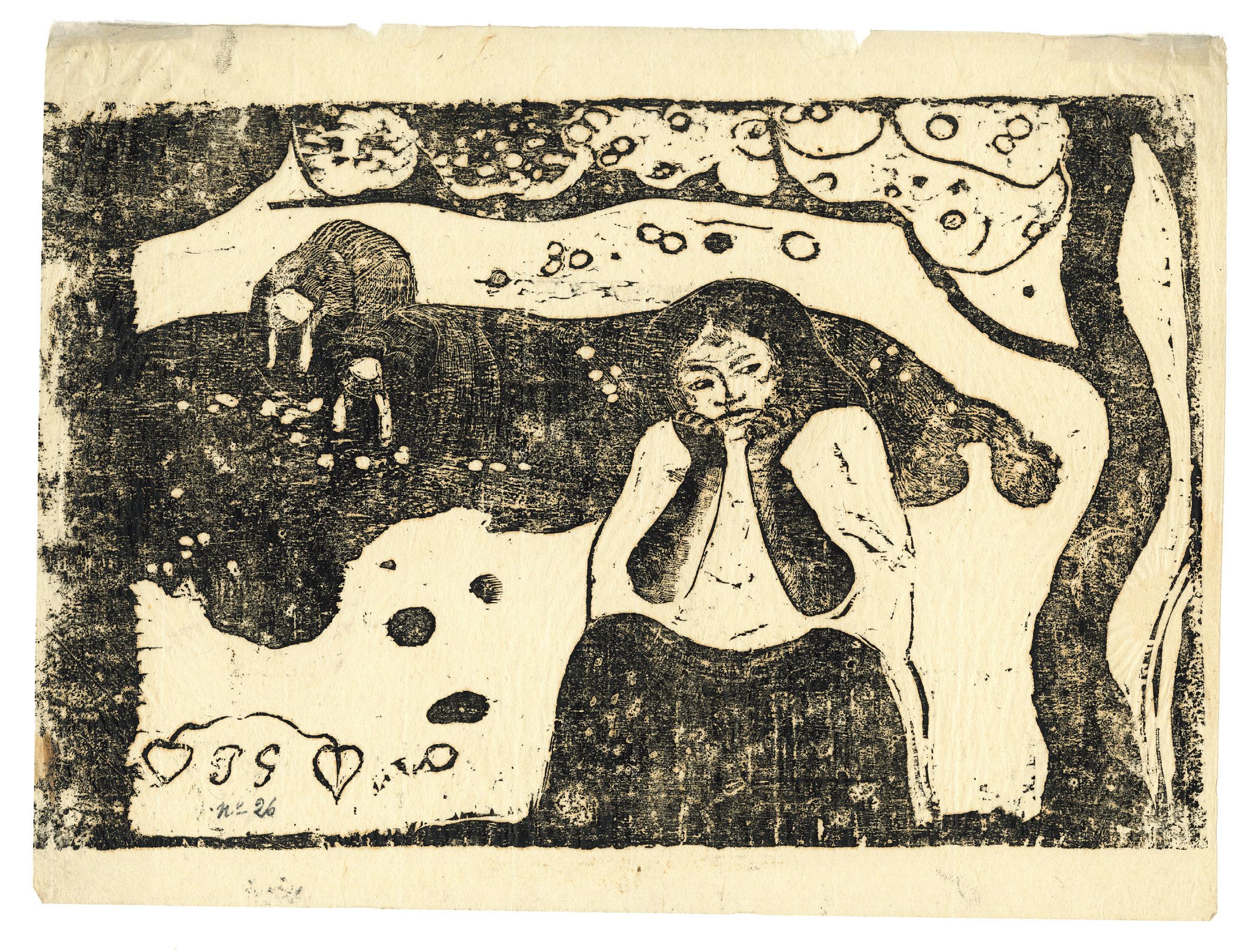
87
42 Marcel Roux 1878 – Lyon – 1922
Dance of Death (suite II)
A set of fifteen etchings on laid paper, in its cover, printed 1905
Table of plates with the handwritten printing numbering No. 1
Sheets each ca. 585 x 445 mm
Reference Marcel Roux (1878-1922) Visions Fantastiques, Lyon, Musée de l’Imprimerie et de la Banque, 1991, suite II, 11-25
Literature Colette E. Bidon, “L’œuvre diabolique et apocalyptique de Marcel Roux, graveur lyonnais”, in Nouvelles de l’Estampe, May-June 1989, no. 105, pp. 17-27.
Provenance Private collection, France
Condition
The sheets and the cover are in very good condition.
This is an extremely fine, rare set of the Marcel Roux’s most famous series. This Dance of Death personifies mortality as it appears to various people in various settings, castigating social inequalities in the process. Though somewhat forgotten today, Roux was renowned in his own time in France and across Europe, a reputation he cultivated by producing around four hundred prints. The Neue Zurcher Zeitung and the New York Herald devoted papers to him in 1911. The fashion designer Jacques Doucet bought his complete œuvre in 1912, and prominent critic Arsène Alexandre called Roux one of the greatest printmakers of his time.
Born and dead in Lyon, Roux was steeped in both Catholicism and mysticism. Following Lyonnais religious artists such as Louis Janmot and Paul Borel, Roux proselytized through his work by arguing for the existence of God through the reality of the Devil. As Borel wrote, “There are lots of peoples who, to understand God, would not come to it without scaring of the Devil.” In the main body of his graphic œuvre, an ensemble of eight thematic series, Roux translated this adage visually, fantastical imagination having been sparked by the literary inspirations of Hugo, Baudelaire, Poe (he illustrated Baudelaire’s
Fleurs du Mal and Poe’s Chute de la maison Usher), and Flaubert. But Roux’s uniquely dramatic sense of exaltation, and his flirtation with a certain strain of Nihilism, put him close, as well, to contemporary expressionists such as Kubin and Munch.
Recalling the print by Buhot on the same topic, the magnificent frontispiece shows Death manipulating the press. The portfolio’s cover is illustrated with the same image, hand-colored in red and numbered “1” by hand. Besides the present collection, so far only three complete sets with a hand-colored portfolio number are known.
The plates are:
Frontispice
Adam & Eve
Morceau à quatre mains
La Fête
Le Cabaret
Métamorphose
L’Avare
Le Festin
Le Démon du suicide
L’Ouvrier Malheureux
L’Enfant
Le Génie
Le Religieux
Le Christ
Table des planches
88
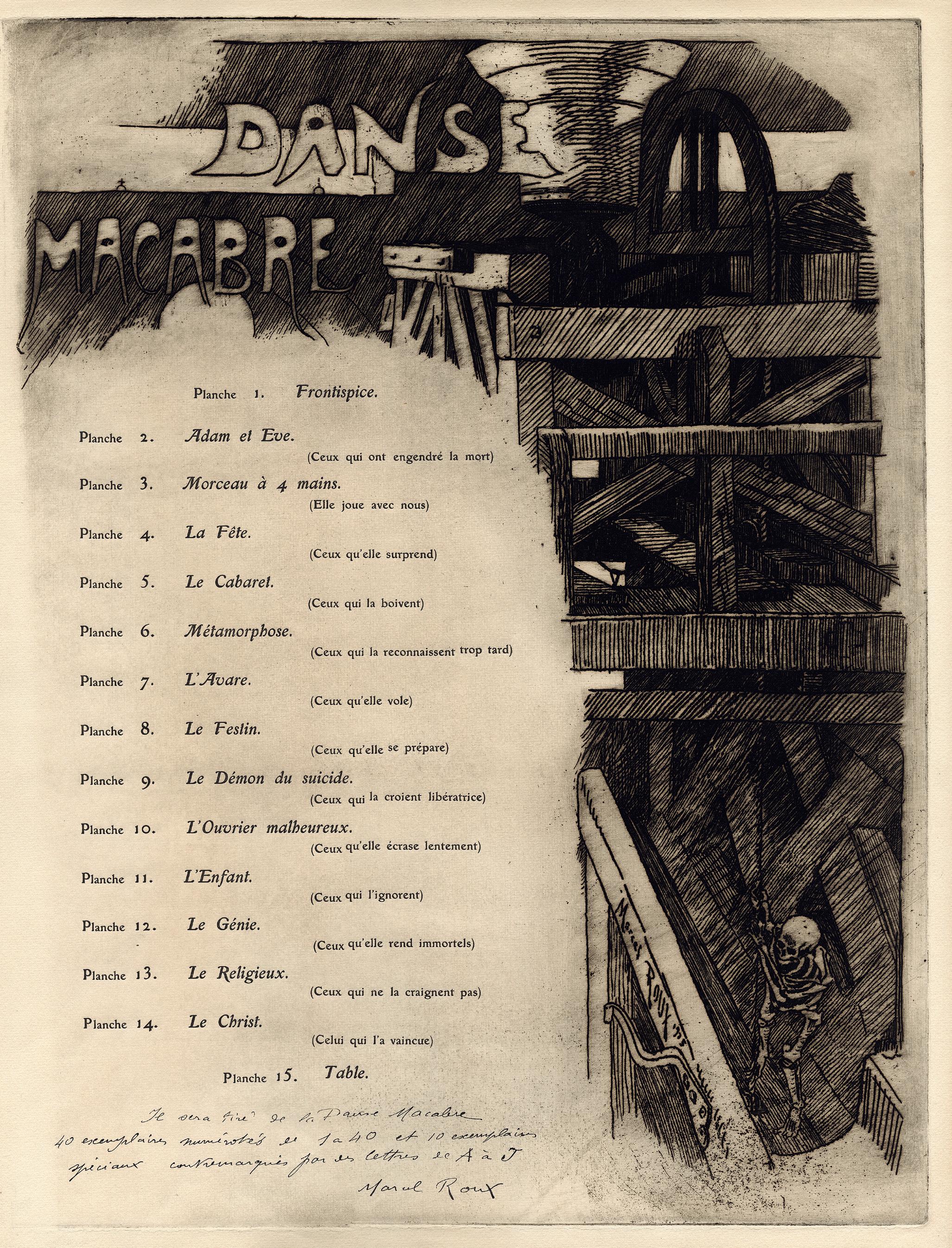
89
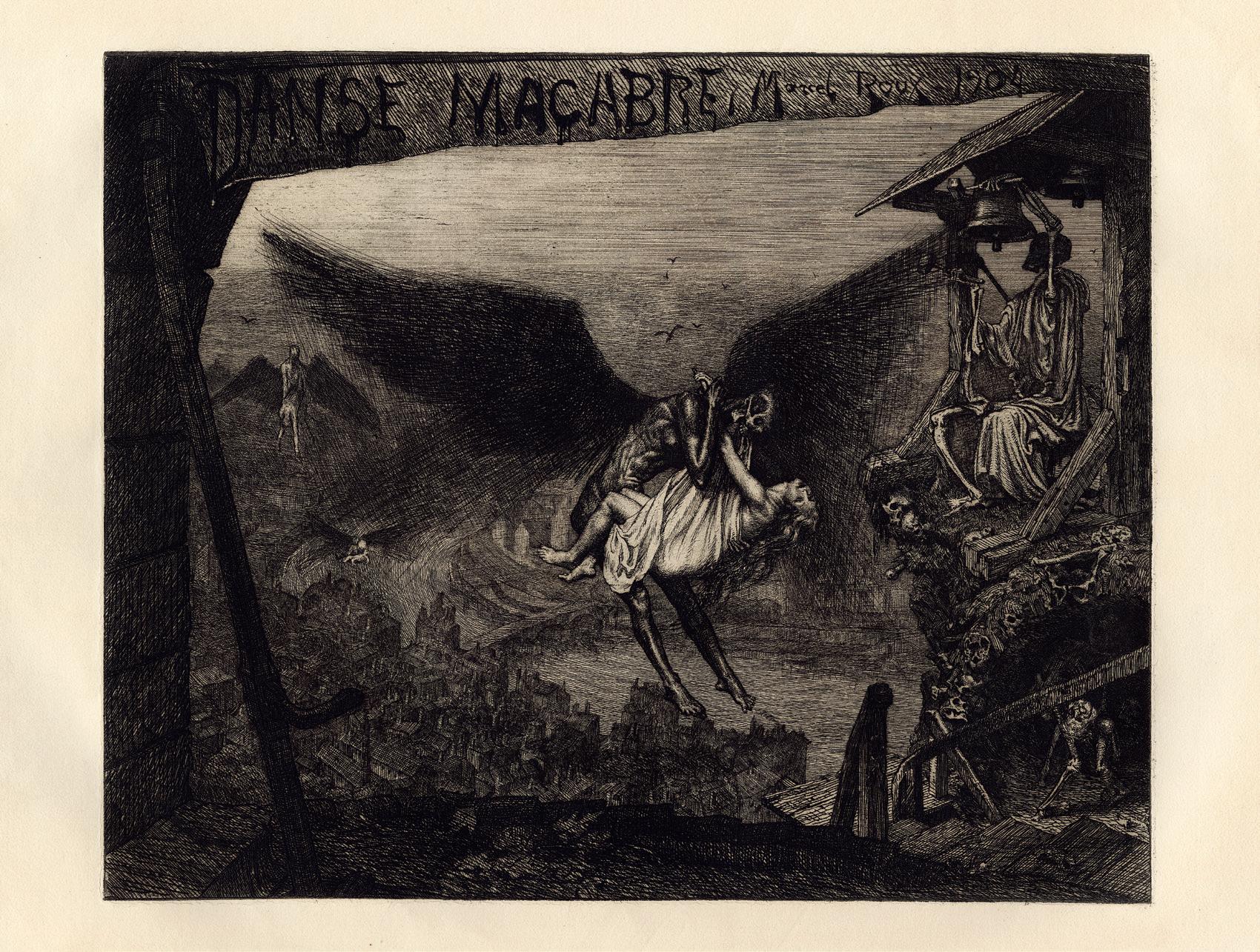
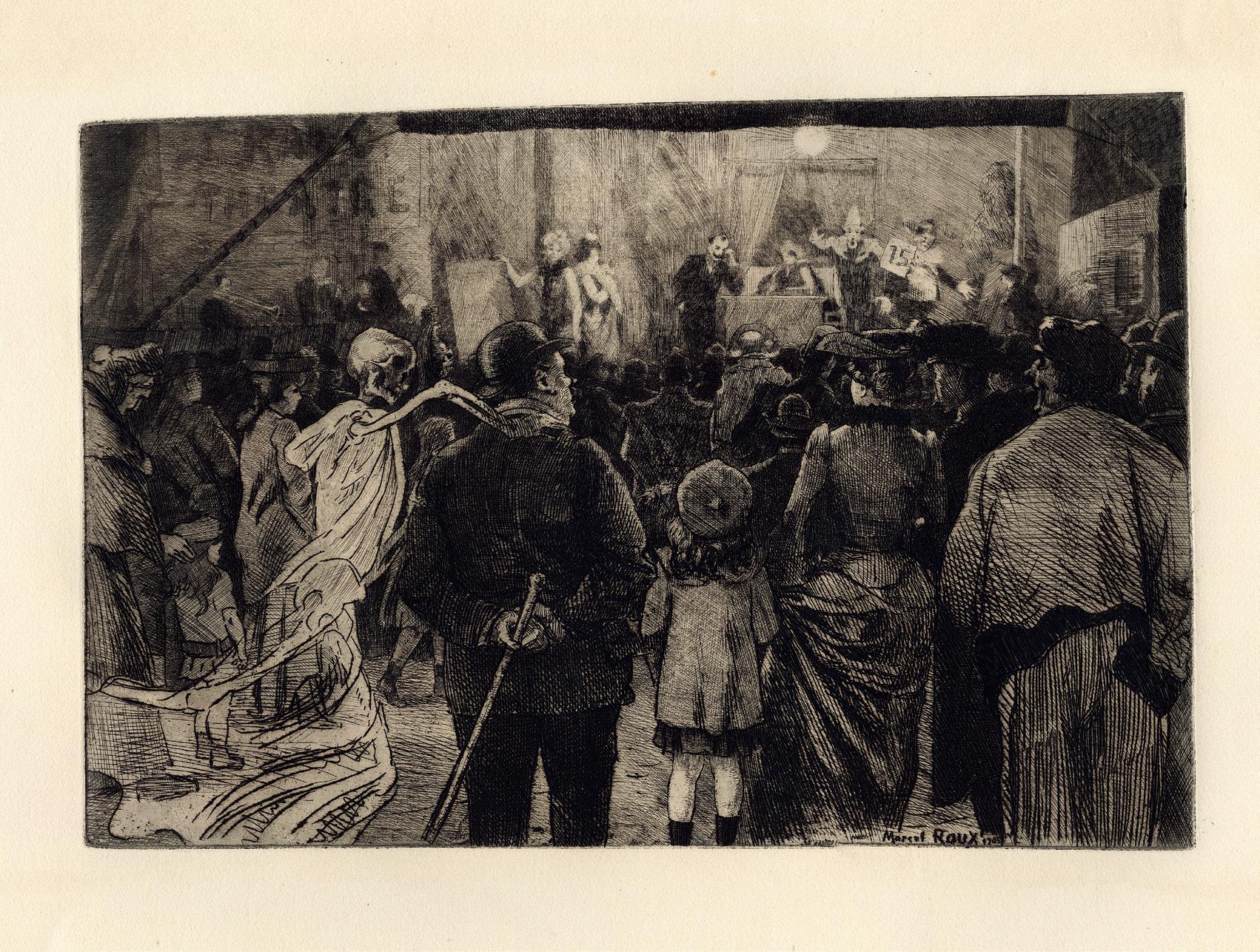
90
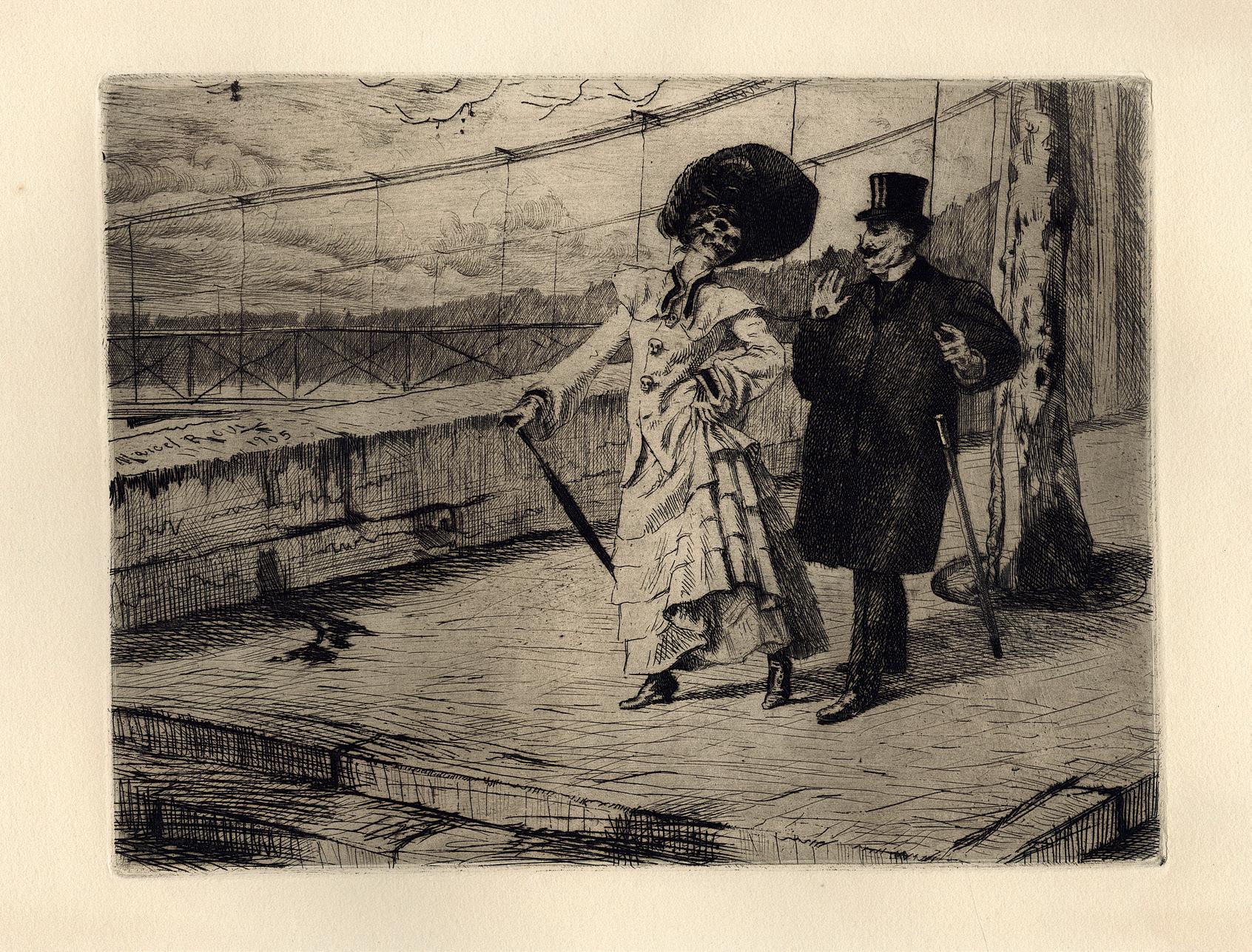
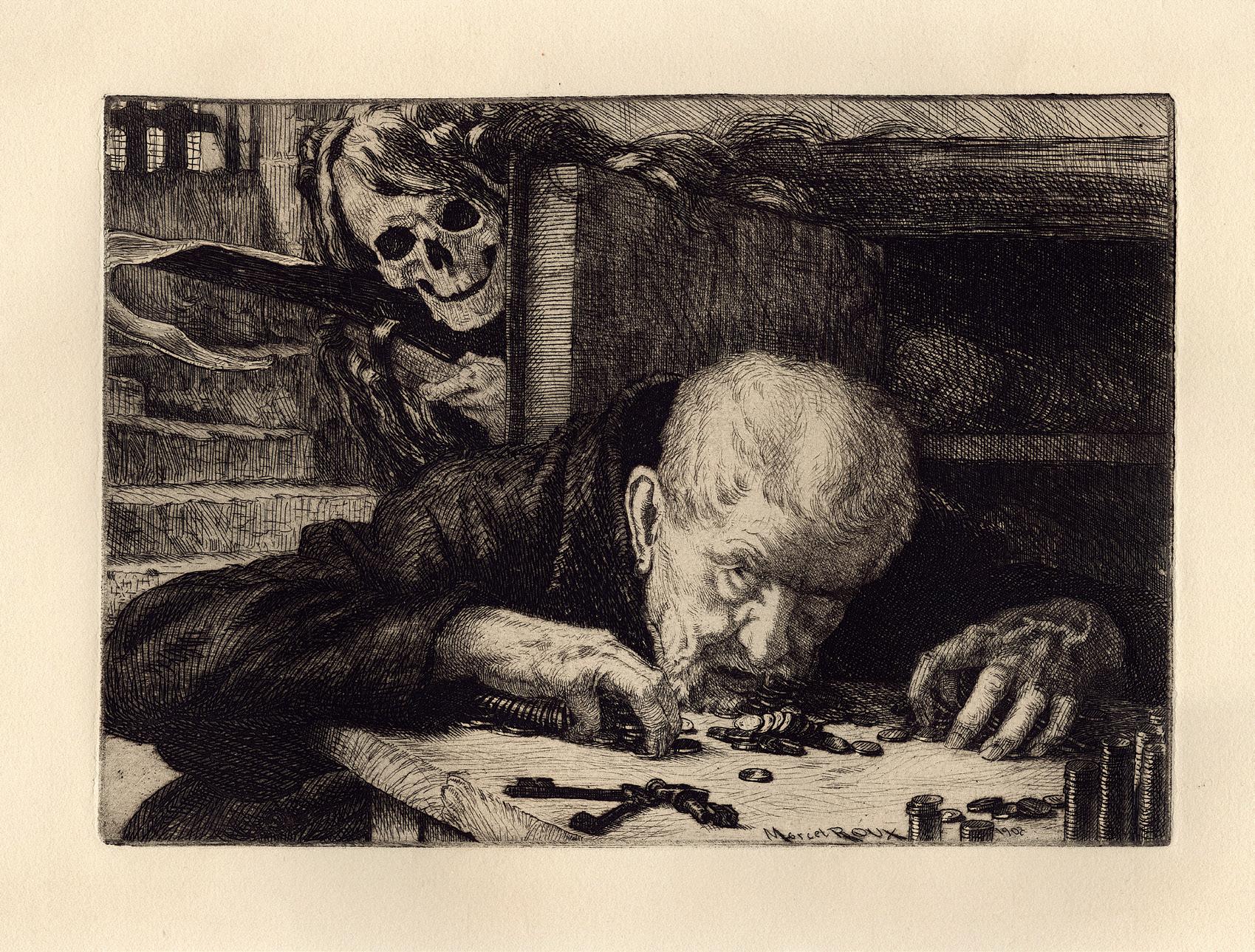
91
43 Léon Spilliaert 1881 Ostend – Brussels 1946
Self-Portrait with Verhaeren and Deman
Drypoint with etching on wove paper, 1908
Numbered, signed and dated in pencil on the lower margin 1 / Leon Spilliaert 1908
Plate 120 x 160 mm
Reference Xavier Tricot, Catalogue raisonné des estampes, Pandora, Antwerp, 2018, cat.3, p. 68 (state 1 of 2)
Exhibition Gent, MSK, Emile Verhaeren, 2016, cat. 1 (ill.)
Provenance Private collection, Belgium
This is one of Léon Spilliaert’s earliest and most important prints. The Belgian artist had just begun his career when he printed this self-portrait flanked by two persons who were key to his artistic development. On his left he portrays Edmond Deman, a renowned editor who offered Spilliaert his first commission as an artist. Deman specialized in publishing books illustrated by artists of his time, such as Fernand Khnopff or Odilon Redon. In 1902 hired the young Spilliaert as an illustrator, introducing him to his extensive network within artistic circles. The other figure represented in this print is Emile Verhaeren, the famous Belgian writer who inspired Spilliaert through his symbolist poems. We see Verhaeren’s profile on the right, and part of his face in the center of the sheet as well. The respected poet and the artist built a friendship that lasted until Verhaeren’s death in 1918. Like Deman, Verhaeren played a paternal role in the artist’s early years. This composition is thus significant for Spilliaert, showing himself surrounded by his guides and mentors.
Spilliaert is well-known for his self-portraits, in which his eyes tend to disappear into the shadow of his eyebrow arches, fostering a ghostly representation. He produced some of his most striking self-portraits in 1908, the same year as the present print, many of which have contributed to his current fame. This print, however, is the only self-portrait that the artist ever etched. Only five impressions of are known today: one in the KBR (Royal Library of Belgium); one in the Muzee Ostende; one in a private collection dedicated to Mrs Klompers; one exhibited in London (2020) by the NY Art Gallery; and the one presented here. There seems to have been two states of this print; the second state (such as the one in Ostende and the one presented in London) bears an extra curve in the upper left corner, as well as a few lines on the lower margin going over the bevel. Our impression, with clean outlined edges, is a first state, such as the one at the KBR. Extremely rare, this print is an iconic representation of Spilliaert and his earliest inspirations.
92
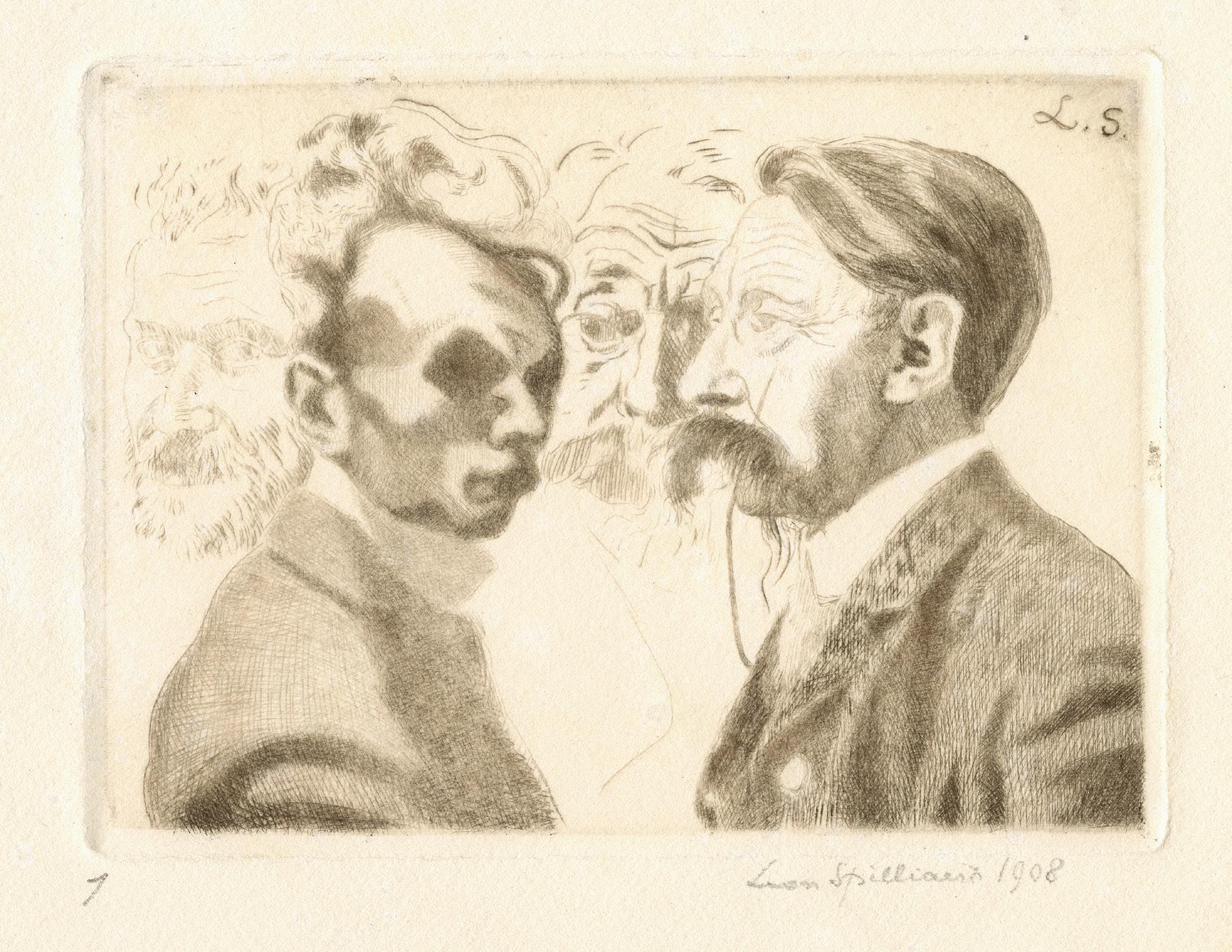
93
44 Felix Vallotton 1865 Lausanne – Paris 1925
C’est la Guerre !
Woodcuts on Japan paper, 1915-1916
All sheets numbered lower left 3/10, and signed lower right fVallotton
In the original portfolio, titled and signed (printed), with red-drops-of-blood-like made by the artist
Images 177 x 224 mm
Reference Vallotton 212a-217a of b
Provenance Paul Desmarais, Paris (acquired directly from the artist); Private collection, France Condition In very fine condition. The portfolio is paper-covered board with cloth tape
The present work is an exceptional complete set of Felix Vallotton’s famous series C’est la Guerre !, printed on grand Japan paper and numbered 3/10. Published and sold by the artist himself in the winter of 1916-17, the series was issued in a cream-coloured cardboard cover with black linen edges and splashed by his hand in red ink. The portfolio (45 x 54 cm) contains impressions fixed on a double slip-in mount (25 x 33 cm). Two pages of his notebook list the purchasers’ names beside the corresponding number; this set was bought by Paul Desmarais. Desmarais was a businessman in oil refining who in 1892 married Léonie Natanson, the daughter of Syzmon. Leonie’s brother Stefan and her cousin, Thadée Natanson, were very close to Vallotton; this is surely how Desmarais knew the artist. He was an active collector and owned works by other Nabis, including Vuillard.
“August 1st. General mobilisation order! So it’s all over and France is going to play its great game. What a day, what gasps, until the poster appeared; I couldn’t take my eyes off it, it was all so clear, so formal, so inescapable, so imperious!” wrote Félix Vallotton in his diary in 1914. Over two years later, in December 1916, Vallotton wrote: “The war goes on, trenches are taken and lost, and men are lost without anything very definite being decided.”
The artist wanted to be put on active service but was refused because of his age. Impatient and depressed, he watched helplessly as the conflict flared up and even abandoned his studio for several months. At the outset of the war and throughout its duration, many artists asked themselves: how to represent the unthinkable, how to make art against such calamity? Does art retain any meaning in the face of such violence? Vallotton was no exception; in his work, this theme took precedence over his previous concern, the enduring conflict between men
and women. Campaigning for France’s victory, the artist published six woodcuts in 1916, snapshots of a conflict he knew only from the press, newsreels, and a few eyewitness accounts. C’est la Guerre ! conveys Vallotton’s anger and revulsion in the face of an unjust and unbearable event. Simultaneously fascinated and horrified, he depicted the ruins of modern warfare and the prevailing “hatred of the Boche” communicated by official propaganda at the time. One plate depicts soldiers lying dead on barbed wire, just steps from their own trenches. Others illuminate the suffering of the civilian population; orgies and rapes; the savagery of the enemy.
Woodcut printing requires simplification: all forms are constructed through the binary contrasts of black and white, without tonal nuance. Vallotton wielded these limitations ingeniously to construct evocative representations of a conflict he couldn’t himself witness. Daggers gleam in pitch-dark shadows, held aloft between enemies who can barely see each other; harsh landscapes of the front convey deafening explosions and the suggestion of ever-present death. Yet strikingly, in the face of such horror, Vallotton remains faithful to the pure aesthetics of representation. In any event, despite the sale of the ten large albums to subscribers, the smaller-size edition, on white wove paper, did not sell well, and Vallotton faced financial difficulties, which he complained about to his brother Paul in 1916.
In 1917, at the initiative of the Secretariat aux Beaux-Arts and the Ministère des Forces Armées, Vallotton volunteered and was finally able to go to the theatre of operations. This led to the creation of a dozen paintings on the subject, but also to a certain conviction: that the representation of war can only succeed by removed meditation. As he wrote: “the idea of war is an inner idea.”
94
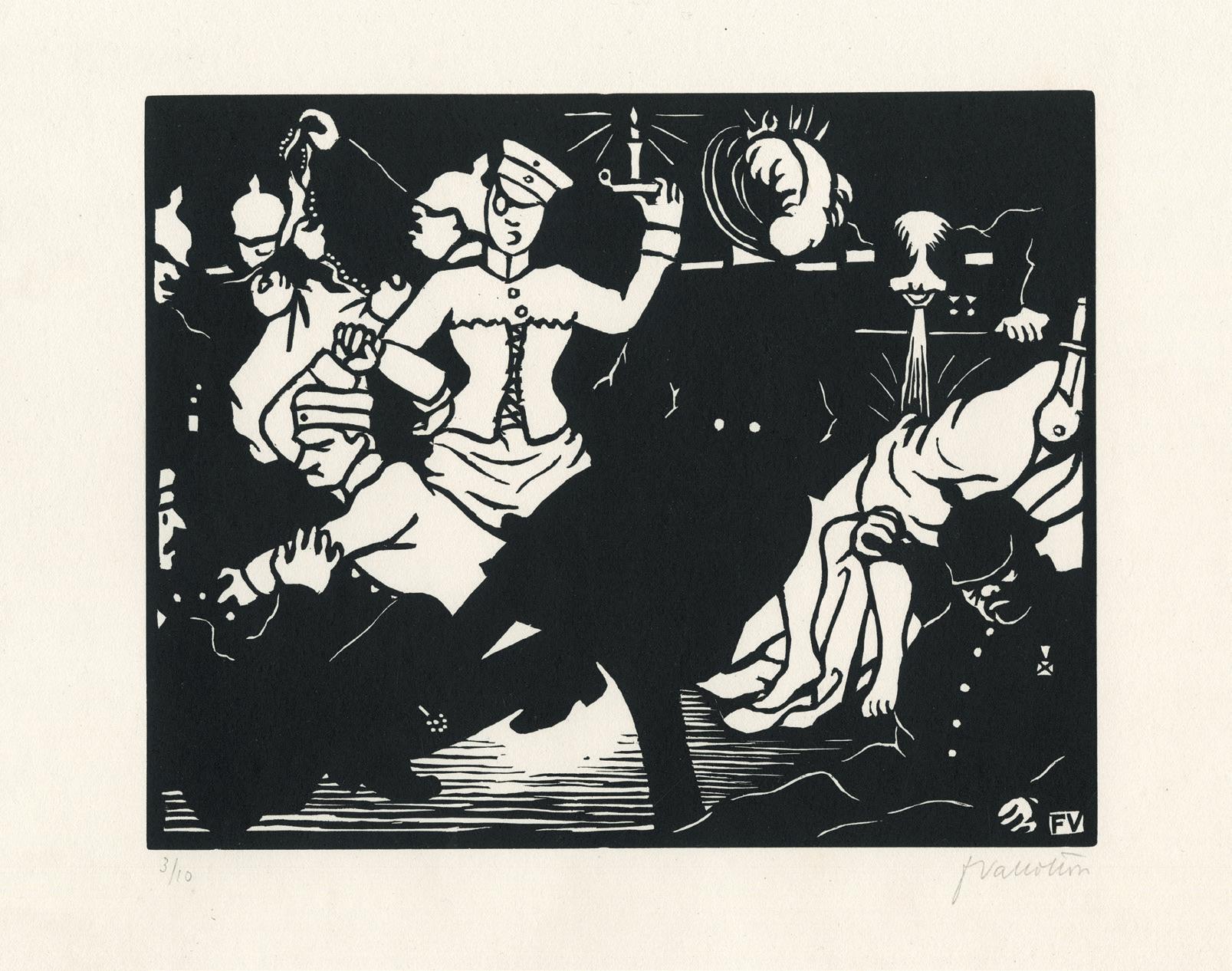
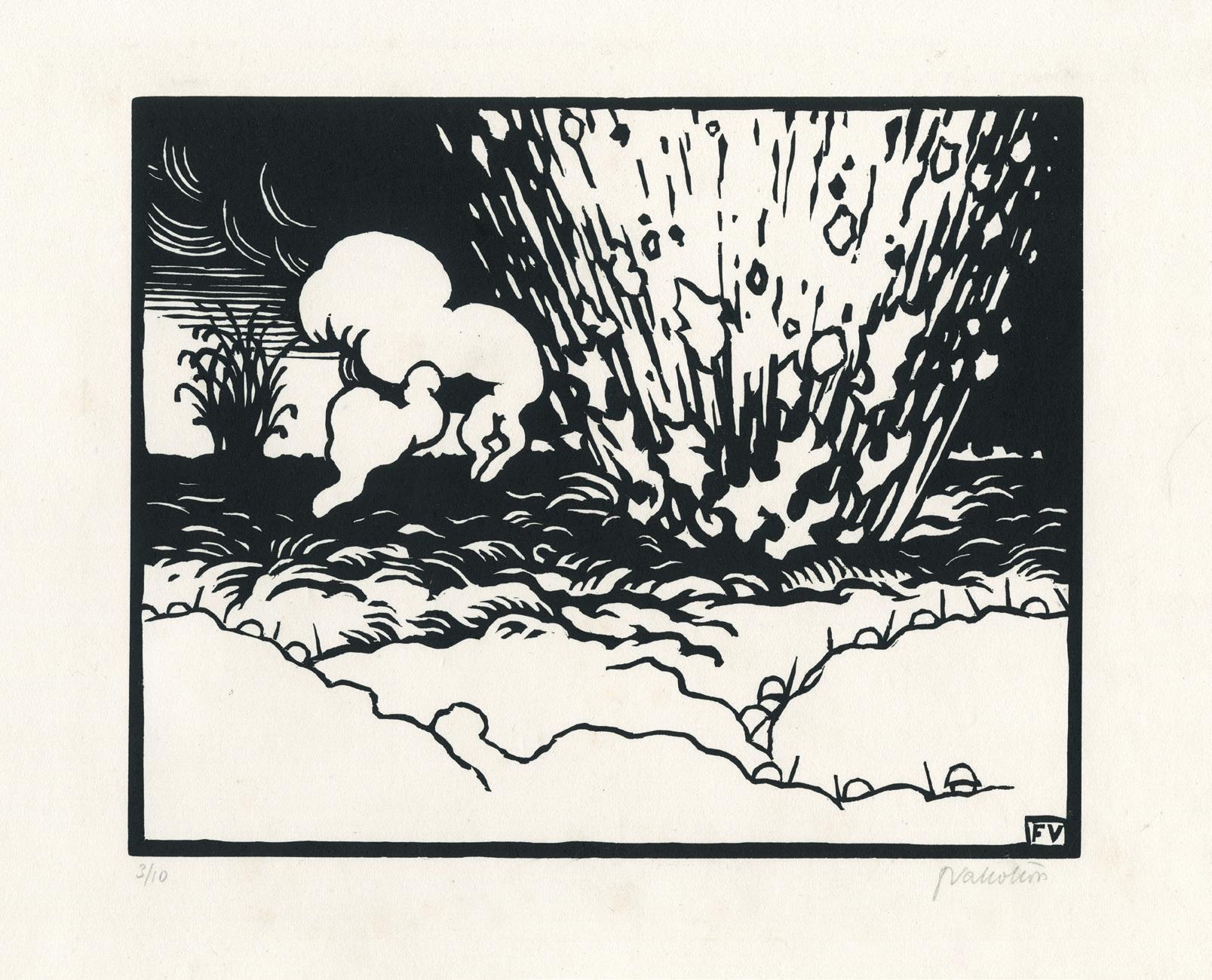
95
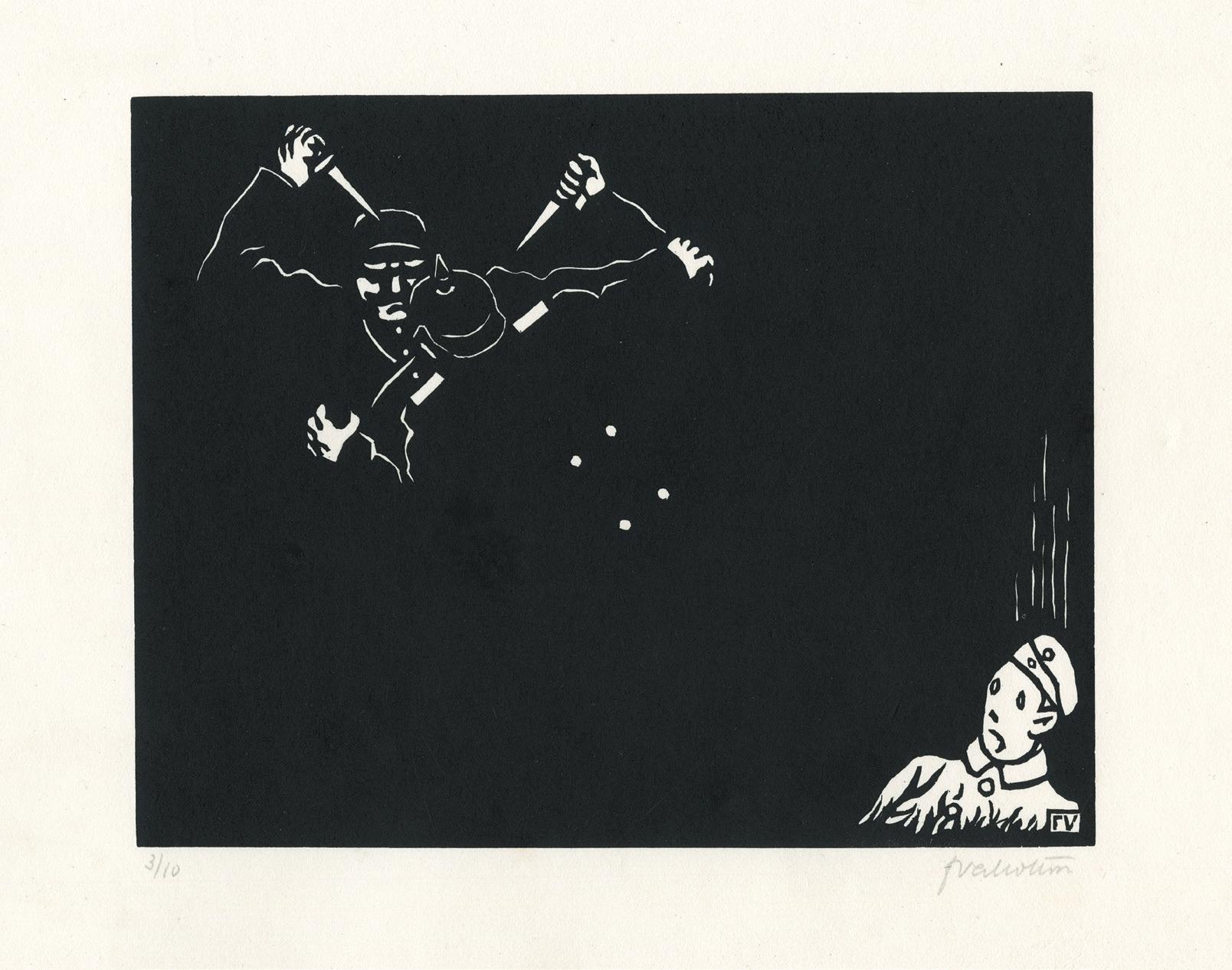
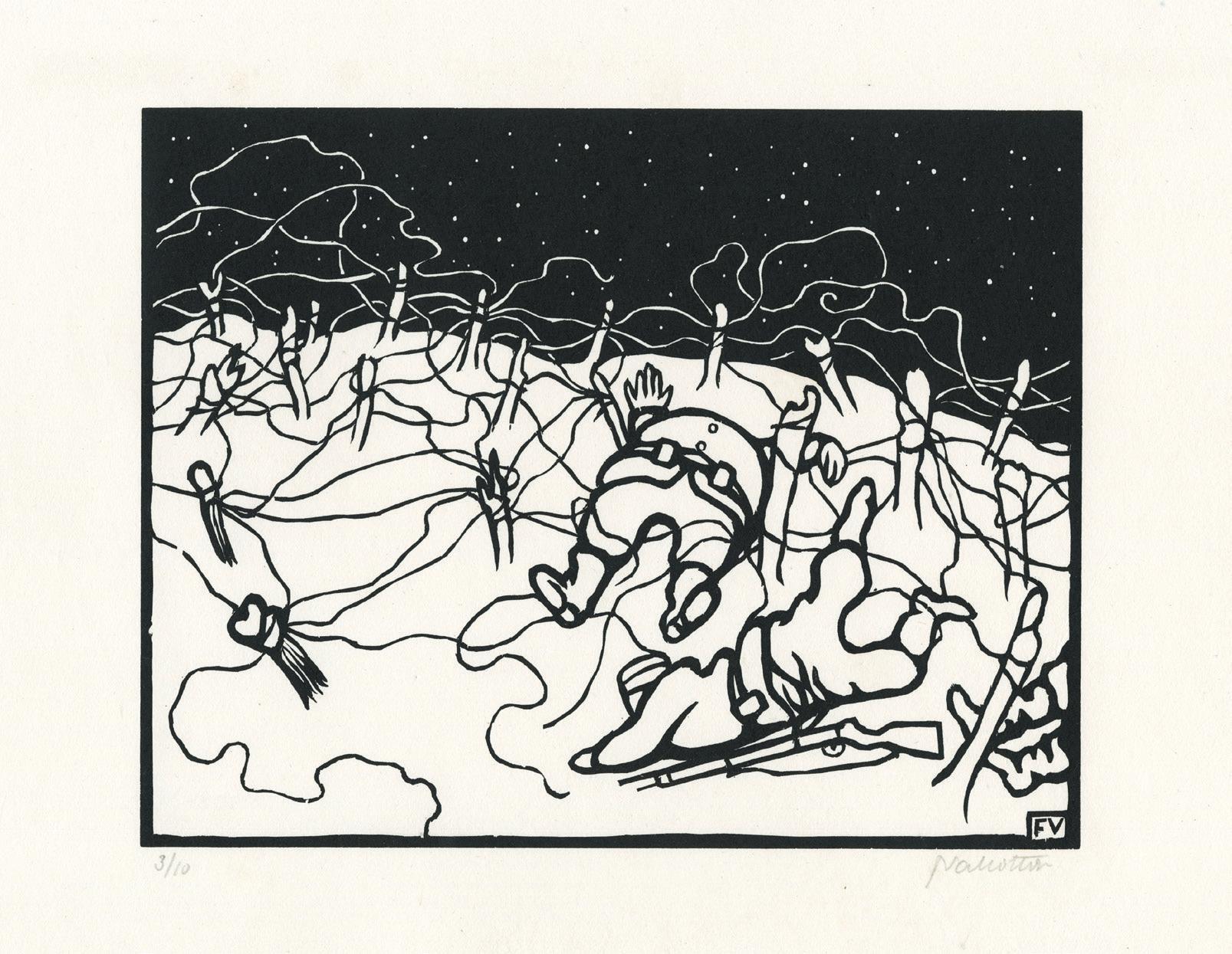
96
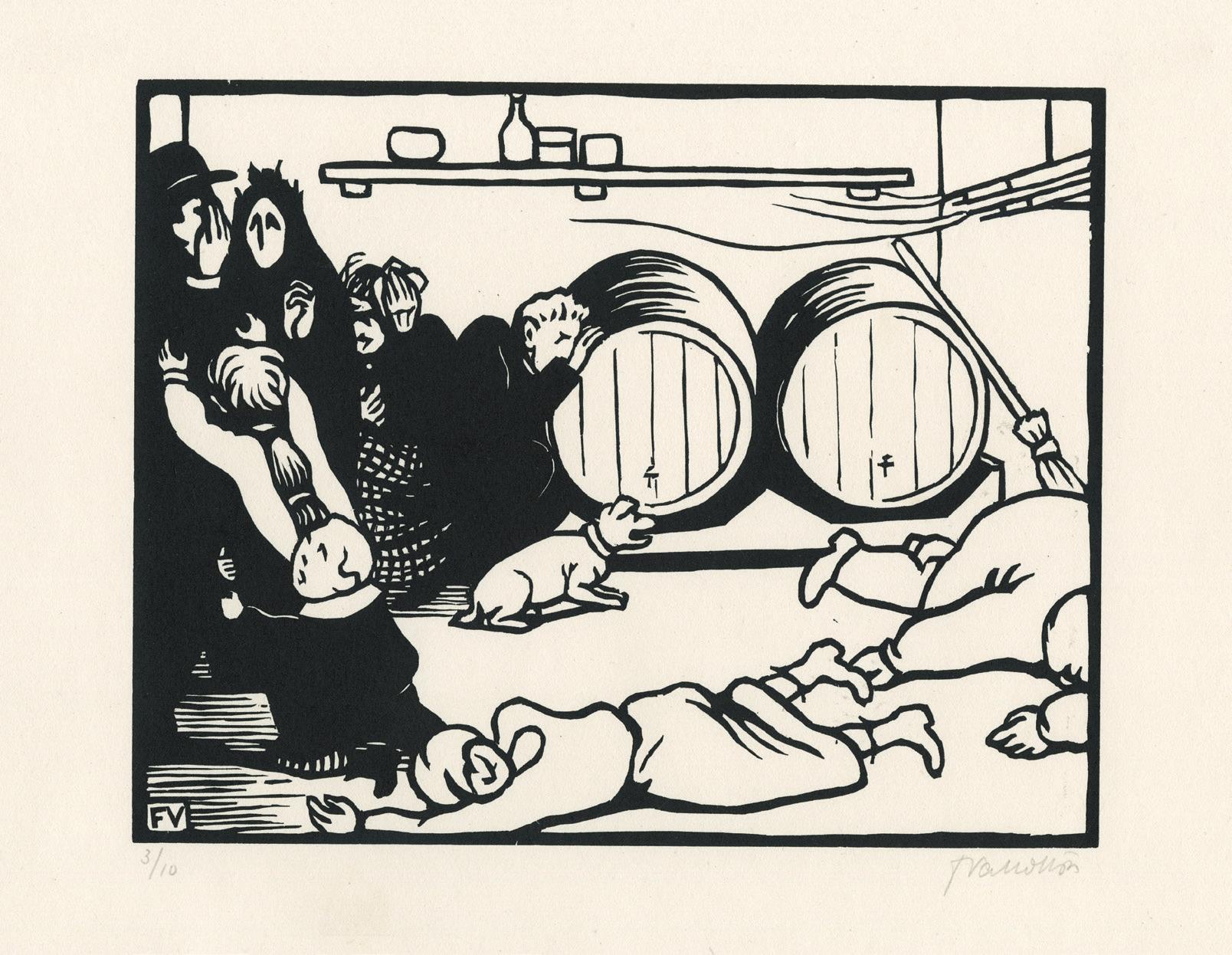
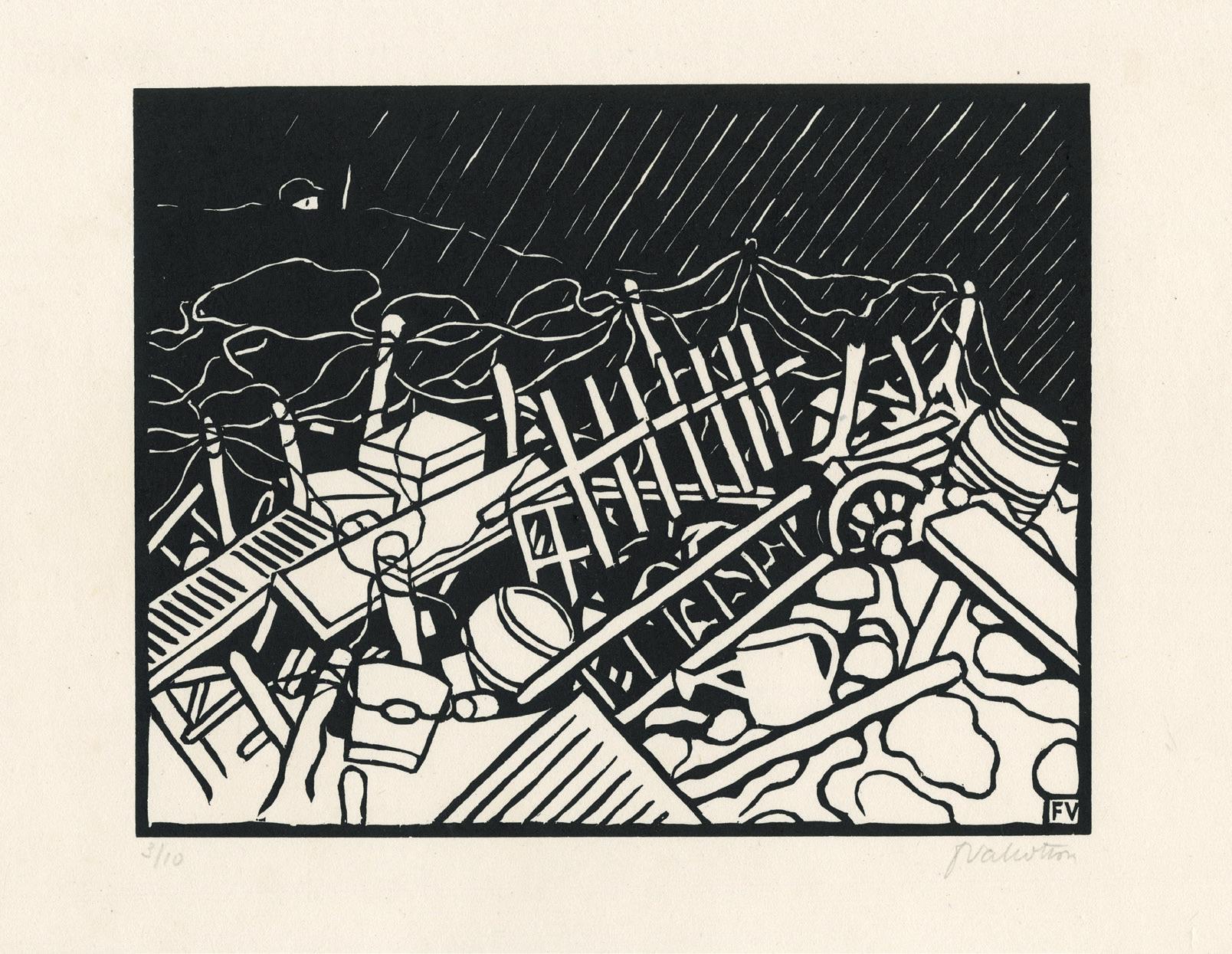
97
45 Laszlo Moholy-Nagy 1895 Bácsborsód – Chicago 1946
Komposition
Woodcut on wove paper, 1922
Signed and dated in pencil lower right Moholy=Nagy 1922
Image 158 x 120 mm
Provenance Jacques Perier, Paris Condition In very good condition
The present two pieces are examples of the rare, abstract woodcuts created by Laszlo Moholy-Nagy in 1922, in Berlin, just before his Bauhaus period. Related to his assemblage reliefs and free-standing constructions, those works on paper mark the transition from Moholy-Nagy’s own Dada creations to his emergent International Constructivism, which were clearly architectonic and very unlike the post-Cubist abstractions then prevalent among German modern artists. In their radical lack of traditional depiction and spatial illusion, they constitute a kind of manifesto of the movement that would come to characterize Moholy-Nagy’s œuvre. Because they work exclusively with black ink against a light ground, Moholy-Nagy’s graphic prints in this vein were focused on the dynamic balance of architectonic forms. The artist succeeded in communicating a sense of transparency through the application of complex, varied textures. The results are impressive, particularly when one considers that Moholy-Nagy was self-taught in this medium.
In 1920, the young constructivist left Hungary and arrived in Berlin to discover the rich avant-garde scene of the German capital. He soon met Herwarth Walden, one of the most important promoters of the German avant-garde and the founder of Der Sturm magazine, and he fell into Walden’s circle surrounding the associated Galerie Der Sturm. Moholy-Nagy exhibited at the Galerie for the first time in February 1922 and presented his work regularly until 1925. The circle surrounding Der Sturm was at the time a hotbed of radical new aesthetic movements in Berlin, from Expressionism and Cubism to Dada and Surrealism. Situating himself in the midst of this dynamic environment, Moholy-Nagy experimented with new techniques such as printmaking and, later,
photography. It is during one of his shows at De Sturm that Walter Gropius discovered Moholy-Nagy’s work and invited him to join his team at the Bauhaus in Weimar in 1923.
Nevertheless, from 1922 to 1924 Moholy-Nagy continued publishing in Der Sturm magazine, showing linocuts and woodcuts, either within its pages or on the cover. In 1923, following other constructivist artists, he and the avant-garde publisher Ludwig Ey issued a portfolio of six prints, entitled Konstruktionen; Kestenermappe 6 , and it was around this time that Moholy-Nagy produced most of his graphic works, which are now renowned and rare. Unfortunately, we know virtually nothing about when and where these prints were actually published, which edition they are, how many impressions there were, whether with signature or no, etc. The present woodcuts are signed by the artist in pencil, with no letters; like most linocuts and woodcuts that were signed in this manner, they are probably part of a small tirage.
Der Sturm was Moholy-Nagy’s main channel to public recognition, but in the same period the artist habitually contributed to one of the other most important magazines of the time: the Belgian Het Overzicht, published between 1921 and 1925. In 1922, the abstract artist Jozef Peeters became its new editor and travelled to Berlin the same year, where he met Moholy-Nagy. The Hungarian artist soon published a few prints in Het Overzicht, and so increased his position in the European avant-garde. The first composition here, dated 1922, was published in issue 17, September 1923, of the renowned journal, with “Moholy Nagy” printed under the image.
98
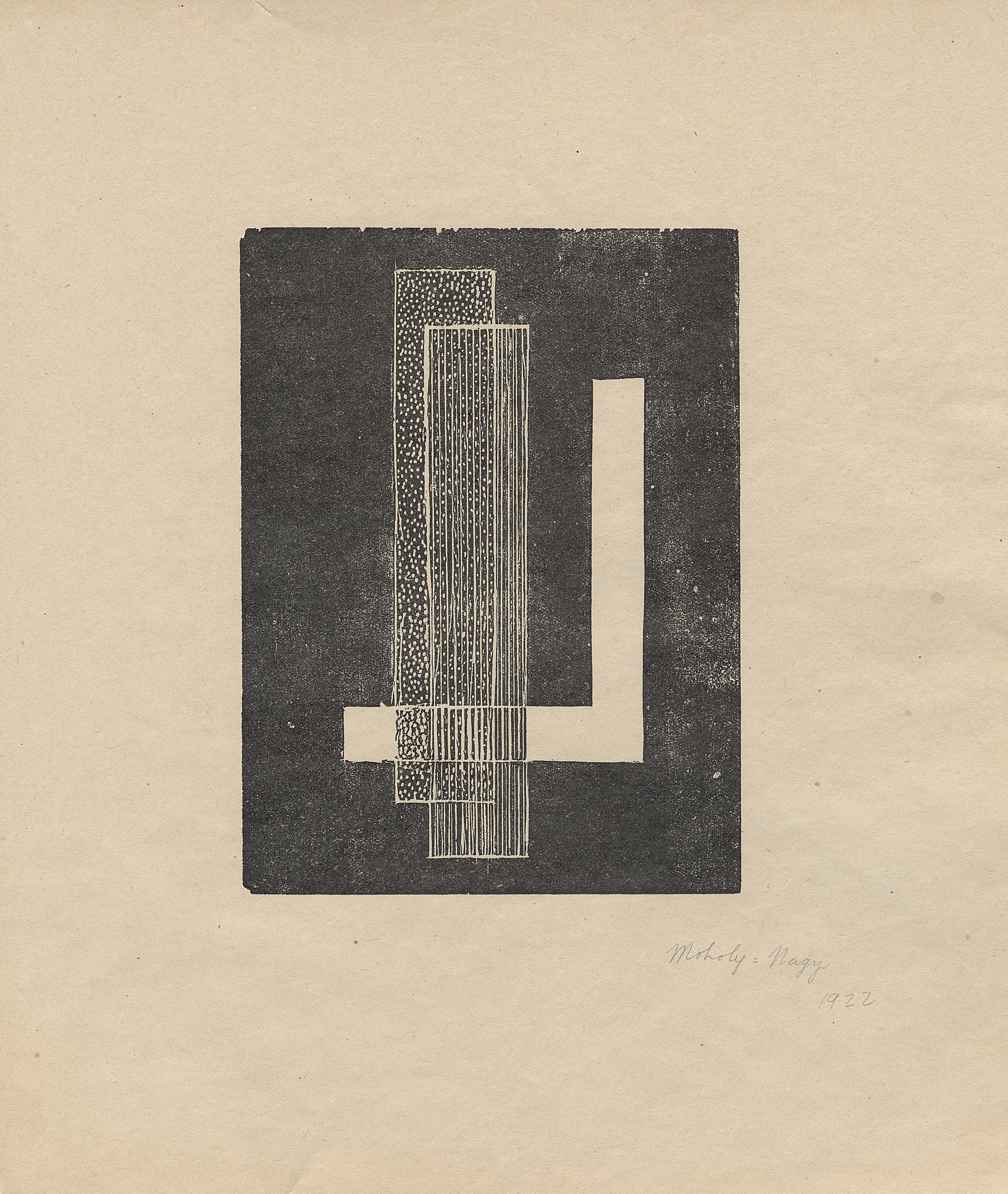
99
46
Laszlo Moholy-Nagy 1895 Bácsborsód – Chicago 1946
Komposition
Woodcut on wove paper, ca. 1922-23
Signed in pencil lower right Moholy . Nagy
Image 148 x 150 mm
Provenance Private collection, France
Condition In good condition
100
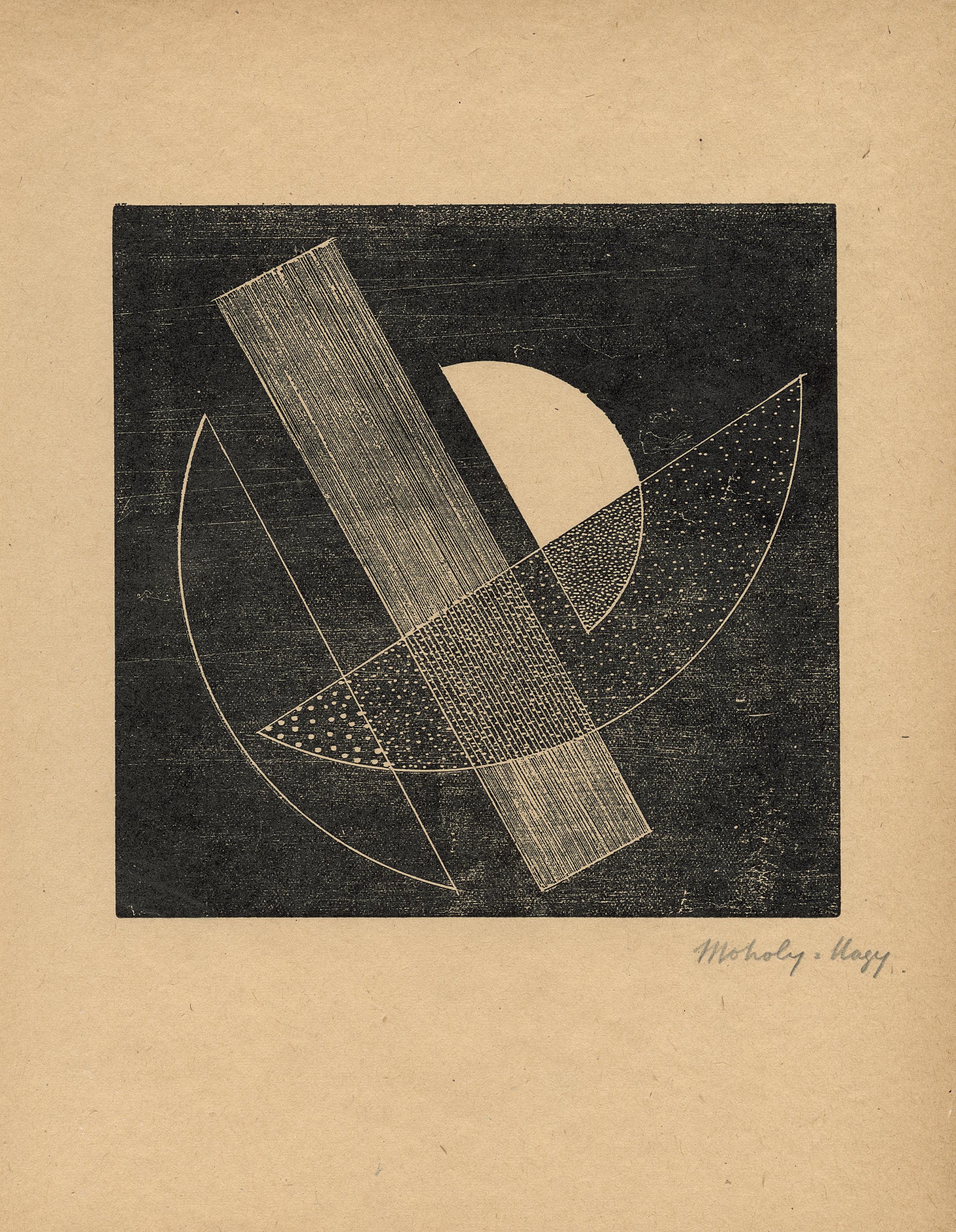
101
47 Max Ernst 1891 Brühl – Paris 1976
Etching and aquatint on wove paper, 1950
Numbered lower left 24/30, and signed lower right max ernst
Plate 237 x 177 mm
Reference Werner Spied and Helmut R Leppien, Max Ernst. Œuvre – Katalog. Das Graphische Werk, Houston, Menil Foundation, Köln, Verlag DuMont Schauberg, 1975, no. 37B, only state
Provenance Private collection, France
Condition In pristine condition
On Max Ernst, Jean Adhémar wrote in his preface to the catalogue of the exhibition at the Bibliothèque national de France in 1975 that “He possesses to the highest degree the art of disconcerting with his sense of the fantastic, his humour, his poetic instinct […] He is an exceptionally imaginative inventor of form.”
This plate was printed in Paris by Georges Visat, and it was published by Marcel Zerbib. Both were instrumental figures to Ernst and his printmaking.
Visat met Ernst and Dorothea Tanning in 1949. He soon became Ernst‘s printer, helping him to perfect his etching ability and introducing him to aquatint. The present print is the first result of their collaborative efforts in these methods.
This work is actually a rather rare print. We have been able to locate only two other impressions on the market in the last fifteen years.
102
Figure
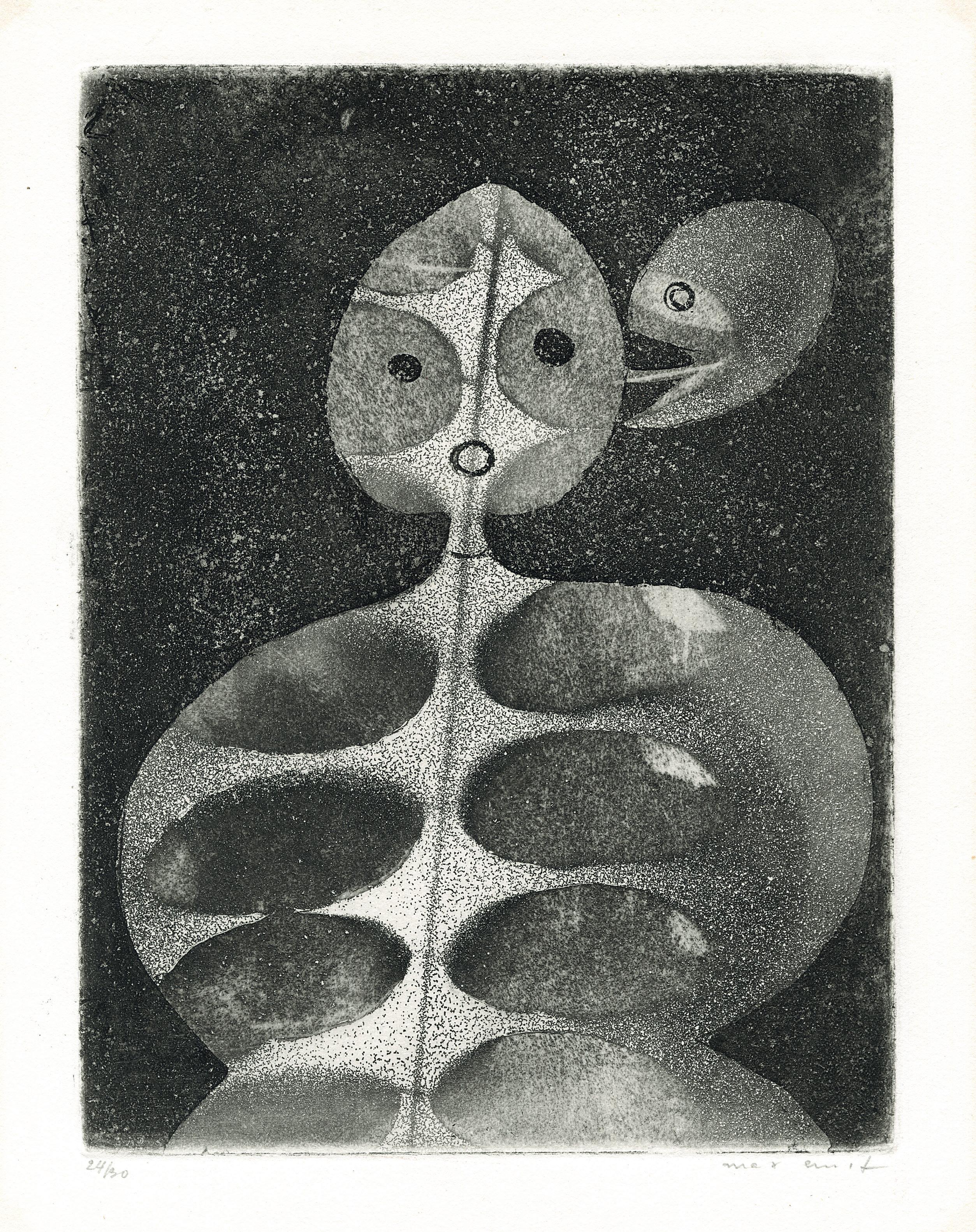
103
Eric Gillis, Noémie Goldman, Rhonda Sherwood, Andrew Shea & Jean-Marie Gillis
Special thanks to (by alphabetical order) Melissa Hughes and her team, Dominique Lejeune and to all of those who have contributed to the publication of this catalogue.
Catalogue entries Eric Gillis Noémie Goldman Design Tia Džamonja Translation/Editing
Scan Jérôme
Allard – Numérisart
© Agnews – October 2023 BOYVIN 18 CARAGLIO 12 CARTARO 20 CASSATT 70 COURBET 64 DAUMIER 58 DE BRUYN 24 DE GHEYN III 26 DE GOYA Y LUCIENTES 46 DE RIBERA 28 DEGAS 60, 62 DÜRER 6, 10 ERNST 102 EVENEPOEL 78 FANTIN-LATOUR 66 GAUGUIN 86 GOLTZIUS 22 GUÉRARD 72 HOLLAR 32 ILSTED 82 JUSTE DE JUSTE 16 LUTMA THE YOUNGER 42 MANET 56 MOHOLY-NAGY 98, 100 PERELLE 44 PISSARRO 68 POSSENTI 30 QUÉNEDEY 52 REMBRANDT 34, 36, 38, 40 ROHDE 76 ROUX 88 SCULTORI 14 SPILLIAERT 92 VALLOTTON 74, 94 VAN HOYTEMA 80 VAN LEYDEN 8 VILLENEUVE 50 VILLON 84 VON BARTSCH 48 WHISTLER 54
Index of works
www.agnewsgallery.com London 6 St. James’s Place, London, SW1A 1NP anna@agnewsgallery.com Brussels 1 rue aux Laines, 1000 Brussels noemie@agnewsgallery.com


























































